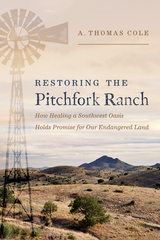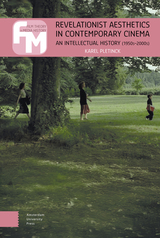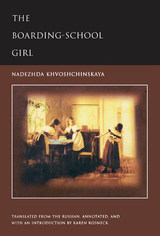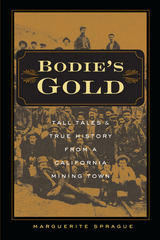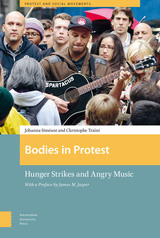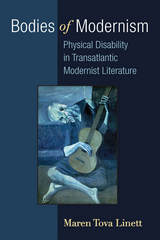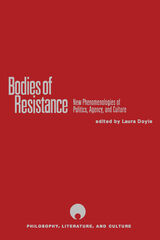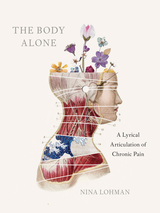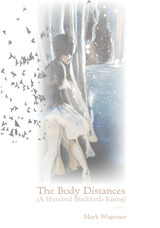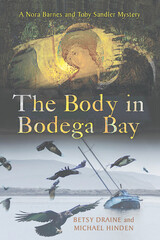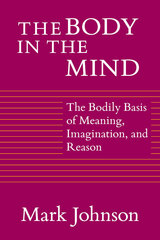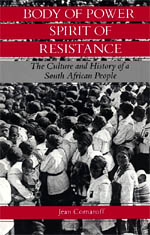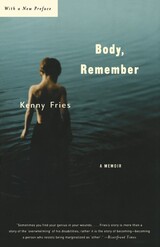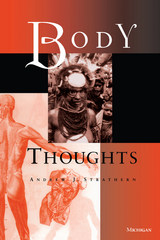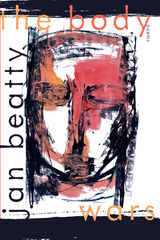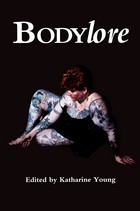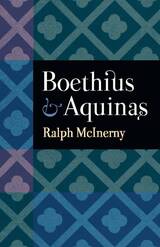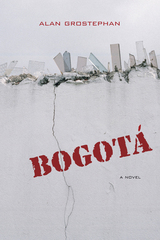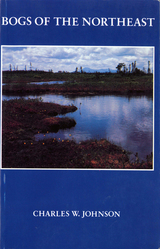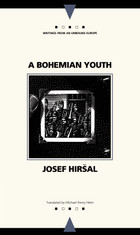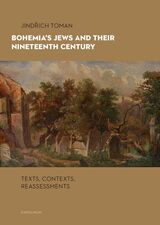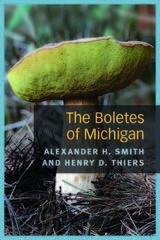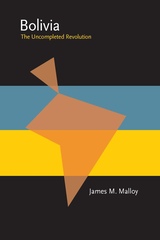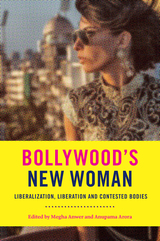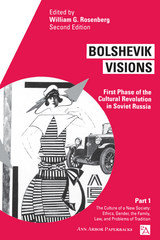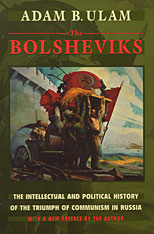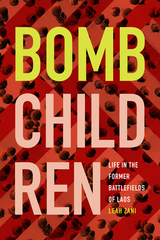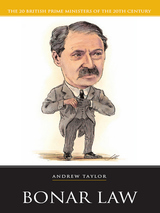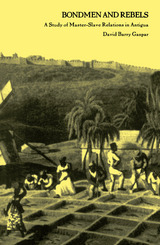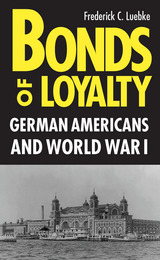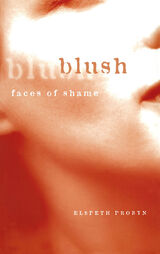 Blush: Faces of Shame
Elspeth Probyn
University of Minnesota Press, 2005 With the rise of pride - national pride, gay pride, black pride, fat pride - shame, the "sickness of the soul," has acquired a bad reputation. While the repudiation of some forms and consequences of societal shame are undoubtedly necessary, Elspeth Probyn contends that this emotion is a powerful resource in rethinking who we are and who we want to be. When we blush, we are driven to question what we value about ourselves and why. Blush argues that we are all born with a capacity for shame, much as we are born with the capacity for anger or pride, and that shame, like these other emotions, can be good for us and reveal the good in us. Painfully introspective, shame demands that we question our actions and our relationship to others. Shame's physical manifestation - the blush - gives us away, connecting us to our humanity. What shames us says a great deal about our character as individuals and as a society, about our past and our desires for the future. Written in an engaging and personal style, Blush combines psychology and cultural criticism, sociology and popular science, to present a unique perspective on debates about the ethics and emotion of identity.
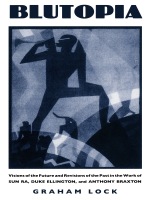 Blutopia: Visions of the Future and Revisions of the Past in the Work of Sun Ra, Duke Ellington, and Anthony Braxton
Graham Lock
Duke University Press, 2000 In Blutopia Graham Lock studies the music and thought of three pioneering twentieth-century musicians: Sun Ra, Duke Ellington, and Anthony Braxton. Providing an alternative to previous analyses of their work, Lock shows how these distinctive artists were each influenced by a common musical and spiritual heritage and participated in self-conscious efforts to create a utopian vision of the future.
A century after Ellington’s birth, Lock reassesses his use of music as a form of black history and compares the different approaches of Ra, a band leader who focused on the future and cosmology, and Braxton, a contemporary composer whose work creates its own elaborate mythology. Arguing that the majority of writing on black music and musicians has—even if inadvertently—incorporated racial stereotypes, he explains how each artist reacted to criticism and sought to break free of categorical confines. Drawing on social history, musicology, biography, cultural theory, and, most of all, statements by the musicians themselves, Lock writes of their influential work.
Blutopia will be a welcome contribution to the literature on twentieth-century African American music and creativity. It will interest students of jazz, American music, African American studies, American culture, and cultural studies.
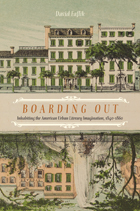 Boarding Out: Inhabiting the American Urban Literary Imagination, 1840-1860
David Faflik
Northwestern University Press, 2012 Driven by intensive industrialization and urbanization, the nineteenth century saw radical transformations in every facet of life in the United States. Immigrants and rural Americans poured into the nation’s cities, often ahead of or without their families. As city dwellers adapted to the new metropolis, boarding out became, for a few short decades, the most popular form of urban domesticity in the United States.While boarding’s historical importance is indisputable, its role in the period’s literary production has been overlooked. In Boarding Out, David Faflik argues that the urban American boardinghouse exerted a decisive shaping power on the period’s writers and writings. Addressing the works of canonical authors such as Henry David Thoreau, Nathaniel Hawthorne, and Oliver Wendell Holmes, as well as neglected popular writers of the era such as Fanny Fern and George Lippard, Faflik demonstrates that boarding was at once psychically, artistically, and materially central in the making of our shared American culture.
The Boarding-School Girl
Nadezhda Khvoshchinskaya
Northwestern University Press, 2000 This tale of a young woman's not-so-sentimental education is the story of fifteen-year-old Lolenka, who encounters an exiled radical named Veretitsyn and begins to question her education and life. Under his influence, Lolenka breaks with tradition and embarks upon a new life as a translator and an artist, but a chance meeting with Veretitsyn years later leads to a sobering reappraisal of her mentor's convictions.
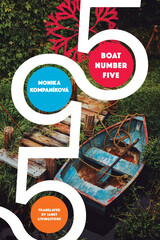 Boat Number Five
Monika Kompaníková
Seagull Books, 2021 The moving yet humorous story of a girl struggling to care for herself and others in post-communist Slovakia.
Emotionally neglected by her immature, promiscuous mother and made to care for her cantankerous dying grandmother, twelve-year-old Jarka is left to fend for herself in the social vacuum of a post-communist concrete apartment-block jungle in Bratislava, Slovakia. She spends her days roaming the streets and daydreaming in the only place she feels safe: a small garden inherited from her grandfather. One day, on her way to the garden, she stops at a suburban railway station and impulsively abducts twin babies. Jarka teeters on the edge of disaster, and while struggling to care for the babies, she discovers herself. With a vivid and unapologetic eye, Monika Kompaníková captures the universal quest for genuine human relationships amid the emptiness and ache of post-communist Europe. Boat Number Five, which was adapted into an award-winning Slovak film, is the first of two books that launch Seagull’s much-anticipated Slovak List.
 Boat of Letters
Eve Grubin
Four Way Books, 2025
In her much anticipated second full-length collection of poems, Eve Grubin conjures an "inky swamp, wild and warm, / where leaves hang down like muted lamps." Grubin navigates wild waters in a "boat of letters" she constructs, with poems narrating a daughter in mourning for her mother in adulthood's half-light; a wife in the middle of life's existential marathon; a mother raising two children in the terrifying present; an American living in London; a Jewish woman following religious tradition in what can feel like a faithless world. Grubin shapes language and silences into a bridge that holds us between longing and understanding, between effort and the holy ground of that unattainable destination. "The Poetics of Reticence" describes hovering above the waters where "there is no vessel; there are no oars," just the "sounds of a boat creaking," a material contradiction in the hushed void. "Silence is praise: words cannot touch glory," Grubin writes, but she also demonstrates what wonders our speech makes possible. In one poem, the narrator looks back at her wedding and considers how little she knew about marriage, and thinking in the context of her husband's area of expertise, palaeography, she reflects, "I didn't know that when two graphemes join / in a single glyph there is potential for stylistic re-imaginings, / for inventive, elegant variations." All is preordained, she seems to say, while paradoxically, we re-imagine and invent. And even as we create our future, we embrace the beauty of all that we cannot know: "Yesterday, we talked about the shade / of a certain blue mentioned in the Torah. / Was it the blue of our son's lips after a bath? // Or the blue of redemption? // Or the dark blue of the sky / the night we walked across the sands, the seas all around us."
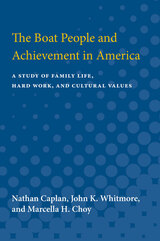 Boat People and Achievement in America: A Study of Family Life, Hard Work, and Cultural Values
Nathan Caplan, John K. Whitmore, and Marcella H. Choy
University of Michigan Press, 1989 During the late 1970s hundreds of thousands of people from Vietnam, Cambodia, and Laos began their flight out of their homelands. Most left by sea. In emigrating to the United States, these Boat People faced extraordinary cultural, material, and psychological obstacles. In the face of these impediments to success, their rapid economic and educational achievements provide one of the most intriguing success stories of our time. In The Boat People and Achievement in America, Caplan, Whitmore, and Choy report on five years of research on the Indochinese Boat People. Two rounds of surveys conducted in Seattle, Orange County, Chicago, Houston, and Boston provide the empirical basis of this study. The cultural values, family milieu, and psychological characteristics that account for the successes of the Boat People in this country are examined. Extensive quotations from the refugees themselves provide personal insights into their backgrounds and resettlement experiences, and add an important anthropological dimension to the study. Their findings have implications for the whole question of achievement in America.
Boat: Poems
Christopher Merrill
Tupelo Press, 2013 Like Neruda and Paz, Perse and Milosz, Christopher Merrill is both a writer and a cultural envoy, crisscrossing the globe as chronicler and courier. Boat records a series of passages over a decade, employing varied formal strategies: meditations and fantasias, prose poems and versets, lyric sequences and narratives, translations and ghazals. Composed in war zones and embassies, refugee camps and monasteries, Boat is a logbook tracking questions of memory, the body and body politic, faith, mortality, and the ways of knowledge moves through generations. Reflecting ten years of life on the wing and forty years of writing, including extensive translation from other languages, Boat bears witness to what Merrill has heard and seen in places most Americans will never visit.
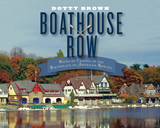 Boathouse Row: Waves of Change in the Birthplace of American Rowing
Dotty Brown
Temple University Press, 2016 The history of Philadelphia’s Boathouse Row is both wide and deep.Dotty Brown, an avid rower and former editor at the Philadelphia Inquirer, immersed herself in boathouse archives to provide a comprehensive history of rowing in Philadelphia. She takes readers behind the scenes to recount the era when rowing was the spectator sport of its time—and the subject of Thomas Eakins’ early artwork—through the heyday of the famed Kelly dynasty, and the fight for women to get the right to row. (Yes, it really was a fight, and it took generations to win.) With more than 160 photographs, a third of them in full color, Boathouse Row chronicles the “waves of change” as various groups of different races, classes, and genders fought for access to water and the sport. Chapters also discuss the architectural one-upmanship that defined Boathouse Row after Frank Furness designed the stunning and eclectic Undine Barge Club, and the regattas that continue to take place today on the Schuylkill River, including the forgotten forces that propelled high school rowing. Beautifully written and illustrated, Boathouse Row will be a keepsake for rowers and spectators alike.
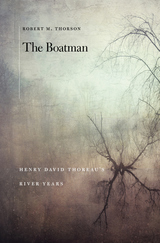 The Boatman: Henry David Thoreau’s River Years
Robert M. Thorson
Harvard University Press, 2017 As a backyard naturalist and river enthusiast, Henry David Thoreau was keenly aware of the many ways in which humans had altered the waterways and meadows of his beloved Concord River Valley. A land surveyor by trade, he recognized that he was as complicit in these transformations as the bankers, builders, and elected officials who were his clients. The Boatman reveals the depth of his knowledge about the river as it elegantly chronicles his move from anger to lament to acceptance of how humans had changed a place he cherished even more than Walden Pond.
“A scrupulous account of the environment Thoreau loved most… Thorson argues convincingly—sometimes beautifully—that Thoreau’s thinking and writing were integrally connected to paddling and sailing.”
—Wall Street Journal
“An in-depth account of Thoreau’s lifelong love of boats, his skill as a navigator, his intimate knowledge of the waterways around Concord, and his extensive survey of the Concord River.”
—Robert Pogue Harrison, New York Review of Books
“An impressive feat of empirical research…an important contribution to the scholarship on Thoreau as natural scientist.”
—Los Angeles Review of Books
“The Boatman presents a whole new Thoreau—the river rat. This is not just groundbreaking, but fun.”
—David Gessner, author of All the Wild That Remains
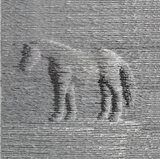 Boaz Vaadia: Sculpture
Wendy Steiner
The Artist Book Foundation, 2016 Boaz Vaadia (1951–2017), the internationally acclaimed sculptor, amassed a prodigious body of work over his 40-year artistic career. With Boaz Vaadia: Sculpture, Grounds For Sculpture in Hamilton, New Jersey, presented the first retrospective exhibition of his indoor and outdoor works in 2016 in a comprehensive survey of the artist’s journey from abstraction to figuration. Detailing 125 works installed in two buildings and throughout the 42-acre sculpture park, the exhibition’s color catalogue presents Vaadia’s ritualistic and highly personal early works, his later sculptures in stone, slate, and bronze, and his explorations of the ancient genre of bas-relief. With the global recognition his art has received, he continued working at the edge, discovering new possibilities in the constantly shifting grounds of his sculpture. Boaz Vaadia: Sculpture is a celebration of the artist’s long and prolific career, and his unwavering advancement of his art.
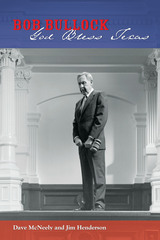 Bob Bullock: God Bless Texas
By Dave McNeely and Jim Henderson
University of Texas Press, 2008 Renowned for his fierce devotion to the people of Texas—as well as his equally fierce rages and unpredictable temper—Bob Bullock was the most powerful political figure in Texas at the end of the twentieth century. First elected to the Texas House of Representatives in 1956, Bullock held several key statewide posts before capturing the lieutenant governor's office in 1990. Though nominally the state's number two official, Bullock in fact became Texas's top power broker, wielding tremendous influence over the legislative agenda and state budget through the 1990s while also mentoring and supporting a future president—George W. Bush. In this lively, yet thoroughly researched biography, award-winning journalists Dave McNeely and Jim Henderson craft a well-rounded portrait of Bob Bullock, underscoring both his political adroitness and his personal demons. They trace Bullock's rise through state government as Assistant Attorney General, Secretary of State, State Comptroller, and Lieutenant Governor, showing how he increased the power of every office he held. The authors spotlight Bullock's substantial achievements, which included hiring an unprecedented number of women and minorities, instituting a performance review to increase the efficiency of state agencies, restructuring the public school funding system, and creating the state's first water conservation and management plan.
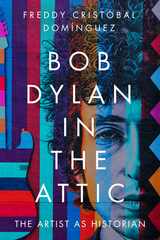 Bob Dylan in the Attic: The Artist as Historian
Freddy Cristóbal Domínguez
University of Massachusetts Press, 2022 Bob Dylan is an iconic American artist, whose music and performances have long reflected different musical genres and time periods. His songs tell tales of the Civil War, harken back to 1930s labor struggles, and address racial violence at the height of the civil rights movement, helping listeners to think about history, and history making, in new ways. While Dylan was warned by his early mentor, Dave Van Ronk, that, “You’re just going to be a history book writer if you do those things. An anachronism,” the musician has continued to traffic in history and engage with a range of source material—ancient and modern—over the course of his career. In this beautifully crafted book, Freddy Cristóbal Domínguez makes a provocative case for Dylan as a historian, offering a deep consideration of the musician’s historical influences and practices. Utilizing interviews, speeches, and the close analysis of lyrics and live performances, Bob Dylan in the Attic is the first book to consider Dylan’s work from the point of view of historiography.
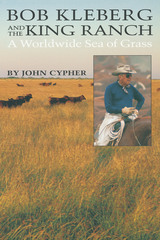 Bob Kleberg and the King Ranch: A Worldwide Sea of Grass
By John Cypher
University of Texas Press, 1996 Ranching on the vast scale that Texas is famous for actually happened at King Ranch, a sea of grass that ultimately spread its pastures to countries around the globe under the fifty-year leadership of Bob Kleberg. This absorbing biography, written by Kleberg's top assistant of many years, captures both the life of the man and the spirit of the kingdom he ruled, offering a rare, insider's view of life on a fabled Texas ranch. John Cypher spent forty years (1948-1988) on King Ranch. In these pages, he melds highlights of Kleberg's life with memories of his own experiences as the "right hand" who implemented many of Kleberg's grand designs. In a lively story laced with fascinating anecdotes he both recounts his worldwide travels with Kleberg as the ranch expanded its holdings to Latin America, Cuba, Australia, the Philippines, Europe, and Africa, and describes timeless, traditional tasks such as roundup at the home ranch in Kingsville. Kleberg's accomplishments as the founder of the Santa Gertrudis cattle breed and a breeder of Thoroughbred racing horses receive full attention, as does his fabled lifestyle, which included friendships not merely with the rich and famous but also with Queen Elizabeth the Queen Mother, who shared his love of horse racing. For everyone interested in ranching and one of its most famous practitioners, this book will be essential reading.
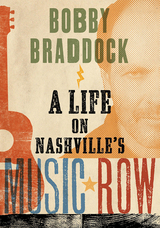 Bobby Braddock: A Life on Nashville’s Music Row
Bobby Braddock
Vanderbilt University Press, 2015 If you know country music, you know Bobby Braddock. Even if you don't know his name, you know the man's work. "He Stopped Loving Her Today." "D-I-V-O-R-C-E." "Golden Ring." "Time Marches On." "I Wanna Talk About Me." "People Are Crazy." These songs and numerous other chart-topping hits sprang from the mind of Bobby Braddock. A working songwriter and musician, Braddock has prowled the streets of Nashville's legendary Music Row since the mid-1960s, plying his trade and selling his songs. These decades of writing songs for legendary singers like George Jones, Tammy Wynette, and Toby Keith are recounted in Bobby Braddock: A Life on Nashville's Music Row, providing the reader with a stunning look at the beating heart of Nashville country music that cannot be matched.
If you're looking for insight into Nashville, the life of music in this town, and the story of a force of nature on the Row to this day, Bobby Braddock will take you there.
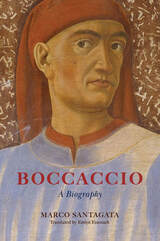 Boccaccio: A Biography
Marco Santagata
University of Chicago Press, 2025 A comprehensive biography of the celebrated author of the Decameron, a medieval masterpiece written in early Italian.
Boccaccio (1313–75) stands with Dante and Petrarch as one of the “Three Crowns” of Italian letters, a trio of writers who shaped the history of humanism, literature, and poetry. In this book, Dante’s award-winning biographer, Marco Santagata, takes up the moving life and legacy of Boccaccio—whose unflinching story of a pandemic-era community (the Decameron) created new possibilities for vernacular Italian prose.
This landmark biography sheds new light on Boccaccio’s life—his family, friends, and foes, his aspirations, fears, and frustrations—and it shows how he was affected by transformations in Italian society. It also charts the influences that shaped Boccaccio’s understanding of literature: what kinds of stories it could tell and what kinds of characters it could depict; and, perhaps most importantly, what role art could play in a changing world. An insightful portrait of one of literature’s most important figures, this book promises to be the definitive biography of Boccaccio for many years to come.
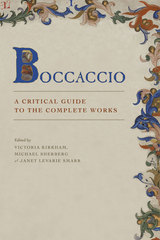 Boccaccio: A Critical Guide to the Complete Works
Edited by Victoria Kirkham, Michael Sherberg, and Janet Levarie Smarr
University of Chicago Press, 2013 Long celebrated as one of “the Three Crowns” of Florence, Giovanni Boccaccio (1313–75) experimented widely with the forms of literature. His prolific and innovative writings—which range beyond the novella, from lyric to epic, from biography to mythography and geography, from pastoral and romance to invective—became powerful models for authors in Italy and across the Continent. This collection of essays presents Boccaccio’s life and creative output in its encyclopedic diversity. Exploring a variety of genres, Latin as well as Italian, it provides short descriptions of all his works, situates them in his oeuvre, and features critical expositions of their most salient features and innovations. Designed for readers at all levels, it will appeal to scholars of literature, medieval and Renaissance studies, humanism, and the classical tradition; as well as European historians, art historians, and students of material culture and the history of the book. Anchored by an introduction and chronology, this volume contains contributions by prominent Boccaccio scholars in the United States, as well as essays by contributors from France, Italy, and the United Kingdom. The year 2013, Boccaccio’s seven-hundredth birthday, will be an important one for the study of his work and will see an increase in academic interest in reassessing his legacy.
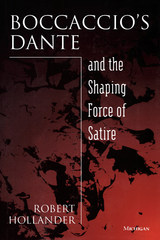 Boccaccio's Dante and the Shaping Force of Satire
Robert Hollander
University of Michigan Press, 1997 Before the publications of Robert Hollander and Attilio Bettinzoli in the early 1980s, there was little recognition of the surprisingly large debt owed by Boccaccio to Dante hidden in the pages of the Decameron. Boccaccio's knowledge and use of the works of Dante constitute a challenging topic, one that is beginning to receive the attention it deserves.
Among commentators, it had been an unexamined commonplace that the "young" Boccaccio either did not know well or did not understand sufficiently the texts of Dante (even though the "young" Boccaccio is construed as including the thirty-eight-year-old author of the Decameron.) In Boccaccio's Dante and the Shaping Force of Satire, Robert Hollander offers a valuable synthesis of new material and some previously published essays, addressing the question of Dante's influence on Boccaccio, particularly concerning the Commedia and the Decameron.
Hollander reveals that Boccaccio's writings are heavy with reminiscences of the Dante text, which he believed to be the greatest "modern" work. It was Boccaccio's belief that Dante was the only writer who had achieved a status similar to that reserved for the greatest writers of antiquity. Most of these essays try to show how carefully Boccaccio reflects the texts of Dante in the Decameron. Some essays also turn to the question of Boccaccio's allied reading of Ovid, especially the amatory work, as part of his strategy to base his work primarily on these two great authorities as he develops his own vernacular and satiric vision of human foolishness.
Boccaccio's Dante and the Shaping Force of Satire is a welcome addition to the field of Dante studies and to medieval studies in general.
Robert Hollander is Professor in European Literature and Chair, Department of Comparative Literature, Princeton University. He has received the city of Florence's gold medal for work advancing our understanding of Dante.
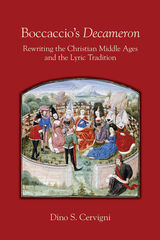 Boccaccio's "Decameron": Rewriting the Christian Middle Ages and the Lyric Tradition
Dino S. Cervigni
Arizona Center for Medieval and Renaissance Studies, 2021 This study develops a new interpretation of The Decameron, Giovanni Boccaccio’s masterpiece, which has found new popularity in the wake of COVID. Dino S. Cervigni offers an inclusive and novel reading of the collection, theorizing that the first ninety tales offer a parodic rewriting of the Christian Middle Age, while the last ten tales craft a reconstruction of society based on human and liberal principles such as generosity and sacrifice. Still relevant to this day, The Decameron offers a notable description of the bubonic plague of 1348 which devastated Western Europe—drawing striking parallels with the current global pandemic. Furthermore, Boccaccio’s concluding message applies to all of us in the present moment, plunged as we are into a world of intellectual and ethical chaos, exhorting us to practice forgiveness, compassion, tolerance, mutual acceptance, and generous open-mindedness. No other book on The Decameron offers such a relevant, up-to-date reading of the classic work.
The Bodega of Palenque, Chiapas, Mexico
Linda Schele and Peter Mathews
Harvard University Press Illustrated with both black-and-white photographs and line drawings, this catalogue records the most important objects in the storeroom of the museum at Palenque.
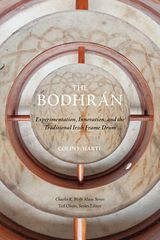 The Bodhrán: Experimentation, Innovation, and the Traditional Irish Frame Drum
Colin F. Harte
University of Tennessee Press, 2020 In the past fifty years, the bodhrán, or traditional Irish circular frame drum, has undergone a rapid evolution in development. Traditionally, it is a shallow drum ranging from ten to twenty-six inches in diameter, covered in goatskin on the top (or drum) side and open on the other. Unlike any other instrument associated with Irish traditional music, the bodhrán has been dramatically altered by its confrontation with modern instrument design, performance techniques, and musical practice. Colin Harte’s The Bodhrán: Experimentation, Innovation, and the Traditional Irish Frame Drum presents a definitive history of the bodhrán from its early origins to its present-day resurgence in Irish American folk music.
The bodhrán has global roots and bears many characteristics of older drums from northern Africa and the Middle East. Harte picks up on these basic similarities and embarks on an engaging tour of the instrument’s historical and organological development, gradual evolution in playing styles, and more recent history of performative practice. Drawing from a host of interviews over a multi-year period with participants primarily located in Europe and North America, this work provides a platform for multiple perspectives regarding the bodhrán. Participants include bodhrán makers, professional performers, educators, amateur musicians, historians, and enthusiasts. Growing out of rich ethnographic interviews, this book serves as the definitive reference for understanding and navigating the developments in the bodhrán’s history, organology, performance practices, and repertoire.
Bodies and Narrativity Across the Early Modern World
Vitus Huber
Amsterdam University Press, 2025 This book explores the intricate connections between the body and narrative across the early modern world. It examines how bodily aspects shaped the creation of stories and vice versa. The writing, telling, or interpreting of a story is inherently tied to corporeal acts and is, to varying degrees, shaped by them. Likewise, narrativity—the narrative form, including the framing and structuring elements that define a story’s meaning—can influence how the body is experienced, understood, and valued. Adopting an interdisciplinary approach and incorporating case studies from Africa, the Americas, and Europe, this volume positions the body as a critical heuristic tool. It moves beyond the dichotomous debate between constructivism and essentialism by emphasizing the interplay of body and narrative.
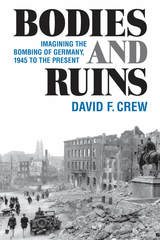 Bodies and Ruins: Imagining the Bombing of Germany, 1945 to the Present
David F. Crew
University of Michigan Press, 2017 Bodies and Ruins explores changing German memories of World War II as it analyzes the construction of narratives in the postwar period including the depiction of the bombing of individual German cities. The book offers a corrective notion rising in the late 1990s notion that discussions of the Allied bombing were long overdue, because Germans who had endured the bombings had largely been condemned to silence after 1945. David Crew shows that far from being marginalized in postwar historical consciousness, the bombing war was in fact a central strand of German memory and identity. Local narratives of the bombing war, including photographic books, had already established themselves as important “vectors of memory” in the late 1940s and early 1950s. The bombing war had allowed Germans to see themselves as victims at a time when the Allied liberation of the concentration camps and the Nuremberg trials presented Germans to the world as perpetrators or at least as accomplices. The bombing war continued to serve this function even as Germans became more and more willing directly to confront the genocide of European Jews—which by the 1960s was beginning to be referred to as the Holocaust.
Bodies and Ruins examines a range of local publications that carried photographic images of German cities destroyed in the air war, images that soon entered the visual memory of World War II. Despite its obvious importance, historians have paid very little attention to the visual representation of the bombing war. This book follows the search for what were considered to be the “right” stories and the “right” pictures of the bombing war in local publications and picture books from 1945 to the present, and is intended for historians as well as general readers interested in World War II, the Allied bombing of German cities, the Holocaust, the history of memory and photographic/visual history.
 Bodies and Souls: Politics and the Professionalization of Nursing in France, 1880-1922
Katrin Schultheiss
Harvard University Press, 2001 In the French Third Republic, nursing was an occupation caught in the crosscurrents of conflicting notions about the role of women. This deft political history shows how the turmoil and transformation of nursing during this period reflected the political and cultural tensions at work in the nation, including critical conflicts over the role of the Church in society, the professionalization of medicine, the organization and growing militancy of the working classes, and the emancipation of women.
Bodies and Souls describes a time when nursing evolved from a vocation dominated by Catholic orders to a feminine profession that included increasing numbers of lay women. As she pursues this story from the founding of the first full-time professional nursing school in Lyons through the changes wrought by World War I, Katrin Schultheiss reveals how the debates over what nurses were to be, know, and do were deeply enmeshed in issues of class, definitions of femininity, the nature of women's work, and the gendered character of social and national service. Her fine study maps the intersection of these debates with political forces, their impact on hospital nursing and nursing education, and on the shaping of a feminine version of citizenship in France.
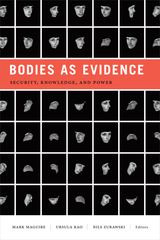 Bodies as Evidence: Security, Knowledge, and Power
Mark Maguire, Ursula Rao, and Nils Zurawski, editors
Duke University Press, 2018 From biometrics to predictive policing, contemporary security relies on sophisticated scientific evidence-gathering and knowledge-making focused on the human body. Bringing together new anthropological perspectives on the complexities of security in the present moment, the contributors to Bodies as Evidence reveal how bodies have become critical sources of evidence that is organized and deployed to classify, recognize, and manage human life. Through global case studies that explore biometric identification, border control, forensics, predictive policing, and counterterrorism, the contributors show how security discourses and practices that target the body contribute to new configurations of knowledge and power. At the same time, margins of error, unreliable technologies, and a growing suspicion of scientific evidence in a “post-truth” era contribute to growing insecurity, especially among marginalized populations.
Contributors. Carolina Alonso-Bejarano, Gregory Feldman, Francisco J. Ferrándiz, Daniel M. Goldstein, Ieva Jusionyte, Amade M’charek, Mark Maguire, Joseph P. Masco, Ursula Rao, Antonius C. G. M. Robben, Joseba Zulaika, Nils Zurawski
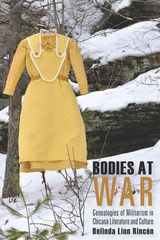 Bodies at War: Genealogies of Militarism in Chicana Literature and Culture
Belinda Linn Rincón
University of Arizona Press, 2017 In the wake of U.S. military intervention abroad and collapsing domestic economies, scholars have turned their attention to neoliberalism and militarization, two ideological and material projects that are often treated as coincident, though not interdependent. Bodies at War examines neoliberal militarism, a term that signifies the complex ways in which neoliberalism and militarism interanimate each other as they naturalize dis/empowering notions of masculinity and femininity, alter democratic practices, and circumscribe the meaning of citizenship and national belonging.
Bodies at War examines the rise of neoliberal militarism from the early 1970s to the present and its transformation of political, economic, and social relations. It charts neoliberal militarism’s impact on democratic practices, economic policies, notions of citizenship, race relations, and gender norms by focusing on how these changes affect the Chicana/o community and, more specifically, on how it shapes and is shaped by Chicana bodies. The book raises important questions about the cultural legacies of war and the gendering of violence—topics that reach across multiple disciplinary fields of inquiry, including cultural and media studies. It draws attention to the relationship between war and society, to neoliberal militarism’s destructive social impact, and to the future of Latina soldiering. Through Chicana art, activism, and writing, Rincón offers a visionary foundation for an antiwar feminist politic.
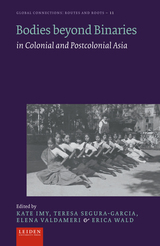 Bodies beyond Binaries: in Colonial and Postcolonial Asia
Kate Imy
Leiden University Press, 2024 "Bodies beyond Binaries' advances the historiographical debate around the body in colonial and postcolonial Asia. Opening new research avenues that go beyond the binaries that have sometimes permeated previous scholarly contributions, this book explores not just the direct colonial encounter, but also wider global interconnections and flows involved in the making of knowledge, cultural constructions, and ‘techniques’ of the body. Throughout the volume, critical concepts such as gender, sexuality, race, class, caste, and religion intersect and dialogue with supposedly binary categories of corporeality such as ruled and unruly, emotional and trained, mobile and confined, and respectable and deviant. Problematised and transcended, these categories reveal their ambiguous and malleable nature. Bringing together a range of contributions from established and emerging scholars working on different Asian regional and transregional foci, 'Bodies beyond Binaries' offers insights that are not simply relevant across Asia and within colonial settings, but also question Western-centric and culturally essentialist perspectives on the history of the body."
Bodie’s Gold: Tall Tales and True History from a California Mining Town
Marguerite Sprague
University of Nevada Press, 2011 The Bodie Mining District was established in 1860 after the discovery of gold deposits in the area. Bodie’s largest boom ended ust over twenty years later, but the town survived into the twentieth century supported by a few small but steady mines. Mining ended with World War II. What remained of the town became a state park in 1964. In Bodie’s Gold, author Marguerite Sprague uncovers the original sources of information whenever possible, from the first mining claims to interviews with former Bodieites. Enhanced with numerous historic photographs and extracts from newspapers of that period, as well as by the reminiscences of former residents, the book offers a fascinating account of life in a Gold Rush boomtown.
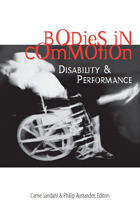 Bodies in Commotion: Disability and Performance
Edited by Carrie Sandahl and Philip Auslander
University of Michigan Press, 2005 "A testament to the synergy of two evolving fields. From the study of staged performances to examinations of the performing body in everyday life, this book demonstrates the enormous profitability of moving beyond disability as metaphor. . . . It's a lesson that many of our cultural institutions desperately need to learn."
-Martin F. Norden, University of Massachusetts-Amherst
This groundbreaking collection imagines disabled bodies as "bodies in commotion"-bodies that dance across artistic and discursive boundaries, challenging our understanding of both disability and performance. In the book's essays, leading critics and artists explore topics that range from theater and dance to multi-media performance art, agit-prop, American Sign Language theater, and wheelchair sports. Bodies in Commotion is the first collection to consider the mutually interpretive qualities of these two emerging fields, producing a dynamic new resource for artists, activists, and scholars.
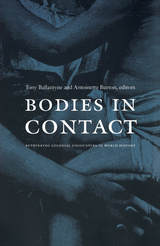 Bodies in Contact: Rethinking Colonial Encounters in World History
Tony Ballantyne and Antoinette Burton, eds.
Duke University Press, 2005 From portrayals of African women’s bodies in early modern European travel accounts to the relation between celibacy and Indian nationalism to the fate of the Korean “comfort women” forced into prostitution by the occupying Japanese army during the Second World War, the essays collected in Bodies in Contact demonstrate how a focus on the body as a site of cultural encounter provides essential insights into world history. Together these essays reveal the “body as contact zone” as a powerful analytic rubric for interpreting the mechanisms and legacies of colonialism and illuminating how attention to gender alters understandings of world history. Rather than privileging the operations of the Foreign Office or gentlemanly capitalists, these historical studies render the home, the street, the school, the club, and the marketplace visible as sites of imperial ideologies. Bodies in Contact brings together important scholarship on colonial gender studies gathered from journals around the world. Breaking with approaches to world history as the history of “the West and the rest,” the contributors offer a panoramic perspective. They examine aspects of imperial regimes including the Ottoman, Mughal, Soviet, British, Han, and Spanish, over a span of six hundred years—from the fifteenth century through the mid-twentieth. Discussing subjects as diverse as slavery and travel, ecclesiastical colonialism and military occupation, marriage and property, nationalism and football, immigration and temperance, Bodies in Contact puts women, gender, and sexuality at the center of the “master narratives” of imperialism and world history. Contributors. Joseph S. Alter, Tony Ballantyne, Antoinette Burton, Elisa Camiscioli, Mary Ann Fay, Carter Vaughn Findley, Heidi Gengenbach, Shoshana Keller, Hyun Sook Kim, Mire Koikari, Siobhan Lambert-Hurley, Melani McAlister, Patrick McDevitt, Jennifer L. Morgan, Lucy Eldersveld Murphy, Rosalind O’Hanlon, Rebecca Overmyer-Velázquez, Fiona Paisley, Adele Perry, Sean Quinlan, Mrinalini Sinha, Emma Jinhua Teng, Julia C. Wells
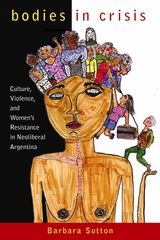 Bodies in Crisis: Culture, Violence, and Women's Resistance in Neoliberal Argentina
Sutton, Barbara
Rutgers University Press, 2010 Born and raised in Argentina and still maintaining significant ties to the area, Barbara Sutton examines the complex, and often hidden, bodily worlds of diverse women in that country during a period of profound social upheaval. Based primarily on women's experiential narratives and set against the backdrop of a severe economic crisis and intensified social movement activism post-2001, Bodies in Crisis illuminates how multiple forms of injustice converge in and are contested through women's bodies. Sutton reveals the bodily scars of neoliberal globalization; women's negotiation of cultural norms of femininity and beauty; experiences with clandestine, illegal, and unsafe abortions; exposure to and resistance against interpersonal and structural violence; and the role of bodies as tools and vehicles of political action.
Through the lens of women's body consciousness in a Global South country, and drawing on multifaceted stories and a politically embedded approach, Bodies in Crisis suggests that social policy, economic systems, cultural ideologies, and political resistance are ultimately fleshly matters.
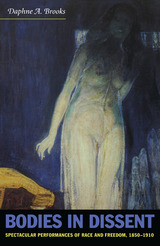 Bodies in Dissent: Spectacular Performances of Race and Freedom, 1850–1910
Daphne A. Brooks
Duke University Press, 2006 In Bodies in Dissent Daphne A. Brooks argues that from the mid-nineteenth century to the early twentieth, black transatlantic activists, actors, singers, and other entertainers frequently transformed the alienating conditions of social and political marginalization into modes of self-actualization through performance. Brooks considers the work of African American, Anglo, and racially ambiguous performers in a range of popular entertainment, including racial melodrama, spectacular theatre, moving panorama exhibitions, Pan-Africanist musicals, Victorian magic shows, religious and secular song, spiritualism, and dance. She describes how these entertainers experimented with different ways of presenting their bodies in public—through dress, movement, and theatrical technologies—to defamiliarize the spectacle of “blackness” in the transatlantic imaginary. Brooks pieces together reviews, letters, playbills, fiction, and biography in order to reconstruct not only the contexts of African American performance but also the reception of the stagings of “bodily insurgency” which she examines. Throughout the book, she juxtaposes unlikely texts and entertainers in order to illuminate the complicated transatlantic cultural landscape in which black performers intervened. She places Adah Isaacs Menken, a star of spectacular theatre, next to Sojourner Truth, showing how both used similar strategies of physical gesture to complicate one-dimensional notions of race and gender. She also considers Henry Box Brown’s public re-enactments of his escape from slavery, the Pan-Africanist discourse of Bert Williams’s and George Walker’s musical In Dahomey (1902–04), and the relationship between gender politics, performance, and New Negro activism in the fiction of the novelist and playwright Pauline Hopkins and the postbellum stage work of the cakewalk dancer and choreographer Aida Overton Walker. Highlighting the integral connections between performance and the construction of racial identities, Brooks provides a nuanced understanding of the vitality, complexity, and influence of black performance in the United States and throughout the black Atlantic.
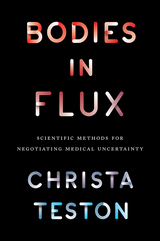 Bodies in Flux: Scientific Methods for Negotiating Medical Uncertainty
Christa Teston
University of Chicago Press, 2017 Doctors, scientists, and patients have long grappled with the dubious nature of “certainty” in medical practice. To help navigate the chaos caused by ongoing bodily change we rely on scientific reductions and deductions. We take what we know now and make best guesses about what will be. But bodies in flux always outpace the human gaze. Particularly in cancer care, processes deep within our bodies are at work long before we even know where to look. In the face of constant biological and technological change, how do medical professionals ultimately make decisions about care?
Bodies in Flux explores the inventive ways humans and nonhumans work together to manufacture medical evidence. Each chapter draws on rhetorical theory to investigate a specific scientific method for negotiating medical uncertainty in cancer care, including evidential visualization, assessment, synthesis, and computation. Case studies unveil how doctors rely on visuals when deliberating about a patient’s treatment options, how members of the FDA use inferential statistics to predict a drug’s effectiveness, how researchers synthesize hundreds of clinical trials into a single evidence-based recommendation, and how genetic testing companies compute and commoditize human health. Teston concludes by advocating for an ethic of care that pushes back against the fetishization of certainty—an ethic of care that honors human fragility and bodily flux.
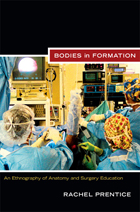 Bodies in Formation: An Ethnography of Anatomy and Surgery Education
Rachel Prentice
Duke University Press, 2012 Surgeons employ craft, cunning, and technology to open, observe, and repair patient bodies. In Bodies in Formation, anthropologist Rachel Prentice enters surgical suites increasingly packed with new medical technologies to explore how surgeons are made in the early twenty-first century. Prentice argues that medical students and residents learn through practice, coming to embody unique ways of perceiving, acting, and being. Drawing on ethnographic observation in anatomy laboratories, operating rooms, and technology design groups, she shows how trainees become physicians through interactions with colleagues and patients, technologies and pathologies, bodies and persons. Bodies in Formation foregrounds the technical, ethical, and affective formation of physicians, demonstrating how, even within a world of North American biomedicine increasingly dominated by technologies for remote interventions and computerized teaching, good care remains the art of human healing.
Bodies in Protest: Hunger Strikes and Angry Music
Johanna Siméant and Christophe Traïni
Amsterdam University Press, 2016 Research on social movements has historically focused on the traditional weapons of the working class, especially labor strikes and street demonstrations-but everyday actions, such as eating or singing, which can also be turned into a means of protest, have yet to be fully explored. Originally published as La grève de la faim by Johanna Siméant and La musique en colère by Christophe Traïni, Bodies in Protest is an interdisciplinary and comparative history of these modes of action that reveals how hunger strikes and music ranging from gospel songs to rock anthems can efficiently convey political messages and mobilize the masses. Common to both approaches, the chapters show, is a direct appeal to the emotions and a reliance on the physical, concrete language of the human body.
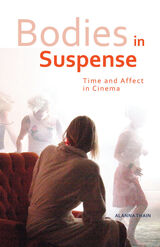 Bodies in Suspense: Time and Affect in Cinema
Alanna Thain
University of Minnesota Press, 2017 Bodies in Suspense presents a powerful new way to think through postdigital cinema and the affective turn in critical theory. According to Alanna Thain, suspense films allow us to experience the relation between two bodies: that of the film and that of the viewer. Through the “time machine” of suspense, film form, gender, genre, and spectatorship are revealed in innovative and different ways. These films not only engage us directly in ethical concerns, but also provide a key for understanding corporeal power in the digital era. Offering a new framework for understanding cinematic suspense, Bodies in Suspense argues that the “body in time” enables us to experience the temporal dimension of the body directly. This is the first book to link two contemporary frames of analysis: questions of cinematic temporality and contemporary affect theory. Thain conducts close readings of influential suspense films by Alfred Hitchcock, David Lynch, Christian Marclay, Rian Johnson, and Lou Ye, and sets forth a compelling new theory of cinema, reading for the productivity of the “crime of time” that stages the duplicity of cinematic bodies. Through these films that foreground doubled characters and looping, Thain explores Gilles Deleuze’s claim that “the direct time-image is the phantom which has always haunted cinema.” A vital new addition to film theory, corporeality and affect theory, feminist theory, and the philosophy of time—and one of the first books to explore David Lynch’s Hollywood trilogy—Bodies in Suspense asks us to pay attention, above all, to the ways in which the condition of spectatorship creates a doubling sensation with important philosophical repercussions.
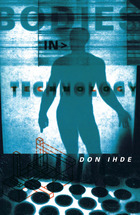 Bodies In Technology
Don Ihde
University of Minnesota Press, 2001 An original exploration of the ways cyberspace affects human experience. New technologies suggest new ideas about embodiment: our "reach" extends to global sites through the Internet; we enter cyberspace through the engines of virtual reality. In this book, a leading philosopher of technology explores the meaning of bodies in technology-how the sense of our bodies and of our orientation in the world is affected by the various information technologies. Bodies in Technology begins with an analysis of embodiment in cyberspace, then moves on to consider ways in which social theorists have interpreted or overlooked these conditions. An astute and sensible judge of these theories, Don Ihde is a uniquely provocative and helpful guide through contemporary thinking about technology and embodiment, drawing on sources and examples as various as video games, popular films, the workings of e-mail, and virtual reality techniques.Charting the historical, philosophical, and practical territory between virtual reality and real life, this work is an important contribution to the national conversation on the impact technology-and information technology in particular-has on our lives in a wired, global age.
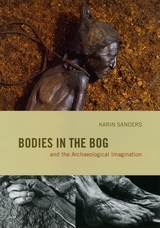 Bodies in the Bog and the Archaeological Imagination
Karin Sanders
University of Chicago Press, 2009 Over the past few centuries, northern Europe’s bogs have yielded mummified men, women, and children who were deposited there as sacrifices in the early Iron Age and kept startlingly intact by the chemical properties of peat. In this remarkable account of their modern afterlives, Karin Sanders argues that the discovery of bog bodies began an extraordinary—and ongoing—cultural journey. Throughout the nineteenth and twentieth centuries, Sanders shows, these eerily preserved remains came alive in art and science as material metaphors for such concepts as trauma, nostalgia, and identity. Sigmund Freud, Joseph Beuys, Seamus Heaney, and other major figures have used them to reconsider fundamental philosophical, literary, aesthetic, and scientific concerns. Exploring this intellectual spectrum, Sanders contends that the power of bog bodies to provoke such a wide range of responses is rooted in their unique status as both archeological artifacts and human beings. They emerge as corporeal time capsules that transcend archaeology to challenge our assumptions about what we can know about the past. By restoring them to the roster of cultural phenomena that force us to confront our ethical and aesthetic boundaries, Bodies in the Bog excavates anew the question of what it means to be human.
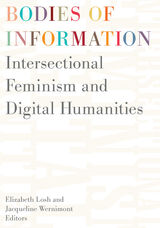 Bodies of Information: Intersectional Feminism and the Digital Humanities
Elizabeth Losh
University of Minnesota Press, 2018 A wide-ranging, interconnected anthology presents a diversity of feminist contributions to digital humanities In recent years, the digital humanities has been shaken by important debates about inclusivity and scope—but what change will these conversations ultimately bring about? Can the digital humanities complicate the basic assumptions of tech culture, or will this body of scholarship and practices simply reinforce preexisting biases? Bodies of Information addresses this crucial question by assembling a varied group of leading voices, showcasing feminist contributions to a panoply of topics, including ubiquitous computing, game studies, new materialisms, and cultural phenomena like hashtag activism, hacktivism, and campaigns against online misogyny. Taking intersectional feminism as the starting point for doing digital humanities, Bodies of Information is diverse in discipline, identity, location, and method. Helpfully organized around keywords of materiality, values, embodiment, affect, labor, and situatedness, this comprehensive volume is ideal for classrooms. And with its multiplicity of viewpoints and arguments, it’s also an important addition to the evolving conversations around one of the fastest growing fields in the academy. Contributors: Babalola Titilola Aiyegbusi, U of Lethbridge; Moya Bailey, Northeastern U; Bridget Blodgett, U of Baltimore; Barbara Bordalejo, KU Leuven; Jason Boyd, Ryerson U; Christina Boyles, Trinity College; Susan Brown, U of Guelph; Lisa Brundage, CUNY; micha cárdenas, U of Washington Bothell; Marcia Chatelain, Georgetown U; Danielle Cole; Beth Coleman, U of Waterloo; T. L. Cowan, U of Toronto; Constance Crompton, U of Ottawa; Amy E. Earhart, Texas A&M; Nickoal Eichmann-Kalwara, U of Colorado Boulder; Julia Flanders, Northeastern U Library; Sandra Gabriele, Concordia U; Brian Getnick; Karen Gregory, U of Edinburgh; Alison Hedley, Ryerson U; Kathryn Holland, MacEwan U; James Howe, Rutgers U; Jeana Jorgensen, Indiana U; Alexandra Juhasz, Brooklyn College, CUNY; Dorothy Kim, Vassar College; Kimberly Knight, U of Texas, Dallas; Lorraine Janzen Kooistra, Ryerson U; Sharon M. Leon, Michigan State; Izetta Autumn Mobley, U of Maryland; Padmini Ray Murray, Srishti Institute of Art, Design, and Technology; Veronica Paredes, U of Illinois; Roopika Risam, Salem State; Bonnie Ruberg, U of California, Irvine; Laila Shereen Sakr (VJ Um Amel), U of California, Santa Barbara; Anastasia Salter, U of Central Florida; Michelle Schwartz, Ryerson U; Emily Sherwood, U of Rochester; Deb Verhoeven, U of Technology, Sydney; Scott B. Weingart, Carnegie Mellon U.
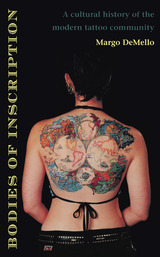 Bodies of Inscription: A Cultural History of the Modern Tattoo Community
Margo DeMello
Duke University Press, 2004 Since the 1980s, tattooing has emerged anew in the United States as a widely appealing cultural, artistic, and social form. In Bodies of Inscription Margo DeMello explains how elite tattooists, magazine editors, and leaders of tattoo organizations have downplayed the working-class roots of tattooing in order to make it more palatable for middle-class consumption. She shows how a completely new set of meanings derived primarily from non-Western cultures has been created to give tattoos an exotic, primitive flavor.
Community publications, tattoo conventions, articles in popular magazines, and DeMello’s numerous interviews illustrate the interplay between class, culture, and history that orchestrated a shift from traditional Americana and biker tattoos to new forms using Celtic, tribal, and Japanese images. DeMello’s extensive interviews reveal the divergent yet overlapping communities formed by this class-based, American-style repackaging of the tattoo. After describing how the tattoo has moved from a mark of patriotism or rebellion to a symbol of exploration and status, the author returns to the predominantly middle-class movement that celebrates its skin art as spiritual, poetic, and self-empowering. Recognizing that the term “community” cannot capture the variations and class conflict that continue to thrive within the larger tattoo culture, DeMello finds in the discourse of tattooed people and their artists a new and particular sense of community and explores the unexpected relationship between this discourse and that of other social movements.
This ethnography of tattooing in America makes a substantive contribution to the history of tattooing in addition to relating how communities form around particular traditions and how the traditions themselves change with the introduction of new participants. Bodies of Inscription will have broad appeal and will be enjoyed by readers interested in cultural studies, American studies, sociology, popular culture, and body art.
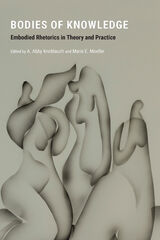 Bodies of Knowledge: Embodied Rhetorics in Theory and Practice
A. Abby Knoblauch
Utah State University Press, 2021 Bodies of Knowledge challenges homogenizing (mis)understandings of knowledge construction and provides a complex discussion of what happens when we do not attend to embodied rhetorical theories and practices. Because language is always a reflection of culture, to attempt to erase language and knowledge practices that reflect minoritized and historically excluded cultural experiences obscures the legitimacy of such experiences both within and outside the academy.
The pieces in Bodies of Knowledge draw explicit attention to the impact of the body on text, the impact of the body in text, the impact of the body as text, and the impact of the body upon textual production. The contributors investigate embodied rhetorics through the lenses of race and ethnicity, gender and sexuality, disability and pain, technologies and ecologies, clothing and performance, and scent, silence, and touch. In doing so, they challenge the (false) notion that academic knowledge—that is, “real” knowledge—is disembodied and therefore presumed white, middle class, cis-het, able-bodied, and male. This collection lays bare how myriad bodies invent, construct, deliver, and experience the processes of knowledge building.
Experts in the field of writing studies provide the necessary theoretical frameworks to better understand productive (and unproductive) uses of embodied rhetorics within the academy and in the larger social realm. To help meet the theoretical and pedagogical needs of the discipline, Bodies of Knowledge addresses embodied rhetorics and embodied writing more broadly though a rich, varied, and intersectional approach. These authors address larger questions around embodiment while considering the various impacts of the body on theories and practices of rhetoric and composition.
Contributors: Scot Barnett, Margaret Booker, Katherine Bridgman, Sara DiCaglio, Kristie S. Fleckenstein, Vyshali Manivannan, Temptaous Mckoy, Julie Myatt, Julie Nelson, Ruth Osorio, Kate Pantelides, Caleb Pendygraft, Nadya Pittendrigh, Kellie Sharp-Hoskins, Anthony Stagliano, Megan Strom
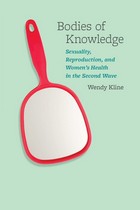 Bodies of Knowledge: Sexuality, Reproduction, and Women's Health in the Second Wave
Wendy Kline
University of Chicago Press, 2010 Throughout the 1970s and ’80s, women argued that unless they gained access to information about their own bodies, there would be no equality. In Bodies of Knowledge, Wendy Kline considers the ways in which ordinary women worked to position the female body at the center of women’s liberation.
As Kline shows, the struggle to attain this knowledge unified women but also divided them—according to race, class, sexuality, or level of professionalization. Each of the five chapters of Bodies of Knowledge examines a distinct moment or setting of the women’s movement in order to give life to the ideas, expectations, and pitfalls encountered by the advocates of women’s health: the making of Our Bodies, Ourselves (1973); the conflicts surrounding the training and practice of women’s pelvic exams; the emergence of abortion as a feminist issue; the battles over contraceptive regulation at the 1983 Depo-Provera FDA hearings; and the rise of the profession of midwifery. Including an epilogue that considers the experiences of the daughters of 1970s feminists, Bodies of Knowledge is an important contribution to the study of the bodies—that marked the lives—of feminism’s second wave.
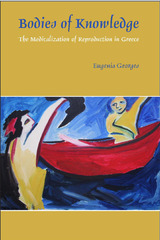 Bodies of Knowledge: The Medicalization of Reproduction in Greece
Eugenia Georges
Vanderbilt University Press, 2008 Recipient of the 2006 Norman L. and Roselea J. Goldberg Prize for the best project in the area of medicine. The author, a second-generation Greek American, returned to Greece with her young daughter to do fieldwork over the course of a decade. Focusing on Rhodes, an island that blends continuity with the past and rapid social change in often unexpected ways, she interviewed over a hundred women, doctors, and midwives about issues of reproduction. The result is a detailed portrait of how a longstanding system of "local" gynecological and obstetrical knowledge under the control of women was rapidly displaced in the the period following World War II, and how the technologically-intensive biomedical model that took its place in turn assumed its own distinctive signature. Bodies of Knowledge is a vivid ethnographic study of how a presumably globalizing and homogenizing process like medicalization can be reshaped as women and medical experts alike selectively accept or reject new practices and technologies. Georges found, for example, that women in Rhodes have enthusiastically embraced some new technologies, like fetal imaging during pregnancy, but rejected others, like medical contraception. They are also avid consumers of popular childbirth manuals. This book is the recipient of the 2006 Norman L. and Roselea J. Goldberg Prize for the best project in the area of medicine.
Bodies of Modernism: Physical Disability in Transatlantic Modernist Literature
Maren Tova Linett
University of Michigan Press, 2017 Bodies of Modernism brings a new and exciting analytical lens to modernist literature, that of critical disability studies. The book offers new readings of canonical and noncanonical writers from both sides of the Atlantic including Flannery O’Connor, Eudora Welty, H. G. Wells, D. H. Lawrence, Elizabeth Bowen, Henry Green, Olive Moore, Carson McCullers, Tennessee Williams, J. M. Synge, Florence Barclay, Virginia Woolf, and James Joyce. Through readings of this wide range of texts and with chapters focusing on mobility impairments, deafness, blindness, and deformity, the study reveals both modernism’s skepticism about and dependence on fantasies of whole, “normal” bodies.
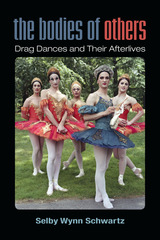 The Bodies of Others: Drag Dances and Their Afterlives
Selby Wynn Schwartz
University of Michigan Press, 2019 The Bodies of Others explores the politics of gender in motion. From drag ballerinas to faux queens, and from butoh divas to the club mothers of modern dance, the book delves into four decades of drag dances on American stages. Drag dances take us beyond glittery one-liners and into the spaces between gender norms. In these backstage histories, dancers give their bodies over to other selves, opening up the category of realness. The book maps out a drag politics of embodiment, connecting drag dances to queer hope, memory, and mourning. There are aging étoiles, midnight shows, mystical séances, and all of the dust and velvet of divas in their dressing-rooms. But these forty years of drag dances are also a cultural history, including Mark Morris dancing the death of Dido in the shadow of AIDS, and the swans of Les Ballets Trockadero de Monte Carlo sketching an antiracist vision for ballet. Drawing on queer theory, dance history, and the embodied practices of dancers themselves, The Bodies of Others examines the ways in which drag dances undertake the work of a shared queer and trans politics.
Bodies of Resistance: New Phenomenologies of Politics, Agency, and Culture
Laura Doyle
Northwestern University Press, 2001 This startling volume explores the traumas and possibilities of embodiment as it is lived in a political world. Unveiling the influence of phenomenology, particularly that of Maurice Merleau-Ponty, on contemporary thought. Bodies of Resistance cuts across the disciplines of philosophy, political theory, literature, and cultural studies to explore anew how we are at once produced by yet resistant to cultural norms.
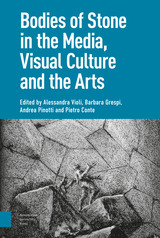 Bodies of Stone in the Media, Visual Culture and the Arts
Alessandra Violi
Amsterdam University Press, 2020 If mediatization has surprisingly revealed the secret life of inert matter and the ‘face of things’, the flipside of this has been the petrification of living organisms, an invasion of stone bodies in a state of suspended animation. Within a contemporary imaginary pervaded by new forms of animism, the paradigm of death looms large in many areas of artistic experimentation, pushing the modern body towards mineral modes of being which revive ancient myths of flesh-made-stone and the issue of the monument. Scholars in media, visual culture and the arts propose studies of bodies of stone, from actors simulating statues to the transmutation of the filmic body into a fossil; from the real treatment of the cadaver as a mineral living object to the rediscovery of materials such as wax; from the quest for a ‘thermal’ equivalence between stone and flesh to the transformation of the biomedical body into a living monument.
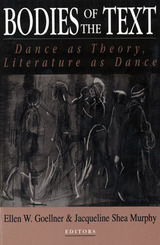 Bodies of the Text: Dance as Theory, Literature as Dance
Edited by Ellen W Goellner
Rutgers University Press, 1995 Dance and literary studies have traditionally been at odds: dancers and dance critics have understood academic analysis to be overly invested in the mind at the expense of body signification; literary critics and theorists have seen dance studies as anti-theoretical, even anti-intellectual. Bodies of the Text is the first book-length study of the interconnections between the two arts and the body of writing about them. The essays, by scholar-critics of dance and literature, explore dances actual and fictional to offer powerful new insights into issues of gender, race, ethnicity, popular culture, feminist aesthetics, historical "embodiment," identity politics, and narrativity. The general introduction traces the genealogy of dance studies in the academy to suggest why critical and theoretical attention to dance--and dance's challenges to writing--is both compelling and overdue. A milestone in interdisciplinary studies, Bodies of the Text opens both its fields to new inquiry, new theoretical precision, and to new readers and writers.
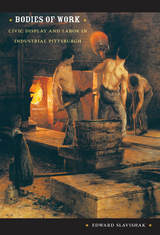 Bodies of Work: Civic Display and Labor in Industrial Pittsburgh
Edward Slavishak
Duke University Press, 2008 By the end of the nineteenth century, Pittsburgh emerged as a major manufacturing center in the United States. Its rise as a leading producer of steel, glass, and coal was fueled by machine technology and mass immigration, developments that fundamentally changed the industrial workplace. Because Pittsburgh’s major industries were almost exclusively male and renowned for their physical demands, the male working body came to symbolize multiple often contradictory narratives about strength and vulnerability, mastery and exploitation. In Bodies of Work, Edward Slavishak explores how Pittsburgh and the working body were symbolically linked in civic celebrations, the research of social scientists, the criticisms of labor reformers, advertisements, and workers’ self-representations. Combining labor and cultural history with visual culture studies, he chronicles a heated contest to define Pittsburgh’s essential character at the turn of the twentieth century, and he describes how that contest was conducted largely through the production of competing images. Slavishak focuses on the workers whose bodies came to epitomize Pittsburgh, the men engaged in the arduous physical labor demanded by the city’s metals, glass, and coal industries. At the same time, he emphasizes how conceptions of Pittsburgh as quintessentially male limited representations of women in the industrial workplace. The threat of injury or violence loomed large for industrial workers at the turn of the twentieth century, and it recurs throughout Bodies of Work: in the marketing of artificial limbs, statistical assessments of the physical toll of industrial capitalism, clashes between labor and management, the introduction of workplace safety procedures, and the development of a statewide workmen’s compensation system.
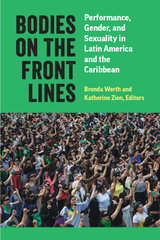 Bodies on the Front Lines: Performance, Gender, and Sexuality in Latin America and the Caribbean
Brenda Werth and Katherine Zien, Editors
University of Michigan Press, 2024 Revolutionary feminisms and queer and trans activist movements are traversing Latin America and the Caribbean. Bodies on the Front Lines situates recent performances and protest actions within legacies of homegrown gender and sexual rights activism from the South. Performances — enacted in public spaces and intimate venues, across national borders, and through circulating hashtags and digital media — play crucial roles in the elaboration, auto-theorization, translation, and reception of feminist, queer, and trans activism. Movements such as Argentina's NiUnaMenos (Not One Less) have brought together hundreds of thousands of protesters and ‘artivists’ on the streets of major cities in Latin America and beyond to denounce gender violence and demand gender, sexual, and reproductive rights.
The volume’s contributors draw from rich legacies of theater, performance, and activism in the region, as well as decolonial and intersectional theorizing, to demonstrate the ways that performance practices enable activists to sustain their movements. The chapters engage diverse perspectives from Argentina, Brazil, Bolivia, Chile, Colombia, Cuba, the Dominican Republic, transnational Central America, Peru, Puerto Rico, and Mexico.
Rather than taking an approach that simplifies complexities among states, Bodies on the Front Lines takes seriously the geopolitical stakes of examining Latin America and the Caribbean as a heterogeneous site of nations and networks. In chapters covering this wide geographical area, leading scholars in the fields of theater and performance studies showcase the aesthetic, social, and political work of performance in generating and fortifying gender and sexual activism in the Americas.
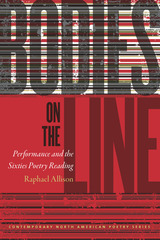 Bodies on the Line: Performance and the Sixties Poetry Reading
Raphael Allison
University of Iowa Press, 2014 Bodies on the Line offers the first sustained study of the poetry reading in its most formative period: the 1960s. Raphael Allison closely examines a vast archive of audio recordings of several key postwar American poets to explore the social and literary context of the sixties poetry reading, which is characterized by contrasting differing styles of performance: the humanist style and the skeptical strain. The humanist style, made mainstream by the Beats and their imitators, is characterized by faith in the power of presence, emotional communion, and affect. The skeptical strain emphasizes openness of interpretation and multivalent meaning, a lack of stability or consistency, and ironic detachment.
By comparing these two dominant styles of reading, Allison argues that attention to sixties poetry readings reveals poets struggling between the kind of immediacy and presence that readings suggested and a private retreat from such performance-based publicity, one centered on the text itself. Recordings of Robert Frost, Charles Olson, Gwendolyn Brooks, Larry Eigner, and William Carlos Williams—all of whom emphasized voice, breath, and spoken language and who were inveterate professional readers in the sixties—expose this struggle in often surprising ways. In deconstructing assertions about the role and importance of the poetry reading during this period, Allison reveals just how dramatic, political, and contentious poetry readings could be. By discussing how to "hear" as well as "read" poetry, Bodies on the Line offers startling new vantage points from which to understand American poetry since the 1960s as both performance and text.
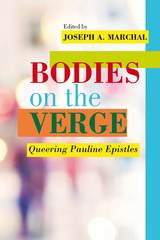 Bodies on the Verge: Queering Pauline Epistles
Joseph A. Marchal
SBL Press, 2019 A collection that resets the terms of interpreting the Pauline letters
Interpretation of Paul's letters often proves troubling, since people frequently cite them when debating controversial matters of gender and sexuality. Rather than focusing on the more common defensive responses to those expected prooftexts that supposedly address homosexuality, the essays in this collection reflect the range, rigor, vitality, and creativity of other interpretive options influenced by queer studies. Thus key concepts and practices for understanding these letters in terms of history, theology, empire, gender, race, and ethnicity, among others, are rethought through queer interventions within both ancient settings and more recent history and literature.
Features:
- New options for how to interpret and use Paul's letters, particularly in light of their use in debates about sexuality and gender
- Developing approaches in queer studies that help with understanding and using Pauline letters and interpretations differently
- Key reflections on the two "clobber passages" (Rom 1:26-27 and 1 Cor 6:9) that demonstrate the relevance of a far wider range of texts throughout the Pauline corpus
 Bodies, Pleasures, and Passions: Sexual Culture in Contemporary Brazil, Second Edition
Richard G. Parker
Vanderbilt University Press, 2009 Winner of the Ruth Benedict Prize from the Society of Lesbian and Gay Anthropologists
Originally published in the early 1990s, Bodies, Pleasures, and Passions quickly became a classic ethnographic study of the social, cultural and historical construction of sexuality and sexual diversity. Drawing on extensive field research and interviews, together with the analysis of historical and literary texts, anthropologist Richard Parker mapped out the multiple cultural systems that structure gender, sexuality, and erotic practices in Brazil, and helped to open up a new wave of social science research on sexuality.
Using ethnographic methods focusing on sexual meanings as an alternative to traditional surveys of sexual behavior, Parker argues that sexual life can only be fully understood through an analysis of the cultural logics that shape experience. Drawing on the tradition of interpretive anthropology, he focuses on the diverse sexual scripts that have been articulated in Brazilian culture and examines the often contradictory ways in which these scripts shape the sexual experience of different individuals. He highlights the sexual socialization of children and young people, and the changing sexual realities of adults living in a rapidly changing world. He underlines the ways in which complex cultural forms such as carnaval can be understood as stories that Brazilians tell themselves about themselves and about the meaning of sexuality in contemporary Brazilian life.
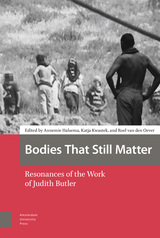 Bodies That Still Matter: Resonances of the Work of Judith Butler
Annemie Halsema
Amsterdam University Press, 2021 Since the appearance of her early-career bestseller Gender Trouble in 1990, American philosopher Judith Butler is one of the most influential thinkers in academia. Her work addresses numerous socially pertinent topics such as gender normativity, political speech, media representations of war, the democratic power of assembling bodies, and the force of nonviolence. The volume Bodies That Still Matter: Resonances of the Work of Judith Butler brings together essays from scholars across academic disciplines who apply, reflect on, and further Butler’s ideas in their own research. It includes a new essay by Butler herself, from which it takes its title. Organized around four key themes in Butler’s scholarship – performativity, speech, precarity, and assembly – the volume offers an excellent introduction to the contemporary relevance of Butler’s thinking, a multi-perspectival approach to key topics of contemporary critical theory, and a testimony to the vibrant interdisciplinary discourses characterizing much of today’s humanities research.
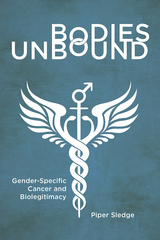 Bodies Unbound: Gender-Specific Cancer and Biolegitimacy
Piper Sledge
Rutgers University Press, 2021 Bodies Unbound is a comparative study showing how ideologies of gendered bodies shape medical care and the ways in which patients respond to these ideologies through decisions about their bodies using three cases: transgender men seeking preventative gynecological care, cisgender men diagnosed with breast cancer, and cisgender women with breast cancer who elect to undergo prophylactic mastectomies. Bodies Unbound is a story about how the relationship between bodies and gender becomes socially intelligible as well as how medical professionals use their position of relative authority over bodies to dictate which combinations of bodies and genders are legitimate or not. Drawing on the experiences of individuals whose bodies and gender identities don't match medical and social expectations for gynecological and breast cancer care, Sledge unravels the taken-for-granted alignment of bodies and gender that provide the foundation of medical care in the United States.
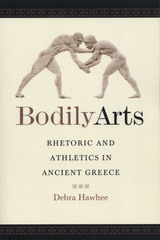 Bodily Arts: Rhetoric and Athletics in Ancient Greece
By Debra Hawhee
University of Texas Press, 2005 The role of athletics in ancient Greece extended well beyond the realms of kinesiology, competition, and entertainment. In teaching and philosophy, athletic practices overlapped with rhetorical ones and formed a shared mode of knowledge production. Bodily Arts examines this intriguing intersection, offering an important context for understanding the attitudes of ancient Greeks toward themselves and their environment. In classical society, rhetoric was an activity, one that was in essence "performed." Detailing how athletics came to be rhetoric's "twin art" in the bodily aspects of learning and performance, Bodily Arts draws on diverse orators and philosophers such as Isocrates, Demosthenes, and Plato, as well as medical treatises and a wealth of artifacts from the time, including statues and vases. Debra Hawhee's insightful study spotlights the notion of a classical gymnasium as the location for a habitual "mingling" of athletic and rhetorical performances, and the use of ancient athletic instruction to create rhetorical training based on rhythm, repetition, and response. Presenting her data against the backdrop of a broad cultural perspective rather than a narrow disciplinary one, Hawhee presents a pioneering interpretation of Greek civilization from the sixth, fifth, and fourth centuries BCE by observing its citizens in action.
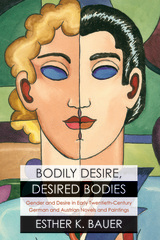 Bodily Desire, Desired Bodies: Gender and Desire in Early Twentieth-Century German and Austrian Novels and Paintings
Esther K. Bauer
Northwestern University Press, 2014 Bodily Desire, Desired Bodies examines the diverse ways that literary works and paintings can be read as screens onto which new images of masculinity and femininity are cast. Esther Bauer focuses on German and Austrian writers and artists from the 1910s and 1920s —specifically authors Franz Kafka, Vicki Baum, and Thomas Mann, and painters Otto Dix, Christian Schad, and Egon Schiele—who gave spectacular expression to shifting trends in male and female social roles and the organization of physical desire and the sexual body.
Bauer’s comparative approach reveals the ways in which artists and writers echoed one another in undermining the gender duality and highlighting sexuality and the body. As she points out, as sites of negotiation and innovation, these works reconfigured bodies of desire against prevailing notions of sexual difference and physical attraction and thus became instruments of social transformation.
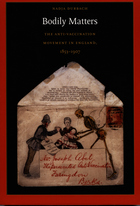 Bodily Matters: The Anti-Vaccination Movement in England, 1853–1907
Nadja Durbach
Duke University Press, 2005 Bodily Matters explores the anti-vaccination movement that emerged in England in the late nineteenth century and early twentieth in response to government-mandated smallpox vaccination. By requiring a painful and sometimes dangerous medical procedure for all infants, the Compulsory Vaccination Act set an important precedent for state regulation of bodies. From its inception in 1853 until its demise in 1907, the compulsory smallpox vaccine was fiercely resisted, largely by members of the working class who interpreted it as an infringement of their rights as citizens and a violation of their children’s bodies. Nadja Durbach contends that the anti-vaccination movement is historically significant not only because it was arguably the largest medical resistance campaign ever mounted in Europe but also because it clearly articulated pervasive anxieties regarding the integrity of the body and the role of the modern state. Analyzing historical documents on both sides of the vaccination debate, Durbach focuses on the key events and rhetorical strategies of the resistance campaign. She shows that those for and against the vaccine had very different ideas about how human bodies worked and how best to safeguard them from disease. Individuals opposed to mandatory vaccination saw their own and their children’s bodies not as potentially contagious and thus dangerous to society but rather as highly vulnerable to contamination and violation. Bodily Matters challenges the notion that resistance to vaccination can best be understood, and thus easily dismissed, as the ravings of an unscientific “lunatic fringe.” It locates the anti-vaccination movement at the very center of broad public debates in Victorian England over medical developments, the politics of class, the extent of government intervention into the private lives of its citizens, and the values of a liberal society.
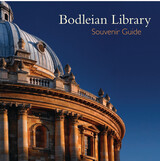 Bodleian Library Souvenir Guide
Geoffrey Tyack
Bodleian Library Publishing, 2014 One of the oldest libraries in Britain, the Bodleian Library has been in continuous use since its founding in 1602 by Sir Thomas Bodley. This richly illustrated guidebook is perfect for architectural aficionados or those planning a trip. A short introduction that gives the story of the library’s founding is followed by a succinct guide to the buildings found there, from Duke Humfrey’s Library to the Divinity School, Convocation House, Schools Quadrangle, Clarendon Building, and Radcliffe Camera.
Bodleian Library Souvenir Guide covers more than four centuries of the library’s most celebrated architecture, taking a look back at the contributions of famous architects like Sir Christopher Wren and Nicholas Hawksmoor. In addition to the buildings themselves, the book illustrates some of the Bodleian’s most exquisite stonemasonry and statuary found there. It also provides translations to the intriguing Latin inscriptions that adorn many of the buildings and mark key moments in the library’s history. The book is brought up-to-date with a description of subsequent renovations, including the addition of the state-of-the-art Weston Library to house the library’s special collections.
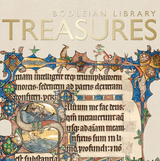 Bodleian Library Treasures
David Vaisey
Bodleian Library Publishing, 2017 Since its founding, the Bodleian Library has become home to treasures from throughout history and every corner of the globe. From among this remarkable and historically rich collection, David Vaisey has selected nearly one hundred treasures with a particularly fascinating story to tell.
Rare books, music, manuscripts, ephemera, and maps, many of the treasures photographed and described for this lavish volume are well-loved around the world, from Jane Austen’s manuscript of The Watsons to notebooks created by the poet Percy Bysshe Shelley, a map of Narnia drawn by C. S. Lewis, and the original manuscript of the renowned children’s work The Wind in the Willows. Others are known for their beauty or historical significance, including the Gutenberg Bible, Magna Carta, and the extraordinary medieval manuscript the Douce Apocalypse. Still others hold poignant stories like the small handwritten book presented as a New Year’s present in 1545 to Katherine Parr by an eleven-year-old stepdaughter who would later become Queen Elizabeth I. Vaisey brings these and other treasures together in chronological order, showcasing the Bodleian Library’s renowned collections.
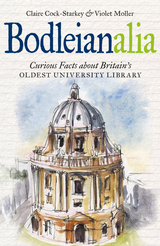 Bodleianalia: Curious Facts about Britain's Oldest University Library
Claire Cock-Starkey and Violet Moller
Bodleian Library Publishing, 2016 Which is the smallest book in the Bodleian Library? How many miles of shelving are there in its Book Storage Facility? What is fasciculing? Who complained when their secret pen name was revealed in the library’s catalog? Why did the library refuse to lend a book to King Charles I? The answers to these questions are just a few of the remarkable bits of bibliophile trivia uncovered by Claire Cock-Starkey and Violet Moller in this intriguing collection of curious facts about one of Britain’s oldest university library.
With more than twelve million items and many priceless treasures, including the Gutenberg Bible, Shakespeare’s First Folio, five thirteenth-century copies of Magna Carta, and Tolkien’s original watercolors for The Hobbit, the Bodleian also boasts many strange events and eccentric characters through the ages that contributed to its world-class renown today. From deep within the archives, Cock-Starkey and Moller have compiled a great many lesser-known facts about the Bodleian Library’s fascinating history, organizing them into easily browsable lists, factoids, and statistics.
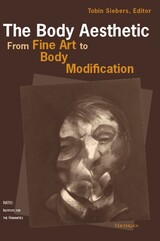 The Body Aesthetic: From Fine Art to Body Modification
Tobin Siebers, Editor
University of Michigan Press, 2000 The last thirty years of cultural theory have seen a vigorous analytic focus on the human body both as the subject of cultural representations and as an escape from their repressive influence. Rare is the account that focuses on the most obvious fact about the body: it is the stuff out of which human beings are made.
Generously and variously illustrated, this volume gathers together the work of literary critics and artists, classicists, art historians, and specialists on the history of the body, who survey the strangeness and variety with which the body has given human beings form. Richard Leppert traces how the representation of little girls responds directly to the cultural anxieties of modernity. René Girard plots how starvation becomes an art form, while Eric Gans surveys the contemporary phenomenon of body modification. Sander Gilman explores aesthetic surgery as a response to human unhappiness. Simon Goldhill discovers in the Roman empire the initial stirrings of institutions that focus on the spectacle of the body, and Cynthia S. Greig provides a glimpse of what the history of photography would look like if male nudes replaced female ones. Marion Jackson details how the different physical existence of the Inuit guides the way they make art. Joseph Grigely transforms aesthetics as usual by focusing on the disabled body, while Tobin Siebers describes the traumatic appeal in both fine art and the media of wounded flesh, whether human or animal.
The Body Aesthetic is a broad exercise in cultural studies and will address a variety of readers, from those interested in detailed, theoretical accounts of the body, to those interested in belles lettres, to those interested in fine art.
Tobin Siebers is Professor of English, University of Michigan.
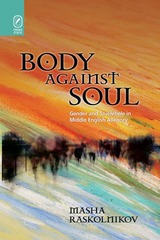 Body Against Soul: Gender and Sowlehele in Middle English Allegory
Masha Raskolnikov
Ohio State University Press, 2009 In medieval allegory, Body and Soul were often pitted against one another in debate. In Body Against Soul: Gender and Sowlehele in Middle English Allegory, Masha Raskolnikov argues that such debates function as a mode of thinking about psychology, gender, and power in the Middle Ages. Neither theological nor medical in nature, works of sowlehele (“soul-heal”) described the self to itself in everyday language—moderns might call this kind of writing “self-help.” Bringing together contemporary feminist and queer theory along with medieval psychological thought, Body Against Soul examines Piers Plowman, the “Katherine Group,” and the history of psychological allegory and debate. In so doing, it rewrites the history of the Body to include its recently neglected fellow, the Soul.
The topic of this book is one that runs through all of Western history and remains of primary interest to modern theorists—how “my” body relates to “me.” In the allegorical tradition traced by this study, a male person could imagine himself as a being populated by female personifications, because Latin and Romance languages tended to gender abstract nouns as female. However, since Middle English had ceased to inflect abstract nouns as male or female, writers were free to gender abstractions like “Will” or “Reason” any way they liked. This permitted some psychological allegories to avoid the representational tension caused by placing a female soul inside a male body, instead creating surprisingly queer same-sex inner worlds. The didactic intent driving sowlehele is, it turns out, complicated by the erotics of the struggle to establish a hierarchy of the self’s inner powers.
The Body Alone: A Lyrical Articulation of Chronic Pain
Nina Lohman
University of Iowa Press, 2024 The Body Alone is an inquiry into the experience, meaning, and articulation of pain. It is a personal hybrid account incorporating research, scholarship, and memoir to examine chronic pain through the multi-lens of medicine, theology, and philosophy. Broken bodies tell broken stories. Nina Lohman’s pain experience is portrayed through a cyclical narrative of primers, vocabulary lessons, prescription records, and hypothesized internal monologues—fractured not for the sake of experimentation but because the story itself demands it.
In both form and content, The Body Alone represents boundary-pressing work that subverts the traditional narrative by putting pressure on the medical, cultural, and political systems that impact women’s access to fair and equal healthcare. This is more than an illness narrative, it is a battle cry demanding change.
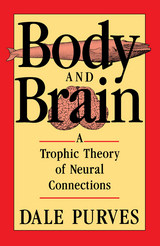 Body and Brain: A Trophic Theory of Neural Connections
Dale Purves
Harvard University Press, 1988 The major goal of developmental neurobiology is to understand how the nervous system is put together. A central theme that has emerged from research in this field over the last several decades is the crucial role of trophic interactions in neural assembly, and indeed throughout an animal's life. Trophic—which means nutritive—refers to long-term interdependencies between nerve cells and the cells they innervate.
The theory of trophic effects presented in this book offers an explanation of how the vertebrate nervous system is related to—and regulated by—the body it serves. The theory rationalizes the nervous system's accommodation, throughout life, to the changing size and form of the body it tenants, indicating the way connections between nerve cells change in response to stimuli as diverse as growth, injury, experience, and natural selection.
Dale Purves, a leading neurobiologist best known for his work on the formation and maintenance of synaptic connections, presents this theory within the historical setting of earlier ideas about neural organization—from Weiss's theory of functional reorganization to the chemoaffinity theory championed by Sperry. In addition to illuminating eighty years of work on trophic interactions, this book asks its own compelling questions: Are trophic interactions characteristic of all animals or only of those with complex nervous systems? Are trophic interactions related to learning? What does the trophic theory of neural connections imply about the currently fashionable view that the nervous system operates according to Darwinian principles?
Purves lays the theoretical foundation for practical exploration of trophic interactions as they apply to neural connections, a pursuit that will help us understand how our own nervous systems generate change. The ideas in this book not only enrich neurobiology but also convey the profound relevance of neuroscience to other fields of life science.
 Body and Enhancement Technology
Eunjeong Ma, editor
Duke University Press, 2016 A special issue of East Asian Science, Technology and Society: An International Journal This issue explores the practice of applying science and technology to expand our cognitive and physical capacities. Covering global Asia, these articles investigate enhancement in relation to aesthetics, genetics, cognition, and musculature and consider enhancement’s ethical and societal implications. The contributors address a range of topics—from elite sports to the socioeconomics of plastic surgery in South Korea to memory devices in Blade Runner—and problematize increasing efforts to engineer and augment human bodily functions. This issue illustrates how the emergence of new technologies and their merging with the body will challenge our perception of normal human conditions: our physical strength, our appearance, and our cognitive capabilities. Contributors Eduardo Zachary Albrecht, Masato Fukushima, Jaehwan Hyun, So Yeon Leem, Eunjeong Ma
 Body and Face in Chinese Visual Culture
Hung Wu
Harvard University Press, 2005 Traditionally the "Chinese body" was approached as a totality and explained by sweeping comparisons of the differences that distinguished Chinese examples from their Western counterparts. Recently, scholars have argued that we must look at particular examples of Chinese images of the body and explore their intrinsic conceptual complexity and historical specificity.
The twelve contributors to this volume adopt a middle position. They agree that Chinese images are conditioned by indigenous traditions and dynamics of social interaction, but they seek to explain a general Chinese body and face by charting multiple, specific bodies and faces. All of the chapters are historical case studies and investigate particular images, such as Han dynasty tomb figurines; Buddhist texts and illustrations; pictures of deprivation, illness, deformity, and ghosts; clothing; formal portraiture; and modern photographs and films. From the diversity of art forms and historical periods studied, there emerges a more complex picture of ways that the visual culture of the body and face in China has served to depict the living, memorialize the dead, and present the unrepresentable in art.
Body and Mind in Motion: Dance and Neuroscience in Conversation
Glenna Batson with Margaret Wilson
Intellect Books, 2014 Western contemporary dance and body-mind education have engaged in a pas de deux for more than four decades. The rich interchange of somatics and dance has altered both fields, but scholarship that substantiates these ideas through the findings of twentieth-century scientific advances has been missing. This book fills that gap and brings to light contemporary discoveries of neuroscience and somatic education as they relate to dance. Drawing from the burgeoning field of “embodiment”—itself an idea at the intersection of the sciences, humanities, arts, and technologies—Body and Mind in Motion highlights the relevance of somatic education within dance education, dance science, and body-mind studies.
Body and Mind: Second Edition
Keith Campbell
University of Notre Dame Press, 1984 Widely used in philosophy courses, this succinct study explores the problem of determining the relation between the body and mind. In that philosophy seeks to elucidate man’s place and action in nature, Campbell asserts that our assessment of the body-mind problem affects our perspectives on metaphysics, epistemology, ethics and the natural sciences. After discussing how the body-mind problem developed, Campbell sets forth an inconsistent tetrad of propositions that serves as the framework for evaluating different philosophical approaches to the problem. Among competing perspectives, he examines dualism, behaviorist theories, the causal theory of mind, central-state epiphenomenalism. This revised edition includes a new chapter on functionalism and an expanded bibliography.
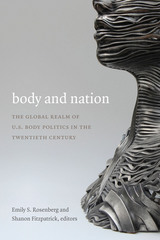 Body and Nation: The Global Realm of U.S. Body Politics in the Twentieth Century
Emily S. Rosenberg and Shanon Fitzpatrick, eds.
Duke University Press, 2014 Body and Nation interrogates the connections among the body, the nation, and the world in twentieth-century U.S. history. The idea that bodies and bodily characteristics are heavily freighted with values that are often linked to political and social spheres remains underdeveloped in the histories of America's relations with the rest of the world. Attentive to diverse state and nonstate actors, the contributors provide historically grounded insights into the transnational dimensions of biopolitics. Their subjects range from the regulation of prostitution in the Philippines by the U.S. Army to Cold War ideals of American feminine beauty, and from "body counts" as metrics of military success to cultural representations of Mexican migrants in the United States as public health threats. By considering bodies as complex, fluctuating, and interrelated sites of meaning, the contributors to this collection offer new insights into the workings of both soft and hard power.
Contributors. Frank Costigliola, Janet M. Davis, Shanon Fitzpatrick, Paul A. Kramer, Shirley Jennifer Lim, Mary Ting Yi Lui, Natalia Molina, Brenda Gayle Plummer, Emily S. Rosenberg, Kristina Shull, Annessa C. Stagner, Marilyn B. Young
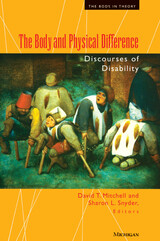 The Body and Physical Difference: Discourses of Disability
David T. Mitchell and Sharon L. Snyder, Editors
University of Michigan Press, 1997 For years the subject of human disability has engaged those in the biological, social and cognitive sciences, while at the same time, it has been curiously neglected within the humanities. The Body and Physical Difference seeks to introduce the field of disability studies into the humanities by exploring the fantasies and fictions that have crystallized around conceptions of physical and cognitive difference. Based on the premise that the significance of disabilities in culture and the arts has been culturally vexed as well as historically erased, the collection probes our society's pathological investment in human variability and "aberrancy." The contributors demonstrate how definitions of disability underpin fundamental concepts such as normalcy, health, bodily integrity, individuality, citizenship, and morality--all terms that define the very essence of what it means to be human.
The book provides a provocative range of topics and perspectives: the absence of physical "otherness" in Ancient Greece, the depiction of the female invalid in Victorian literature, the production of tragic innocence in British and American telethons, the reconstruction of Civil War amputees, and disability as the aesthetic basis for definitions of expendable life within the modern eugenics movement. With this new, secure anchoring in the humanities, disability studies now emerges as a significant strain in contemporary theories of identity and social marginality.
Moving beyond the oversimplication that disabled people are marginalized and made invisible by able-ist assumptions and practices, the contributors demonstrate that representation is founded upon the perpetual exhibition of human anomalies. In this sense, all art can be said to migrate toward the "freakish" and the "grotesque." Such a project paradoxically makes disability the exception and the rule of the desire to represent that which has been traditionally out-of-bounds in polite discourse.
The Body and Physical Difference has relevance across a wide range of academic specialties such as cultural studies, the sociology of medicine, history, literature and medicine, the allied health professions, rehabilitation, aesthetics, philosophical discourses of the body, literary and film studies, and narrative theory.
David T. Mitchell is Assistant Professor of English, Northern Michigan University. Sharon L. Snyder teaches film and literature at Northern Michigan University.
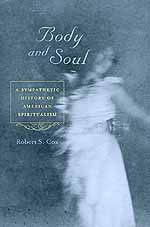 Body and Soul: A Sympathetic History of American Spiritualism
Robert S. Cox
University of Virginia Press, 2003 A product of the "spiritual hothouse" of the Second Great Awakening, Spiritualism became the fastest growing religion in the nation during the 1850s, and one of the principal responses to the widespread perception that American society was descending into atomistic particularity.
In Body and Soul, Robert Cox shows how Spiritualism sought to transform sympathy into social practice, arguing that each individual, living and dead, was poised within a nexus of affect, and through the active propagation of these sympathetic bonds, a new and coherent society would emerge. Phenomena such as spontaneous somnambulism and sympathetic communion with the dead--whether through séance or "spirit photography"
--were ways of transcending the barriers dissecting the American body politic, including the ultimate barrier, death. Drawing equally upon social, occult, and physiological registers, Spiritualism created a unique "social physiology" in which mind was integrated into body and body into society, leading Spiritualists into earthly social reforms, such as women's rights and antislavery.
From the beginning, however, Spiritualist political and social expression was far more diverse than has previously been recognized, encompassing distinctive proslavery and antiegalitarian strains, and in the wake of racial and political adjustments following the Civil War, the movement began to fracture. Cox traces the eventual dissolution of Spiritualism through the contradictions of its various regional and racial factions and through their increasingly circumscribed responses to a changing world. In the end, he concludes, the history of Spiritualism was written in the limits of sympathy, and not its limitless potential.
--------------------------------------------------------------------------------
Robert S. Cox is Curator of Manuscripts at the American Philosophical Society.
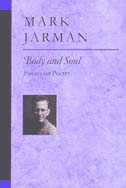 Body and Soul: Essays on Poetry
Mark Jarman
University of Michigan Press, 2002 Mark Jarman, author of the narrative poem Iris and the lyric sequence Unholy Sonnets, is a poet associated with the revival of narrative and traditional form in contemporary American poetry. In Body and Soul he considers poetry from the Renaissance to the present in essays that touch on the importance of religion, place, and personal experience to poetry and reflect Jarman's particular interests. His focus is on the relationship between lyric and narrative, song and story, in poems of all kinds. He considers the poem as a record of both body and soul, and examines his own life, in an extended autobiographical essay, as a source for the stories he has told in his poetry.
The essays "Where Poems Take Place" and "A Shared Humanity" consider the relation between setting or situation and representation. The psychological roots of narrative are considered in "The Primal Storyteller." But the main interest of these essays is how and why narrative is used as a form. The influence of Robinson Jeffers's style of narrative is argued in "Slip, Shift, and Speed Up: The Influence of Robinson Jeffers's Narrative Syntax." In "The Trace of a Story Line" an argument is made that the poets Philip Levine and Charles Wright employ narration or storytelling in their poetry as a mode of meaning. Other essays consider Donald Davie, Philip Larkin, Herbert Lomas, Louis Simpson, Lyn Hejinian, Tess Gallagher, and Ellen Bryant Voigt.
Mark Jarman's poetry has appeared in many publications, including the American Poetry Review and the New Yorker. He has won the Lenore Marshall/Nation Prize of the Academy of American Poets, a Guggenheim fellowship, and multiple grants from the National Endowment for the Arts. He is Professor of English, Vanderbilt University.
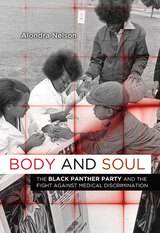 Body and Soul: The Black Panther Party and the Fight against Medical Discrimination
Alondra Nelson
University of Minnesota Press, 2013 Between its founding in 1966 and its formal end in 1980, the Black Panther Party blazed a distinctive trail in American political culture. The Black Panthers are most often remembered for their revolutionary rhetoric and militant action. Here Alondra Nelson deftly recovers an indispensable but lesser-known aspect of the organization’s broader struggle for social justice: health care. The Black Panther Party’s health activism—its network of free health clinics, its campaign to raise awareness about genetic disease, and its challenges to medical discrimination—was an expression of its founding political philosophy and also a recognition that poor blacks were both underserved by mainstream medicine and overexposed to its harms. Drawing on extensive historical research as well as interviews with former members of the Black Panther Party, Nelson argues that the Party’s focus on health care was both practical and ideological. Building on a long tradition of medical self-sufficiency among African Americans, the Panthers’ People’s Free Medical Clinics administered basic preventive care, tested for lead poisoning and hypertension, and helped with housing, employment, and social services. In 1971, the party launched a campaign to address sickle-cell anemia. In addition to establishing screening programs and educational outreach efforts, it exposed the racial biases of the medical system that had largely ignored sickle-cell anemia, a disease that predominantly affected people of African descent. The Black Panther Party’s understanding of health as a basic human right and its engagement with the social implications of genetics anticipated current debates about the politics of health and race. That legacy—and that struggle—continues today in the commitment of health activists and the fight for universal health care.
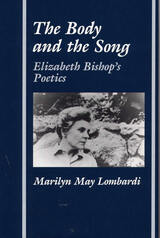 The Body and the Song: Elizabeth Bishop's Poetics
Marilyn May Lombardi
Southern Illinois University Press, 1995
In this original contribution to Elizabeth Bishop studies, Marilyn May Lombardi uses previously unpublished materials (letters, diaries, notebooks, and unfinished poems) to shed new light on the poet’s published work. She explores the ways Bishop’s lesbianism, alcoholism, allergic illnesses, and fear of mental instability affected her poetry—the ways she translated her bodily experiences into poetic form.
A cornerstone of The Body and the Song is the poet’s thirty-year correspondence with her physician, Dr. Anny Baumann, who was both friend and surrogate mother to Bishop. The letters reveal Bishop’s struggles to understand the relation between her physical and creative drives. "Dr. Anny" also helped Bishop unravel the connections in her life between psychosomatic illness and early maternal deprivation—her mother was declared incurably insane and institutionalized in 1916, when Bishop was five years old. Effectively an orphan, she spent the rest of her childhood with relatives.
In addition to these letters, Lombardi uses Bishop’s unpublished notebooks to demonstrate the poet’s resolve to "face the facts"—to confront her own emotional, intellectual, and physical frailties—and translate them into poetry that is clear-eyed and economical in its form.
Lombardi argues that in her subtle way, Bishop explores the same issues that preoccupy the current generation of women writers. A deeply private artist, Bishop never directly refers to her homosexuality in her published work, but the metaphors she draws from her carnal desires and aversions confront stifling cultural prescriptions for personal and erotic expression. In choosing restraint over confession, Bishop parted company with her friend Robert Lowell, but Lombardi shows that her reticence becomes a powerful artistic strategy resulting in poetry remarkable for its hermeneutic potential.
Informed by recent gender criticism, Lombardi’s lucid argument advances our understanding of the ways the material circumstances of life can be transformed into art.
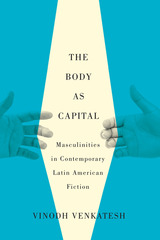 The Body as Capital: Masculinities in Contemporary Latin American Fiction
Vinodh Venkatesh
University of Arizona Press, 2015 Through economic liberalization and the untethering of labor and production markets, masculinity as hegemon has entered a crisis stage. Renegotiated labor and familial orders have triggered a widespread cultural renegotiation of how masculinity operates and is represented. This holds especially true in Latin America.
Addressing this, Vinodh Venkatesh uses contemporary Latin American literature to examine how masculinity is constructed and conceived. The Body as Capital centers socioeconomic and political concerns, anxieties, and paradigms on the male anatomy and on the matrices of masculinities presented in fiction. Developing concepts such as the “market of masculinities” and the “transnational theater of masculinities,” the author explains how contemporary fiction centers the male body and masculine expressions as key components in the relationship between culture, space, and global tensile forces.
Venkatesh includes novels by canonical and newer writers from Mexico, Central America, the Caribbean, Peru, and Chile. He focuses on texts produced after 1990, coinciding with what has popularly been termed the neoliberal experiment. In addition to probing well-known novels such as La fiesta del Chivo and La mujer habitada and their accompanying body of criticism, The Body as Capital defines and examines several masculine tropes that will be of interest to scholars of contemporary Latin American literature and gender studies. Ultimately, Venkatesh argues for a more holistic approximation of discursive gender that will feed into other angles of criticism, forging a new path in the critical debates over gender and sexuality in Latin American writing.
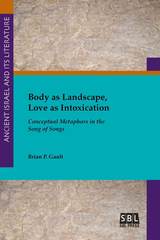 Body as Landscape, Love as Intoxication: Conceptual Metaphors in the Song of Songs
Brian P. Gault
SBL Press, 2019 Explore metaphors in the exquisite and enigmatic poetry of Song of Songs
One of the chief difficulties in interpreting the Song's lyrics is the unusual imagery used to depict the lovers' bodies. Why is the maiden's hair compared to a flock of goats (4:1), the man’s cheeks likened to garden beds of spice (5:13), and the eyes of both lovers described as doves (4:1; 5:12)? While scholars speculate on the significance of these images, a systematic inquiry into the Song's body metaphors is curiously absent. Based on insights from cognitive linguistics, this study incorporates biblical and comparative data to uncover the meaning of these metaphors surveying literature in the eastern Mediterranean (and beyond) that shares a similar form (poetry) and theme (love). Gault presents an interpretation of the Song's body imagery that sheds light on the perception of beauty in Israel and its relationship to surrounding cultures.
Features
- Exploration of the Song's use of universal themes and culturally specific variations
- Discussion of the Song's literary structure and unity
Body Battlegrounds: Transgressions, Tensions, and Transformations
Chris Bobel
Vanderbilt University Press, 2019 Body Battlegrounds explores the rich and complex lives of society's body outlaws—individuals from myriad social locations who oppose hegemonic norms, customs, and conventions about the body. Original research chapters (based on textual analysis, qualitative interviews, and participant observation) along with personal narratives provide a window into the everyday lives of people rewriting the norms of embodiment in sites like schools, sporting events, and doctors' offices.
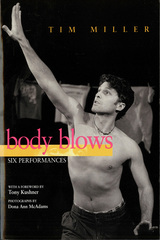 Body Blows: Six Performances
Tim Miller
University of Wisconsin Press, 2002 Hailed for his humor and passion, the internationally acclaimed performance artist Tim Miller has delighted, shocked, and emboldened audiences all over the world. Body Blows gathers six of Miller’s best-known performances that chart the sexual, spiritual, and political topography of his identity as a gay man: Some Golden States, Stretch Marks, My Queer Body, Naked Breath, Fruit Cocktail, and Glory Box. In Body Blows, Tim Miller leaps from the stage to the page, as each performance script is illustrated with striking photographs and accompanied by Miller’s notes and comment.
This book explores the tangible body blows—taken and given—of Miller’s life and times as explored in his performances: the queer-basher’s blow, the sweet blowing breath of a lover, the below-the-belt blow of HIV/AIDS, the psychic blows from a society that disrespects the humanity of lesbian and gay relationships. Miller’s performances are full of the put-up-your-dukes and stand-your-ground of such day-to-day blows that make up being gay in America
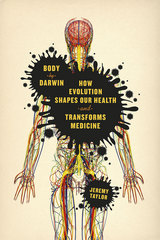 Body by Darwin: How Evolution Shapes Our Health and Transforms Medicine
Jeremy Taylor
University of Chicago Press, 2015 We think of medical science and doctors as focused on treating conditions—whether it’s a cough or an aching back. But the sicknesses and complaints that cause us to seek medical attention actually have deeper origins than the superficial germs and behaviors we regularly fault. In fact, as Jeremy Taylor shows in Body by Darwin, we can trace the roots of many medical conditions through our evolutionary history, revealing what has made us susceptible to certain illnesses and ailments over time and how we can use that knowledge to help us treat or prevent problems in the future.
In Body by Darwin, Taylor examines the evolutionary origins of some of our most common and serious health issues. To begin, he looks at the hygiene hypothesis, which argues that our obsession with anti-bacterial cleanliness, particularly at a young age, may be making us more vulnerable to autoimmune and allergic diseases. He also discusses diseases of the eye, the medical consequences of bipedalism as they relate to all those aches and pains in our backs and knees, the rise of Alzheimer’s disease, and how cancers become so malignant that they kill us despite the toxic chemotherapy we throw at them. Taylor explains why it helps to think about heart disease in relation to the demands of an ever-growing, dense, muscular pump that requires increasing amounts of nutrients, and he discusses how walking upright and giving birth to ever larger babies led to a problematic compromise in the design of the female spine and pelvis. Throughout, he not only explores the impact of evolution on human form and function, but he integrates science with stories from actual patients and doctors, closely examining the implications for our health.
As Taylor shows, evolutionary medicine allows us think about the human body and its adaptations in a completely new and productive way. By exploring how our body’s performance is shaped by its past, Body by Darwin draws powerful connections between our ancient human history and the future of potential medical advances that can harness this knowledge.
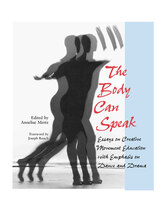 The Body Can Speak: Essays on Creative Movement Education with Emphasis on Dance and Drama
Edited by Annelise Mertz. Foreword by Joseph Roach
Southern Illinois University Press, 2002 Movement is our first language, our universal language. Expression of body movement is the very basis of life as the nineteen contributors to The Body Can Speak: Essays on Creative Movement Education with Emphasis on Dance and Drama attest. Students use their bodies as an instrument of expression, and movement as medium; this means investigating space, energy, time, and motion in order to gain insight into these basic principles. At the same time they gain essential awareness of the self. Such work stimulates the senses and intellect, and develops a tangible new vision to satisfy the human need for aesthetic and artistic expression. As editor of this collection, accomplished dancer and artistic director Annelise Mertz provides both an aesthetic appreciation for creative movement education as well as practical pedagogy for incorporating dance and drama into contemporary curriculum. Mertz has assembled here a definitive body of work from fellow artists and former students that speaks to the need to actively promote art as part of education. The book gives voice to accomplished teachers, actors, dancers, directors, authors, and choreographers who share their experiences while they address creative movement education from preschool through college. Forty-eight photographs add an illuminating visual dimension to this wealth of stimulating ideas. The Body Can Speak provides a balanced and varied mosaic, with each essay offering evidence that creative movement education is vital for human development. Contributors include Becky Engler-Hicks, Ruth Grauert, Anna Halprin, Joanna G. Harris, Margaret N. H’Doubler, Michael Hoeye, Murray Louis, Annelise Mertz, Jaime Nisenbaum, Carol North, Jeff Rehg, Shirley Ririe, G. Hoffman Soto, Emma D. Sheehy, Harold Taylor, Branislav Tomich, Dorothy M. Vislocky, and Joan J. Woodbury.
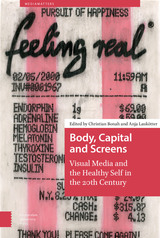 Body, Capital and Screens: Visual Media and the Healthy Self in the 20th Century
Christian Bonah
Amsterdam University Press, 2020 Body, Capital and Screens: Visual Media and the Healthy Self in the 20th Century brings together new research from leading scholars from Europe and North America working at the intersection of film and media studies and social and cultural history of the body. The volume focuses on visual media in the twentieth century in Europe and the U.S. that informed and educated people about life and health as well as practices improving them. Through a series of in-depth case studies, the contributors to this volume investigate the relationships between film/television, private and public actors of the health sector and economic developments. The book explores the performative and interactive power of these visual media on individual health understandings, perceptions and practices. Body, Capital and Screens aims to better understand how bodily health has evolved as a form of capital throughout the century.
The Body Distances (A Hundred Blackbirds Rising)
Mark Wagenaar
University of Massachusetts Press, 2016 Let no lip, shoulder, hip, go untasted tonight. Let no one be unscathed.
And as you close the door & fold yourself in sleep against another
look for a moment at the empty stretch of dark between heaven
& earth: someone is missing from the world . . .
The Body Distances is filled with long, limber, nimble poems at once ecstatic and elegiac. These poems are odes to the miraculous embedded in the everyday, in which “the unlikely continues / to dovetail with the present.”
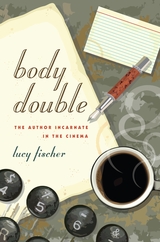 Body Double: The Author Incarnate in the Cinema
Lucy Fischer
Rutgers University Press, 2013 Body Double explores the myriad ways that film artists have represented the creative process. In this highly innovative work, Lucy Fischer draws on a neglected element of auteur studies to show that filmmakers frequently raise questions about the paradoxes of authorship by portraying the onscreen writer. Dealing with such varied topics as the icon of the typewriter, the case of the writer/director, the authoress, and the omnipresent infirm author, she probes the ways in which films can tell a plausible story while contemplating the conditions and theories of their making.
By examining many forms of cinema, from Hollywood and the international art cinema to the avant-garde, Fischer considers the gender, age, and mental or physical health of fictionalized writers; the dramatized interaction between artists and their audiences and critics; and the formal play of written words and nonverbal images.
By analyzing such movies as Adaptation,Diary of a Country Priest, Naked Lunch, American Splendor, and Irezumi, Fischer tracks the parallels between film author and character, looking not for the creative figure who stands outside the text, but for the one who stands within it as corporeal presence and alter-ego.
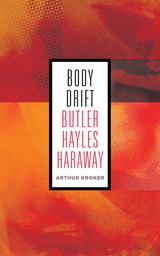 Body Drift: Butler, Hayles, Haraway
Arthur Kroker
University of Minnesota Press, 2012 As exemplary representatives of a form of critical feminism, the writings of Judith Butler, Katherine Hayles, and Donna Haraway offer entry into the great crises of contemporary society, politics, and culture. Butler leads readers to rethink the boundaries of the human in a time of perpetual war. Hayles turns herself into a “writing machine” in order to find a dwelling place for the digital humanities within the austere landscape of the culture of the code. Haraway is the one contemporary thinker to have begun the necessary ethical project of creating a new language of potential reconciliation among previously warring species. According to Arthur Kroker, the postmodernism of Judith Butler, the posthumanism of Katherine Hayles, and the companionism of Donna Haraway are possible pathways to the posthuman future that is captured by the specter of body drift. Body drift refers to the fact that individuals no longer inhabit a body, in any meaningful sense of the term, but rather occupy a multiplicity of bodies: gendered, sexualized, laboring, disciplined, imagined, and technologically augmented. Body drift is constituted by the blast of information culture envisioned by artists, communicated by social networking, and signified by its signs. It is lived daily by remixing, resplicing, and redesigning the codes: codes of gender, sexuality, class, ideology, and identity. The writings of Butler, Hayles, and Haraway, Kroker reveals, provide the critical vocabulary and political context for understanding the deep complexities of body drift and challenging the current emphasis on the material body.
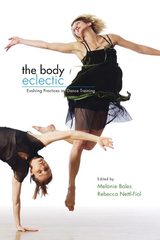 The Body Eclectic: Evolving Practices in Dance Training
Edited by Melanie Bales and Rebecca Nettl-Fiol
University of Illinois Press, 2007 This rich collection of essays and interviews explores modern-dance technique training from the last fifty years. Focusing on the culture of dance, editors Melanie Bales and Rebecca Nettl-Fiol examine choreographic process and style, dancer agency and participation in the creative process, and changes in the role and purpose of training. Bringing recent writings on dance into dialogue with dance practice, The Body Eclectic: Evolving Practices in Dance Training asks readers to consider the relationship between training practices and choreographic style and content. The contributors explore how technique training both guides and reflects the art of dance. Contributors include Melanie Bales, Glenna Batson, Wendell Beavers, Veronica Dittman, Natalie Gilbert, Joshua Monten, Martha Myers, and Rebecca Nettl-Fiol. Dance professionals interviewed include David Dorfman, Ralph Lemon, Bebe Miller, Tere O’Connor, and Shelley Washington.
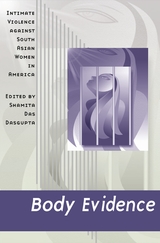 Body Evidence: Intimate Violence against South Asian Women in America
Edited by Shamita Das Dasgupta
Rutgers University Press, 2007 When South Asians immigrated to the United States in great numbers in the 1970s, they were passionately driven to achieve economic stability and socialize the next generation to retain the traditions of their home culture. During these years, the immigrant community went to great lengths to project an impeccable public image by denying the existence of social problems such as domestic violence, sexual assault, child sexual abuse, mental illness, racism, and intergenerational conflict. It was not until recently that activist groups have worked to bring these issues out into the open.
In Body Evidence, more than twenty scholars and public health professionals uncover the unique challenges faced by victims of violence in intimate spaces . . . within families, communities and trusted relationships in South Asian American communities. Topics include cultural obsession with women's chastity and virginity; the continued silence surrounding intimate violence among women who identify themselves as lesbian, bisexual, or transgender; the consequences of refusing marriage proposals or failing to meet dowry demands; and, ultimately, the ways in which the United States courts often confuse and exacerbate the plights of these women.
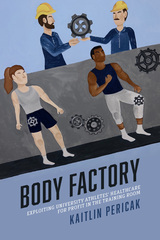 Body Factory: Exploiting University Athletes' Healthcare for Profit in the Training Room
Kaitlin Pericak
Temple University Press, 2025 A university’s athletic training room is meant to care for and heal college athletes and ensure they are receiving the help they need. Although sports medicine staff members are sincere in their goal of centering athletes and providing the best healthcare possible, organizational constraints affect their approach. Chief among them is the pressure sports medicine staff members feel to keep athletes from profit-generating sports healthy enough to perform.
Body Factory enters an NCAA Division I athletic training room to examine the disconnect between what the NCAA states as its goal of athlete healthcare and what is actually happening. Kaitlin Pericak conducts observations in this space and interviews injured athletes and sports medicine staff members to show how institutional control over “best interests” often ends up exploiting the individual athlete. The influences at work are part of a neoliberal paradigm that explains why interest in an athlete’s care is greatly diminished once they are injured and can no longer play.
Body Factory considers how race, gender, and health before and after injury are deciding factors in these university training centers. The bureaucratic organization has a goal of maintaining power to generate profit, and Pericak shows this is almost always at the expense of the athlete.
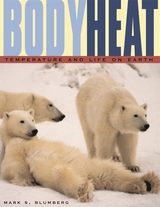 Body Heat: Temperature and Life on Earth
Mark S. Blumberg
Harvard University Press, 2004 Whether you're a polar bear giving birth to cubs in an Arctic winter, a camel going days without water in the desert heat, or merely a suburbanite without air conditioning in a heat wave, your comfort and even survival depend on how well you adapt to extreme temperatures.
In this entertaining and illuminating book, biopsychologist Mark Blumberg explores the many ways that temperature rules the lives of all animals (including us). He moves from the physical principles that govern the flow of heat in and out of our bodies to the many complex evolutionary devices animals use to exploit those principles for their own benefit.
In the process Blumberg tells wonderful stories of evolutionary and scientific ingenuity--how penguins withstand Antarctic winters by huddling together by the thousands, how vulnerable embryos of many species are to extremes of temperature during their development, why people survive hour-long drowning accidents in winter but not in summer, how certain plants generate heat (the skunk cabbage enough to melt snow around it). We also hear of systems gone awry--how desert species given too much water can drink themselves into bloated immobility, why anorexics often complain of feeling cold, and why you can't sleep if the room is too hot or too cold. After reading this book, you'll never look at a thermostat in quite the same way again.
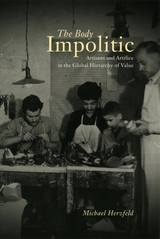 The Body Impolitic: Artisans and Artifice in the Global Hierarchy of Value
Michael Herzfeld
University of Chicago Press, 2003 The Body Impolitic is a critical study of tradition, not merely as an ornament of local and national heritage, but also as a millstone around the necks of those who are condemned to produce it.
Michael Herzfeld takes us inside a rich variety of small-town Cretan artisans' workshops to show how apprentices are systematically thwarted into learning by stealth and guile. This harsh training reinforces a stereotype of artisans as rude and uncultured. Moreover, the same stereotypes that marginalize artisans locally also operate to marginalize Cretans within the Greek nation and Greece itself within the international community. What Herzfeld identifies as "the global hierarchy of value" thus frames the nation's ancient monuments and traditional handicrafts as evidence of incurable "backwardness."
Herzfeld's sensitive observations offer an intimately grounded way of understanding the effects of globalization and of one of its most visible offshoots, the heritage industry, on the lives of ordinary people in many parts of the world today.
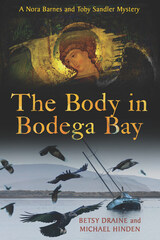 The Body in Bodega Bay: A Nora Barnes and Toby Sandler Mystery
Betsy Draine and Michael Hinden
University of Wisconsin Press, 2014 Life in Bodega Bay on the rugged, foggy coast of northern California has been pretty quiet since Alfred Hitchcock filmed The Birds there. But antiques dealer Toby Sandler learns that his new business partner Charlie has been found dead on an abandoned boat in the harbor. When the local sheriff discovers that Charlie’s newly acquired Hitchcock artifacts and a painting of an angel are missing, he enlists Toby and his wife, Nora Barnes, an art historian, in the investigation.
Local tales about Hitchcock’s famous film, and some digging into the region’s past as a Russian outpost, provide Toby and Nora with clues to the existence of a lost masterpiece. Convinced that this forgotten work may hold the key to the murder, Nora and Toby set out to find it. When Nora’s trouble-prone sister Angie arrives, events take a surprising turn, leading to the uncanny realm of angel reading and putting Nora and her family in danger. As Nora and Toby investigate matters both criminal and otherworldly, Nora realizes that some mysteries in life may be too deep to solve.
The Body in Bodega Bay: A Nora Barnes and Toby Sandler Mystery
Betsy Draine and Michael Hinden
University of Wisconsin Press, 2020 Life in Bodega Bay, famous as the setting for Alfred Hitchcock’s The Birds, has been quiet for antiques dealer Toby Sandler—until his new business partner is found dead in the harbor. Soon, the local sheriff discovers that the victim’s recently acquired Hitchcock artifacts and a painting of an angel have mysteriously vanished. Toby and his wife, art historian Nora Barnes, are enlisted to aid the investigation. As they dig into tales of the area’s past and encounter perplexing clues that are both criminal and otherworldly, the couple contemplates whether some mysteries are too deep to solve.
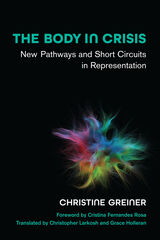 The Body in Crisis: New Pathways and Short Circuits in Representation
Christine Greiner
University of Michigan Press, 2021 The Body in Crisis introduces the English-speaking world to the work of leading Latin American dance scholar and philosopher of the body, Christine Greiner. The book offers an innovative set of tools with which to examine the role of moving bodies and bodily actions in relation to worldwide concerns, including identity politics, alterity, migration, and belonging. The book places the concept of bodymedium in dialogue with the work of Giorgio Agamben to investigate notions of alterity, and shows how an understanding of the body-environment continuum can shed light on things left unnamed and at the margins. Greiner’s analyses draw from a broad range of theory concerned with the epistemology of the body, including cognitive science, political philosophy, evolutionary biology, and performance studies to illuminate radical experiences that question the limits of the body. Her analysis of the role that bodies play in negotiations of power relations offers an original and unprecedented contribution to the field of dance studies and expands its scope to recognize theoretical models of inquiry developed in the Global South.
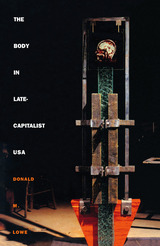 The Body in Late-Capitalist USA
Donald M. Lowe
Duke University Press, 1995 In The Body in Late-Capitalist USA, Donald M. Lowe explores the varied social practices that code and construct the body. Arguing that our bodily lives are shaped by a complex of daily and ongoing practices—how we work, what we buy and consume—Lowe contends that as a result of the commodification of these and other social practices in the late-twentieth century, what we often understand to be the needs of the body are in fact means for capital accumulation.
Moving beyond studies of representations and images of the body, Lowe focuses on the intersection of body practices, language, and the Social to describe concretely the reality of a lived body. His strongly synthetic work brings together Marxist critique, semiotics, Foucaultian discourse analysis, and systems and communications theory to examine those practices that construct the body under late capitalism: habits of work and consumption, the ways we give birth and raise children, socialization, mental and physical healing, reconstructions and contestations of sexuality and gender. Lowe draws upon a wide range of sources, including government and labor studies and statistics, diagnostic and statistical manuals on mental illness, computer manuals, self-help books, and guides to work-related stress disorders, to illustrate the transformation of the body into a nexus of exchange value in postmodern society.
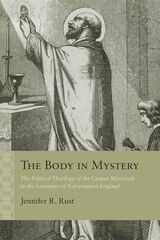 The Body in Mystery: The Political Theology of the Corpus Mysticum in the Literature of Reformation England
Jennifer R. Rust
Northwestern University Press, 2013 In The Body in Mystery, Jennifer R. Rust engages the political concept of the mystical body of the commonwealth, the corpus mysticum of the medieval church. Rust argues that the communitarian ideal of sacramental sociality had a far longer afterlife than has been previously assumed. Reviving a critical discussion of the German historian Ernst Kantorowicz’s 1957 masterwork, The King’s Two Bodies: A Study in Mediaeval Political Theology, Rust brings to bear the latest scholarship. Her book expands the representation of the corpus mysticum through a range of literary genres as well as religious polemics and political discourses. Rust reclaims the concept as an essential category of social value and historical understanding for the imaginative life of literature from Reformation England. The Body in Mystery provides new ways of appreciating the always rich and sometimes difficult continuities between the secular and sacred in early modern England, and between the premodern and early modern periods.
The Body in the Mind: The Bodily Basis of Meaning, Imagination, and Reason
Mark Johnson
University of Chicago Press, 1990 "There are books—few and far between—which carefully, delightfully, and genuinely turn your head inside out. This is one of them. It ranges over some central issues in Western philosophy and begins the long overdue job of giving us a radically new account of meaning, rationality, and objectivity."—Yaakov Garb, San Francisco Chronicle
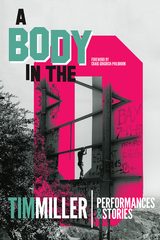 A Body in the O: Performances and Stories
Tim Miller
University of Wisconsin Press, 2019 From London to DC to Australia to Los Angeles, Tim Miller has sold out shows in which he addresses issues of gender, immigration, homophobia, and censorship. As one of the “NEA Four,” who successfully sued the federal government for violating their First Amendment rights when their funding was rescinded in the early 1990s, Miller has always played an important role in defending queer artistic expression on stage. His autobiographical explorations into identity, politics, and art through the lens of his own experiences lead to visceral, humorous, and poignant performances. His activism and experiences inform his newest collection of performance scripts and writings, which represent the culmination of the many struggles for rights and equality that Miller has documented, and performed, over the course of his career. A Body in the O is an important addition to Miller’s existing body of work, picking up from his show Lay of the Land and moving into his more recent piece, Rooted.
 Body Language: Medicine and the Eighteenth-Century Comic Novel
Kathleen Tamayo Alves
Bucknell University Press, 2026 Body Language examines the complex intersections of British eighteenth-century comic fiction and medical discourse. By engaging medical writings of renowned and widely-read physicians of the Enlightenment such as John Freind, Thomas Sydenham, Albrecht von Haller, John Whytt, and William Cullen, with novels of humor by Henry Fielding, Tobias Smollett, Laurence Sterne, and Charlotte Lennox, Alves explains how medicine shaped comic language by dramatizing female-specific phenomena like menstruation, hysteria, nervous disorders, and pregnancy. In these novels, the medical belief that women are incapable of bodily self-regulation becomes an imperative for policing women’s bodies and highlights the enduring shortcomings of patriarchal systems. Ultimately, these comic representations offer a counternarrative of women’s bodies, agency, and selfhood, exposing masculine anxieties about the effectiveness of marriage to regulate women’s sexuality. Published by Bucknell University Press. Distributed worldwide by Rutgers University Press.
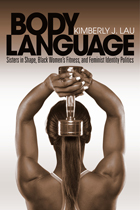 Body Language: Sisters in Shape, Black Women's Fitness, and Feminist Identity Politics
Kimberly J. Lau
Temple University Press, 2011 In her evocative ethnographic study, Body Language, Kimberly Lau traces the multiple ways in which the success of an innovative fitness program illuminates what identity means to its Black female clientele and how their group interaction provides a new perspective on feminist theories of identity politics—especially regarding the significance of identity to political activism and social change. Sisters in Shape, Inc., Fitness Consultants (SIS), a Philadelphia company, promotes balance in physical, mental, and spiritual health. Its program goes beyond workouts, as it educates and motivates women to make health and fitness a priority. Discussing the obstacles at home and the importance of the group's solidarity to their ability to stay focused on their goals, the women speak to the ways in which their commitment to reshaping their bodies is a commitment to an alternative future. Body Language shows how the group's explorations of black women's identity open new possibilities for identity-based claims to recognition, justice, and social change.
Body Love: The Amazing Career of Bernarr Macfadden
William R. Hunt
University of Wisconsin Press, 1989
Bernarr Macfadden (1868–1955) entertained and instructed Americans for decades. He championed physical exercise, fasting, and diet reform and was the relentless scourge of established doctors. He presented his views in Physical Culture, a popular magazine featuring photographs of strong men and healthy women and articles promoting the healthy life. While some critics derided him as a health nut, no one could dispute his genius as a magazine publisher. He established the world’s greatest magazine publishing empire through the innovation of such popular publications as True Story, the first confession magazine; True Detective; and many others.
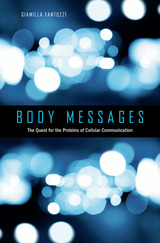 Body Messages: The Quest for the Proteins of Cellular Communication
Giamila Fantuzzi
Harvard University Press, 2016 Whether classified as regulators of inflammation, metabolism, or other physiological functions, a distinctive set of molecules enables the human body to convey information from one cell to another. An in-depth primer on the molecular mediators that coordinate complex bodily processes, Body Messages provides fresh insight into how biologists first identified this special class of molecules and the consequences of their discovery for modern medicine.
Focusing on proteins that regulate inflammation and metabolism—including the cytokines and adipokines at the core of her own research—Giamila Fantuzzi examines the role body messages play in the physiology of health as well as in the pathology of various illnesses. Readers are introduced to different ways of conceptualizing biomedical research and to the advantages and pitfalls associated with identifying molecules beginning with function or structure. By bringing together areas of research usually studied separately, Fantuzzi stresses the importance of investigating the body as a whole and affirms the futility of trying to separate basic from clinical research. Drawing on firsthand interviews with researchers who made major contributions to the field, Body Messages illustrates that the paths leading to scientific discovery are rarely direct, nor are they always the only routes available.
 The Body Multiple: Ontology in Medical Practice
Annemarie Mol
Duke University Press, 2002 The Body Multiple is an extraordinary ethnography of an ordinary disease. Drawing on fieldwork in a Dutch university hospital, Annemarie Mol looks at the day-to-day diagnosis and treatment of atherosclerosis. A patient information leaflet might describe atherosclerosis as the gradual obstruction of the arteries, but in hospital practice this one medical condition appears to be many other things. From one moment, place, apparatus, specialty, or treatment, to the next, a slightly different “atherosclerosis” is being discussed, measured, observed, or stripped away. This multiplicity does not imply fragmentation; instead, the disease is made to cohere through a range of tactics including transporting forms and files, making images, holding case conferences, and conducting doctor-patient conversations. The Body Multiple juxtaposes two distinct texts. Alongside Mol’s analysis of her ethnographic material—interviews with doctors and patients and observations of medical examinations, consultations, and operations—runs a parallel text in which she reflects on the relevant literature. Mol draws on medical anthropology, sociology, feminist theory, philosophy, and science and technology studies to reframe such issues as the disease-illness distinction, subject-object relations, boundaries, difference, situatedness, and ontology. In dialogue with one another, Mol’s two texts meditate on the multiplicity of reality-in-practice. Presenting philosophical reflections on the body and medical practice through vivid storytelling, The Body Multiple will be important to those in medical anthropology, philosophy, and the social study of science, technology, and medicine.
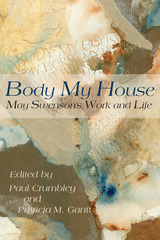 Body My House: May Swenson's Work and Life
edited by Paul Crumbley and Patricia M. Gantt
Utah State University Press, 2000 The first collection of critical essays on May Swenson and her literary universe, Body My House initiates an academic conversation about an unquestionably major poet of the middle and late twentienth century. Includes many previously unpublished Swenson poems. Essays here address the breadth of Swenson's literary corpus and offer varied scholarly approaches to it. They reference Swenson manuscripts---poems, letters, diaries, and other prose---some of which have not been widely available before. Chapters focus on Swenson's work as a nature writer; the literary and social contexts of her writing; her national and international acclaim; her work as a translator; associations with other poets and writers (Bishop, Moore, and others); her creative process; and her profound explorations of gender and sexuality. The first full volume of scholarship on May Swenson, Body My House suggests an ambitious agenda for further work.
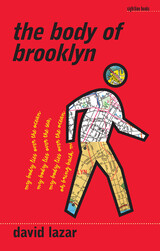 The Body of Brooklyn
David Lazar
University of Iowa Press, 2003 Even before the controversy that surrounded the publication of A Million Little Pieces, the question of truth has been at the heart of memoir. From Elie Wiesel to Benjamin Wilkomirski to David Sedaris, the veracity of writers' claims has been suspect. In this fascinating and timely collection of essays, leading writers meditate on the subject of truth in literary nonfiction. As David Lazar writes in his introduction, "How do we verify? Do we care to? (Do we dare to eat the apple of knowledge and say it's true? Or is it a peach?) Do we choose to? Is it a subcategory of faith? How do you respond when someone says, 'This is really true'? Why do they choose to say it then?" The past and the truth are slippery things, and the art of non-fiction writing requires the writer to shape as well as explore. In personal essays, meditations on the nature of memory, considerations of the genres of memoir, prose poetry, essay, fiction, and film, the contributors to this provocative collection attempt to find answers to the question of what truth in nonfiction means. Contributors: John D'Agata, Mark Doty, Su Friedrich, Joanna Frueh, Ray González, Vivian Gornick, Barbara Hammer, Kathryn Harrison, Marianne Hirsch, Wayne Koestenbaum, Leonard Kriegel, David Lazar, Alphonso Lingis, Paul Lisicky, Nancy Mairs, Nancy K. Miller, Judith Ortiz Cofer, Phyllis Rose, Oliver Sacks, David Shields, and Leo Spitzer.
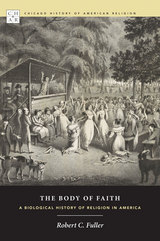 The Body of Faith: A Biological History of Religion in America
Robert C. Fuller
University of Chicago Press, 2013 A groundbreaking account of American religious history that highlights the important role played by the physical body
The postmodern view that human experience is constructed by language and culture has informed historical narratives for decades. Yet newly emerging information about the biological body now makes it possible to supplement traditional scholarly models with insights about the bodily sources of human thought and experience.
The Body of Faith is the first account of American religious history to highlight the biological body. Robert C. Fuller brings a crucial new perspective to the study of American religion, showing that knowledge about the biological body deeply enriches how we explain dramatic episodes in American religious life. Fuller shows that the body’s genetically evolved systems—pain responses, sexual passion, and emotions like shame and fear—have persistently shaped the ways that Americans forge relationships with nature, to society, and to God.
The first new work to appear in the Chicago History of American Religion series in decades, The Body of Faith offers a truly interdisciplinary framework for explaining the richness, diversity, and endless creativity of American religious life.
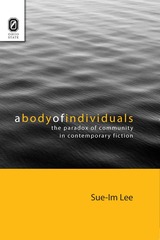 A Body of Individuals: The Paradox of Community in Contemporary Fiction
Sue-Im Lee
Ohio State University Press, 2009 Why are some versions of the collective “we” admired and desired while other versions are scorned and feared? A Body of Individuals: The Paradox of Community in Contemporary Fiction examines the conflict over the collective “we” through discourses of community. In the discourse of benevolent community, community is a tool towards achieving healing, productiveness, and connection. In the discourse of dissenting community, community that serves a function is simply another name for totalitarianism; instead, community must merely be a fact of coexistence. What are the sources and the appeal of these irreconcilable views of community, and how do they interact in contemporary fiction’s attempt at imagining “we”? By engaging contemporary U.S. writers such as Toni Morrison, Richard Powers, Karen Tei Yamashita, Lydia Davis, Lynne Tillman, and David Markson with theorists such as Jean-Luc Nancy, Giorgio Agamben, François Lyotard, Ernesto Laclau, Louis Althusser, Roland Barthes, and Ludwig Wittgenstein, this book reveals how the two conflicting discourses of community—benevolent and dissenting—are inextricably intertwined in various literary visions of “we”—“we” of the family, of the world, of the human, and of coexistence. These literary visions demonstrate, in a way that popular visions of community and postmodern theories of community cannot, the dialectical relationship between the discourses of benevolent community and dissenting community. Sue-Im Lee argues that contemporary fiction’s inability to resolve the paradox results in a model of ambivalent community, one that offers unique insights into community and into the very notion of unity.
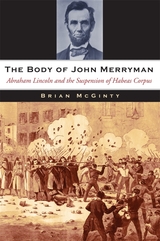 The Body of John Merryman: Abraham Lincoln and the Suspension of Habeas Corpus
Brian McGinty
Harvard University Press, 2011 In April 1861, President Abraham Lincoln suspended the writ of habeas corpus along the military line between Washington, D.C., and Philadelphia. This allowed army officers to arrest and indefinitely detain persons who were interfering with military operations in the area. When John Merryman, a wealthy Marylander suspected of burning bridges to prevent the passage of U.S. troops to Washington, was detained in Fort McHenry, the chief justice of the Supreme Court, Roger Taney, declared the suspension of habeas corpus unconstitutional and demanded Merryman's immediate release. Lincoln defied Taney’s order, offering his own forceful counter-argument for the constitutionality of his actions. Thus the stage was set for one of the most dramatic personal and legal confrontations the country has ever witnessed.
The Body of John Merryman is the first book-length examination of this much-misunderstood chapter in American history. Brian McGinty captures the tension and uncertainty that surrounded the early months of the Civil War, explaining how Lincoln's suspension of habeas corpus was first and foremost a military action that only subsequently became a crucial constitutional battle. McGinty's narrative brings to life the personalities that drove this uneasy standoff and expands our understanding of the war as a legal—and not just a military, political, and social—conflict. The Body of John Merryman is an extraordinarily readable book that illuminates the contours of one of the most significant cases in American legal history—a case that continues to resonate in our own time.
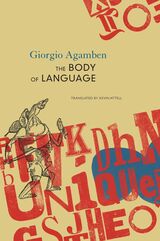 The Body of Language: esperruquancluzelubelouzerirelu
Giorgio Agamben
Seagull Books, 2025 An erudite exploration of transgressive language from the Renaissance by one of Europe’s greatest living philosophers. This book explores how early modern authors broke linguistic boundaries, creating new words and languages that challenged traditional grammar and lexicon, providing historical insight into today’s debates on the politics of language. Through a scholarly analysis by Giorgio Agamben, the text delves into the boundary-shifting language of the Renaissance, exemplified by giants like Pantagruel and Gargantua, whose outsized bodies mirror the vastness of their speech. The macaronic language invented by Teofilo Folengo, blending Latin and vernacular, embodies a linguistic rebellion that transforms language into a tangible, unruly force. Featuring illustrations from the Songes drolatiques de Pantagruel and Folengo’s Baldo, this volume offers a vivid portrayal of language as a physical, dynamic entity that defies grammatical norms.
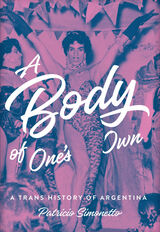 A Body of One's Own: A Trans History of Argentina
Patricio Simonetto
University of Texas Press, 2024 2025 Best Book in Social Sciences Award, Southern Cone Section, Latin American Studies Association
2024 Sylvia Rivera Award in Transgender Studies, The Center for LGBTQ Studies at the Graduate Center, CUNY A history of Argentina that examines how trans bodies were understood, policed, and shaped in a country that banned medically assisted gender affirmation practices and punished trans lives. As a trans history of Argentina, a country that banned medically assisted gender affirmation practices and punished trans lives, A Body of One’s Own places the histories of trans bodies at the core of modern Argentinian history. Patricio Simonetto documents the lives of people who crossed the boundaries of gender from the early twentieth century to the present. Based on extensive archival research in public and community-based archives, this book explores the mainstream medical and media portrayals of trans or travesti people, the state policing of gender embodiment, the experiences of those transgressing the boundaries of gender, and the development of homemade technologies from prosthetics to the self-injection of silicone. A Body of One's Own explores how trans activists' challenges to the exclusionary effects of Argentina’s legal, cultural, social, and political cisgender order led to the passage of the Gender Identity Law in 2012. Analyzing the decisive yet overlooked impact of gender transformation in the formation of the nation-state, gender-belonging, and citizenship, this book ultimately shows that supposedly abstract struggles to define the shifting notions of "sex," citizenship, and nationhood are embodied material experiences.
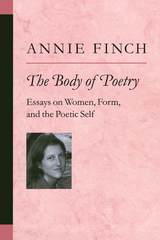 The Body of Poetry: Essays on Women, Form, and the Poetic Self
Annie Finch
University of Michigan Press, 2005 The Body of Poetry collects essays, reviews, and memoir by Annie Finch, one of the brightest poet-critics of her generation. Finch's germinal work on the art of verse has earned her the admiration of a wide range of poets, from new formalists to hip-hop writers. And her ongoing commitment to women's poetry has brought Finch a substantial following as a "postmodern poetess" whose critical writing embraces the past while establishing bold new traditions. The Body of Poetry includes essays on metrical diversity, poetry and music, the place of women poets in the canon, and on poets Emily Dickinson, Phillis Wheatley, Sara Teasdale, Audre Lorde, Marilyn Hacker, and John Peck, among other topics. In Annie Finch's own words, these essays were all written with one aim: "to build a safe space for my own poetry. . . . [I]n the attempt, they will also have helped to nourish a new kind of American poetics, one that will prove increasingly open to poetry's heart."
Poet, translator, and critic Annie Finch is director of the Stonecoast low-residency MFA program at the University of Southern Maine. She is co-editor, with Kathrine Varnes, of An Exaltation of Forms: Contemporary Poets Celebrate the Diversity of Their Art, and author of The Ghost of Meter: Culture and Prosody in American Free Verse, Eve, and Calendars. She is the winner of the eleventh annual Robert Fitzgerald Prosody Award for scholars who have made a lasting contribution to the art and science of versification.
Body of Power, Spirit of Resistance: The Culture and History of a South African People
Jean Comaroff
University of Chicago Press, 1985 In this sophisticated study of power and resistance, Jean Comaroff analyzes the changing predicament of the Barolong boo Ratshidi, a people on the margins of the South African state. Like others on the fringes of the modern world system, the Tshidi struggle to construct a viable order of signs and practices through which they act upon the forces that engulf them. Their dissenting Churches of Zion have provided an effective medium for reconstructing a sense of history and identity, one that protests the terms of colonial and post-colonial society and culture.
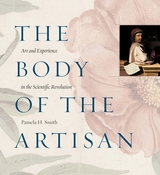 The Body of the Artisan: Art and Experience in the Scientific Revolution
Pamela H. Smith
University of Chicago Press, 2004 Since the time of Aristotle, the making of knowledge and the making of objects have generally been considered separate enterprises. Yet during the late sixteenth and early seventeenth centuries, the two became linked through a "new" philosophy known as science. In The Body of the Artisan, Pamela H. Smith demonstrates how much early modern science owed to an unlikely source-artists and artisans.
From goldsmiths to locksmiths and from carpenters to painters, artists and artisans were much sought after by the new scientists for their intimate, hands-on knowledge of natural materials and the ability to manipulate them. Drawing on a fascinating array of new evidence from northern Europe including artisans' objects and their writings, Smith shows how artisans saw all knowledge as rooted in matter and nature. With nearly two hundred images, The Body of the Artisan provides astonishingly vivid examples of this Renaissance synergy among art, craft, and science, and recovers a forgotten episode of the Scientific Revolution-an episode that forever altered the way we see the natural world.
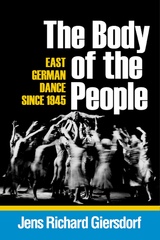 The Body of the People: East German Dance since 1945
Jens Richard Giersdorf
University of Wisconsin Press, 2013 The Body of the People is the first comprehensive study of dance and choreography in East Germany. More than twenty years after the fall of the Berlin Wall, Jens Richard Giersdorf investigates a national dance history in the German Democratic Republic, from its founding as a Communist state that supplanted the Soviet zone of occupation in 1949 through the aftermath of its collapse forty years later, examining complex themes of nationhood, ideology, resistance, and diaspora through an innovative mix of archival research, critical theory, personal narrative, and performance analysis.
Giersdorf looks closely at uniquely East German dance forms—including mass exercise events, national folk dances, Marxist-Leninist visions staged by the dance ensemble of the armed forces, the vast amateur dance culture, East Germany’s version of Tanztheater, and socialist alternatives to rock ‘n’ roll—to demonstrate how dance was used both as a form of corporeal utopia and of embodied socialist propaganda and indoctrination. The Body of the People also explores the artists working in the shadow of official culture who used dance and movement to critique and resist state power, notably Charlotte von Mahlsdorf, Arila Siegert, and Fine Kwiatkowski. Giersdorf considers a myriad of embodied responses to the Communist state even after reunification, analyzing the embodiment of the fall of the Berlin Wall in the works of Jo Fabian and Sasha Waltz, and the diasporic traces of East German culture abroad, exemplified by the Chilean choreographer Patricio Bunster.
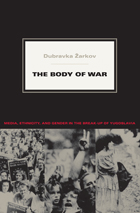 The Body of War: Media, Ethnicity, and Gender in the Break-up of Yugoslavia
Dubravka Zarkov
Duke University Press, 2007 In The Body of War, Dubravka Žarkov analyzes representations of female and male bodies in the Croatian and Serbian press in the late 1980s and in the early 1990s, during the war in which Yugoslavia disintegrated. Žarkov proposes that the Balkan war was not a war between ethnic groups; rather, ethnicity was produced by the war itself. Žarkov explores the process through which ethnicity was generated, showing how lived and symbolic female and male bodies became central to it. She does not posit a direct causal relationship between hate speech published in the press during the mid-1980s and the acts of violence in the war. Instead, she argues that both the representational practices of the “media war” and the violent practices of the “ethnic war” depended on specific, shared notions of femininity and masculinity, norms of (hetero)sexuality, and definitions of ethnicity. Tracing the links between the war and press representations of ethnicity, gender, and sexuality, Žarkov examines the media’s coverage of two major protests by women who explicitly identified themselves as mothers, of sexual violence against women and men during the war, and of women as militants. She draws on contemporary feminist analyses of violence to scrutinize international and local feminist writings on the war in former Yugoslavia. Demonstrating that some of the same essentialist ideas of gender and sexuality used to produce and reinforce the significance of ethnic differences during the war often have been invoked by feminists, she points out the political and theoretical drawbacks to grounding feminist strategies against violence in ideas of female victimhood.
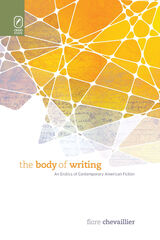 The Body of Writing: An Erotics of Contemporary American Fiction
Flore Chevaillier
Ohio State University Press, 2013 The Body of Writing: An Erotics of Contemporary American Fiction examines four postmodern texts whose authors play with the material conventions of “the book”: Joseph McElroy’s Plus (1977), Carole Maso’s AVA (1993), Theresa Hak Kyung Cha’s DICTEE (1982), and Steve Tomasula’s VAS (2003). By demonstrating how each of these works calls for an affirmative engagement with literature, Flore Chevaillier explores a centrally important issue in the criticism of contemporary fiction. Critics have claimed that experimental literature, in its disruption of conventional story-telling and language uses, resists literary and social customs. While this account is accurate, it stresses what experimental texts respond to more than what they offer. This book proposes a counter-view to this emphasis on the strictly privative character of innovative fictions by examining experimental works’ positive ideas and affects, as well as readers’ engagement in the formal pleasure of experimentations with image, print, sound, page, orthography, and syntax. Elaborating an erotics of recent innovative literature implies that we engage in the formal pleasure of its experimentations with signifying techniques and with the materiality of their medium. Such engagement provokes a fusion of the reader’s senses and the textual material, which invites a redefinition of corporeality as a kind of textual practice.
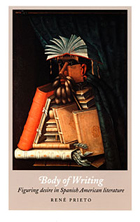 Body of Writing: Figuring Desire in Spanish American Literature
René Prieto
Duke University Press, 2000 Body of Writing focuses on the traces that an author’s “body” leaves on a work of fiction. Drawing on the work of six important Spanish American writers of the twentieth century, René Prieto examines narratives that reflect—in differing yet ultimately complementary ways—the imprint of the author’s body, thereby disclosing insights about power, aggression, transgression, and eroticism. Healthy, invalid, lustful, and confined bodies—as portrayed by Julio Cortázar, Guillermo Cabrera Infante, Gabriel García Márquez, Severo Sarduy, Rosario Castellanos, and Tununa Mercado—become evidence for Roland Barthes’s contention that works of fiction are “anagrams of the body.” Claiming that an author’s intentions can be uncovered by analyzing “the topography of a text,” Prieto pays particular attention not to the actions or plots of these writers’ fiction but rather to their settings and characterizations. In the belief that bodily traces left on the page reveal the motivating force behind a writer’s creative act, he explores such fictional themes as camouflage, deterioration, defilement, entrapment, and subordination. Along the way, Prieto reaches unexpected conclusions regarding topics that include the relationship of the female body to power, male and female transgressive impulses, and the connection between aggression, the idealization of women, and anal eroticism in men. This study of how authors’ longings and fears become embodied in literature will interest students and scholars of literary and psychoanalytic criticism, gender studies, and twentieth-century and Latin American literature.
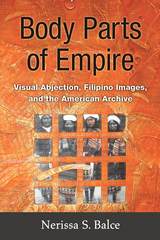 Body Parts of Empire: Visual Abjection, Filipino Images, and the American Archive
Nerissa S. Balce
University of Michigan Press, 2016 Body Parts of Empire is a study of abjection in American visual culture and popular literature from the Philippine-American War (1899–1902). During this period, the American national territory expanded beyond its continental borders to islands in the Pacific and the Caribbean. Simultaneously, new technologies of vision emerged for imagining the human body, including the moving camera, stereoscopes, and more efficient print technologies for mass media.
Rather than focusing on canonical American authors who wrote at the time of U.S. imperialism, this book examines abject texts—images of naked savages, corpses, clothed native elites, and uniformed American soldiers—as well as bodies of writing that document the goodwill and violence of American expansion in the Philippine colony. Contributing to the fields of American studies, Asian American studies, and gender studies, the book analyzes the actual archive of the Philippine-American War and how the racialization and sexualization of the Filipino colonial native have always been part of the cultures of America and U.S. imperialism. By focusing on the Filipino native as an abject body of the American imperial imaginary, this study offers a historical materialist optic for reading the cultures of Filipino America.
 Body Parts: Property Rights and the Ownership of Human Biological Materials
E. Richard Gold
Georgetown University Press In Body Parts, E. Richard Gold examines whether the body and materials derived from it—such as human organs and DNA—should be thought of as market commodities and subject to property law. Analyzing a series of court decisions concerning property rights, Gold explores whether the language and assumptions of property law can help society determine who has rights to human biological materials. Gold observes that the commercial opportunities unleashed by advances in biotechnology present a challenge to the ways that society has traditionally valued the human body and human health. In a balanced discussion of both commercial and individual perspectives, Gold asserts the need to understand human biological materials within the context of human values, rather than economic interests. This perceptive book will be welcomed by scholars and other professionals engaged in questions regarding bioethics, applied ethics, the philosophy of value, and property and intellectual property rights. Given the international aspects of both intellectual property law and biotechnology, this book will be of interest throughout the world and especially valuable in common-law (most English-speaking) countries.
 Body Problems: What Intersex Priest Sally Gross Teaches Us About Embodiment, Justice, and Belonging
M. Wolff
Duke University Press, 2025 In Body Problems, M. Wolff offers groundbreaking insight into Sally Gross, a South African intersex priest and activist whose body was continuously policed and politicized. Gross’s role in founding Intersex South Africa and her involvement with the African National Congress are celebrated in the Apartheid Museum, but the complex dimensions of her life—from her Jewish heritage to her Christian priesthood and Buddhist practices—remain largely unexplored. Wolff illuminates these lesser-known aspects of Gross’s spirituality and theorizes her resistance to the regulation of intersexuality. The book urges readers to rethink bodies and belonging, particularly as they relate to formations of gender and religion. Wolff presents Gross’s life as a guide for discerning our commitments to social justice and responsible relations. Body Problems is a timely and expansive contribution to ongoing discourses on the medical, religious, and political construction of bodies.
Body, Remember: A Memoir
Kenny Fries
University of Wisconsin Press, 2003 In this poetic, introspective memoir, Kenny Fries illustrates his intersecting identities as gay, Jewish, and disabled. While learning about the history of his body through medical records and his physical scars, Fries discovers just how deeply the memories and psychic scars run. As he reflects on his relationships with his family, his compassionate doctor, the brother who resented his disability, and the men who taught him to love, he confronts the challenges of his life. Body, Remember is a story about connection, a redemptive and passionate testimony to one man’s search for the sources of identity and difference.
 Body, Society, and Nation: The Creation of Public Health and Urban Culture in Shanghai
Chieko Nakajima
Harvard University Press, 2018 Body, Society, and Nation tells the story of China’s unfolding modernity by exploring the changing ideas, practices, and systems related to health and body in late nineteenth- and twentieth-century Shanghai. The pursuit of good health loomed large in Chinese political, social, and economic life. Yet, “good health” had a range of associations beyond individual well-being. It was also an integral part of Chinese nation-building, a goal of charitable activities, a notable outcome of Western medical science, a marker of modern civilization, and a commercial catchphrase. With the advent of Western powers, Chinese notions about personal hygiene and the body gradually expanded. This transformation was complicated by indigenous medical ideas, preexisting institutions and social groups, and local cultures and customs.
This study explores the many ways that members of the various strata of Shanghai society experienced and understood multiple meanings of health and body within their everyday lives. Chieko Nakajima traces the institutions they established, the regulations they implemented, and the practices they brought to the city as part of efforts to promote health. In doing so, she explains how local practices and customs fashioned and constrained public health and, in turn, how hygienic modernity helped shape and develop local cultures and influenced people’s behavior.
 The Body Soviet: Propaganda, Hygiene, and the Revolutionary State
Tricia Starks
University of Wisconsin Press, 2008 In 1918 the People's Commissariat of Public Health began a quest to protect the health of all Soviet citizens, but health became more than a political platform or a tactical decision. The Soviets defined and categorized the world by interpreting political orthodoxy and citizenship in terms of hygiene. The assumed political, social, and cultural benefits of a regulated, healthy lifestyle informed the construction of Soviet institutions and identity. Cleanliness developed into a political statement that extended from domestic maintenance to leisure choices and revealed gender, ethnic, and class prejudices. Dirt denoted the past and poor politics; health and cleanliness signified mental acuity, political orthodoxy, and modernity.
Health, though essential to the revolutionary vision and crucial to Soviet plans for utopia, has been neglected by traditional histories caught up in Cold War debates. The Body Soviet recovers this significant aspect of Soviet thought by providing a cross-disciplinary, comparative history of Soviet health programs that draws upon rich sources of health care propaganda, including posters, plays, museum displays, films, and mock trials. The analysis of propaganda makes The Body Soviet more than an institutional history; it is also an insightful critique of the ideologies of the body fabricated by health organizations.
"A masterpiece that will thoroughly fascinate and delight readers. Starks's understanding of propaganda and hygiene in the early Soviet state is second to none. She tells the stories of Soviet efforts in this field with tremendous insight and ingenuity, providing a rich picture of Soviet life as it was actually lived."— Elizabeth Wood, author of From Baba to Comrade: Gender and Politics in Revolutionary Russia
 Body Story
Julia K. De Pree
Ohio University Press, 2004 Something other than a memoir of a life well lived, Body Story conveys Julia K. De Pree's troubling journey from adolescence to adulthood and from anorexia to health.
For De Pree, between being a girl and being a woman, there was starvation. Body Story is her intimate account of girlhood, virginity, anorexia, and motherhood. De Pree's prose is spare and unguarded, revealing in vivid flashbacks and poignant vignettes the sources of her inner pain.
In high school, the five-foot-ten De Pree weighed as little as 114 pounds. She was too weak to raise her arms above her head. “In a paradoxical way, I starved my body in order to understand my life,” she writes. “I had to place my body in suspension before I could move physically into sexuality. Starving allowed me to create an interim space between innocence and experience.”
De Pree renders the starkness of anorexia along with the process of recovery, relapse, and, ultimately, redemption. She also tells the story of the physical landscape, from her origins in the Midwest to the American South, Paris, and the vast New Mexican desert, as well as the psychic landscape of her body as it encounters the joys and challenges of maturation, childbirth, and motherhood.
De Pree offers readers a new way of understanding women¿s bodily experience, as she writes about the mystery and the meaning of her illness. As many as eight million Americans suffer from eating disorders. Body Story, unlike clinical reports or news accounts, illuminates the complexity of anorexia as the narrative moves toward a subjective and deeply personal truth.
This evocative and often radiant vision is a unique window into womanhood and selfhood in middle-class, contemporary America.
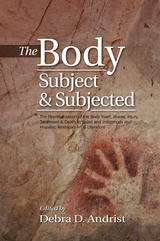 The Body, Subject & Subjected: The Representation of the Body Itself, Illness, Injury, Treatment & Death in Spain and Indigenous and Hispanic American Art & Literature
Edited by Debra D. Andrist
Sussex Academic Press, 2022 Hominids have always been obsessed with representing their own bodies. The first "selfies" were prehistoric negative hand images and human stick figures, followed by stone and ceramic representations of the human figure. Thousands of years later, moving via historic art and literature to contemporary social media, the contemporary term "selfie" was self-generated. The book illuminates some "selfies". This collection of critical essays about the fixation on the human self addresses a multi-faceted geographic set of cultures -- the Iberian Peninsula to pre-Columbian America and Hispanic America -- analysing such representations from medical, literal and metaphorical perspectives over centuries. Chapter contributions address the representation of the body itself as subject, in both visual and textual manners, and illuminate attempts at control of the environment, of perception, of behaviour and of actions, by artists and authors. Other chapters address the body as subjected to circumstance, representing the body as affected by factors such as illness, injury, treatment and death. These myriad effects on the body are interpreted through the brushes of painters and the pens of authors for social and/or personal control purposes. The essays reveal critics' insights when "selfies" are examined through a focused "lens" over a breadth of cultures. The result, complex and unique, is that what is viewed -- the visual art and literature under discussion -- becomes a mirror image, indistinguishable from the component viewing apparatus, the "lens".
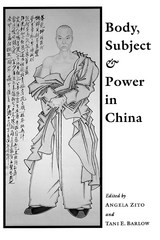 Body, Subject, and Power in China
Edited by Angela Zito and Tani E. Barlow
University of Chicago Press, 1994 For the first time, this volume brings to the study of China the theoretical concerns and methods of contemporary critical cultural studies. Written by historians, art historians, anthropologists, and literary critics who came of age after the People's Republic resumed scholarly ties with the United States, these essays yield valuable new insights not only for China studies but also, by extension, for non-Asian cultural criticism.
Contributors investigate problems of bodiliness, engendered subjectivities, and discourses of power through a variety of sources that include written texts, paintings, buildings, interviews, and observations. Taken together, the essays show that bodies in China have been classified, represented, discussed, ritualized, gendered, and eroticized in ways as rich and multiple as those described in critical histories of the West. Silk robes, rocks, winds, gestures of bowing, yin yang hierarchies, and cross-dressing have helped create experiences of the body specific to Chinese historical life. By pointing to multiple examples of reimagining subjectivity and renegotiating power, the essays encourage scholars to avoid making broad generalizations about China and to rethink traditional notions of power, subject, and bodiliness in light of actual Chinese practices. Body, Subject, and Power in China is at once an example of the changing face of China studies and a work of importance to the entire discipline of cultural studies.
Body Thesaurus
Jennifer Militello
Tupelo Press, 2013 In her second book, Jennifer Militello uses symptoms, diagnostic tests, and antidotes to illuminate tensions of identity that are central to illness and health. An endangered psyche confronts maladies and faces gods in poems that embody the complexities of self. Selected by Marilyn Hacker as a finalist for the Poetry Society of America’s Alice Fay di Castagnola Award, Body Thesaurus examines the failing conduit of human physicality, offering beauty as a counter-stream to struggle.
Body Thoughts
Andrew J. Strathern
University of Michigan Press, 1996 Provides an excellent review of anthropological thought on the body
The Body Wars: Poems
Jan Beatty
University of Pittsburgh Press, 2020 What would it take to be home in one’s body, to walk around the world as oneself, knowing the pain within and without us? Jan Beatty boldly answers that question by making a fire map of the body. These roiling poems smack into walls of meditation, only to slide down the smooth concrete into the flatline of joy. These are vital poems of dimension, of both psychic and literal travel, of the elasticity of truth and struggle, of the daily nature of desire that brings us to our knees—then shotguns us back to the heart’s center.
Yellow Sky
The summer that I had nowhere to live:
the sky was yellow everywhere.
The cars of other people had their own private shine.
I walked slowly.
Several birds re-visited the backyards of strangers,
I was free
singing the song of the last thing I didn’t say to you.
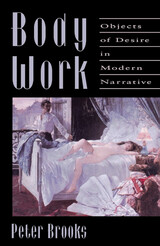 Body Work: Objects of Desire in Modern Narrative
Peter Brooks
Harvard University Press, 1993 The desire to know the body is a powerful dynamic of storytelling in all its forms. Peter Brooks argues that modern narrative is intent on uncovering the body in order to expose a truth that must be written in the flesh. In a book that ranges widely through literature and painting, Brooks shows how the imagination strives to bring the body into language and to write stories on the body.
From Rousseau, Balzac, Mary Shelley, and Flaubert, to George Eliot, Zola, Henry James, and Marguerite Duras, from Manet and Gauguin to Mapplethorpe, writers and artists have returned in fascination to the body, the inescapable other of the spirit. Brooks's deep understanding of psychoanalysis informs his demonstration of how the "epistemophilic urge"--the desire to know-guides fictional plots and our reading of them.
It is the sexual body that furnishes the building blocks of symbolization, eventually of language itself-which then takes us away from the body. Yet mind and language need to recover the body, as an other realm that is primary to their very definition. Brooks shows how and why the female body has become the field upon which the aspirations, anxieties, and contradictions of a whole society are played out. And he suggests how writers and artists have found in the woman's body the dynamic principle of their storytelling, its motor force.
This major book entertains and teaches: Brooks presumes no special knowledge on the part of his readers. His account proceeds chronologically from Rousseau in the eighteenth century forward to contemporary artists and writers. Body Work gives us a set of analytical tools and ideas-primarily from psychoanalysis, narrative and film studies, and feminist theory-that enable us to read modern narrative afresh.
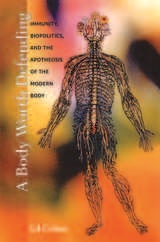 A Body Worth Defending: Immunity, Biopolitics, and the Apotheosis of the Modern Body
Ed Cohen
Duke University Press, 2009 Biological immunity as we know it does not exist until the late nineteenth century. Nor does the premise that organisms defend themselves at the cellular or molecular levels. For nearly two thousand years “immunity,” a legal concept invented in ancient Rome, serves almost exclusively political and juridical ends. “Self-defense” also originates in a juridico-political context; it emerges in the mid-seventeenth century, during the English Civil War, when Thomas Hobbes defines it as the first “natural right.” In the 1880s and 1890s, biomedicine fuses these two political precepts into one, creating a new vital function, “immunity-as-defense.” In A Body Worth Defending, Ed Cohen reveals the unacknowledged political, economic, and philosophical assumptions about the human body that biomedicine incorporates when it recruits immunity to safeguard the vulnerable living organism. Inspired by Michel Foucault’s writings about biopolitics and biopower, Cohen traces the migration of immunity from politics and law into the domains of medicine and science. Offering a genealogy of the concept, he illuminates a complex of thinking about modern bodies that percolates through European political, legal, philosophical, economic, governmental, scientific, and medical discourses from the mid-seventeenth century through the twentieth. He shows that by the late nineteenth century, “the body” literally incarnates modern notions of personhood. In this lively cultural rumination, Cohen argues that by embracing the idea of immunity-as-defense so exclusively, biomedicine naturalizes the individual as the privileged focus for identifying and treating illness, thereby devaluing or obscuring approaches to healing situated within communities or collectives.
Bodylore
Katharine Young
University of Tennessee Press, 1995 With this book, a new field of inquiry is instantiated in folklore, bodylore. Coming out of work in critical theory and cultural studies, semiology and psychology, philosophy and communication, literature and psychoanalysis, anthropology and history, Bodylore investigates the bodily discourses and practices of various cultures, including our own, in order to delineate the metaphysics in terms of which we conceive and experience ourselves and others. The body is disclosed as a cultural artifact rather than a natural object, one invented and reinvented in and by its social appearances. The term bodylore was coined for the 1989 meeting of the American Folklore Society. It brings folkloristic concerns with body language, body costumes and accoutrements, body movement, discourses and representations of the body, body rituals and taboos, and beliefs about the body to a social history of embodiment.
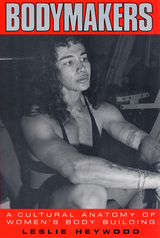 Bodymakers: A Cultural Anatomy of Women's Body Building
Leslie Heywood
Rutgers University Press, 1998 "A highly unique and refreshing contribution. Heywood not only theorizes the relationships among feminism, activism, and bodybuilding but also provides what so many works on built female bodies lack-a feminine historical context. . . . Heywood concludes with a call for women to 'feel our muscles, our power, our terrible, wonderful, monstrous strengths' by leaving behind aerobics, replacing light weights with heavy ones, and claiming our right to take up space. . . . Like all influential and groundbreaking works, this book raises new and important questions that should provide grist for much feminist debate and scholarship in coming years." --Signs
"Bodymakers is most ambitious in terms of its engagement with feminist cultural criticism and its unconventional scope. Heywood comments on film, novels, magazine pictures, popular criticisms of feminism, the J. Crew catalog, [and] the concept of power feminism." --Gender and Society
"In this brilliantly insightful and immensely readable book, Leslie Heywood makes us think about women's body building in an entirely new way. She argues persuasively that, far from being an individualistic, apolitical act, it is a powerful form of resistance, empowering women to overcome their victim status and heal past abuse." --Myra Dinnerstein, University of Arizona
"Bodymakers has a power and an honesty that is unusual in a book with its theoretical sophistication." --Susan Bordo, author of Unbearable Weight and Twilight Zones: The Hidden Life of Cultural Images from Plato to O.J.
"With clarity, force, and passionate investment grounded in both theory and her own experience, Heywood understands that women can strengthen body, mind, and spirit through everyday practice. Her argument that body building is this kind of activist practice is as inspirational as it is poignant." --Joanna Frueh, author of Erotic Faculties
"Flexing her muscles through autobiographical, theoretical, and spectacular acts, Heywood insists that we read the muscular female body not as an 'extreme oddity' but as a 'form of activism' through which we can understand anew larger cultural issues and trends, including the American romance with individualism and the relationship of second and third wave feminisms. Muscular female bodies will never be read in the same way again." --Sidonie Smith, University of Michigan
Women with muscles are a recent phenomenon, so recent that, while generating a good deal of interest, their importance to the cultural landscape has yet to be acknowledged. Leslie Heywood looks at the sport and image of female body building as a metaphor for how women fare in our current political and cultural climate. She argues that the movement in women's body building from small, delicate bodies to large powerful ones and back again is directly connected to progress and backlash within the abortion debate, the ongoing struggle for race and gender equality, and the struggle to define "feminism" in the context of the nineties. She discusses female body building as activism, as an often effective response to abuse, race and masculinity in body building, and the contradictory ways that photographers treat female body builders. Engaging and accessible, Bodymakers reveals how female body builders find themselves both trapped and empowered by their sport.
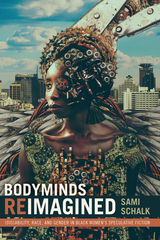 Bodyminds Reimagined: (Dis)ability, Race, and Gender in Black Women's Speculative Fiction
Sami Schalk
Duke University Press, 2018 In Bodyminds Reimagined Sami Schalk traces how black women's speculative fiction complicates the understanding of bodyminds—the intertwinement of the mental and the physical—in the context of race, gender, and (dis)ability. Bridging black feminist theory with disability studies, Schalk demonstrates that this genre's political potential lies in the authors' creation of bodyminds that transcend reality's limitations. She reads (dis)ability in neo-slave narratives by Octavia Butler (Kindred) and Phyllis Alesia Perry (Stigmata) not only as representing the literal injuries suffered under slavery, but also as a metaphor for the legacy of racial violence. The fantasy worlds in works by N. K. Jemisin, Shawntelle Madison, and Nalo Hopkinson—where werewolves have obsessive-compulsive-disorder and blind demons can see magic—destabilize social categories and definitions of the human, calling into question the very nature of identity. In these texts, as well as in Butler’s Parable series, able-mindedness and able-bodiedness are socially constructed and upheld through racial and gendered norms. Outlining (dis)ability's centrality to speculative fiction, Schalk shows how these works open new social possibilities while changing conceptualizations of identity and oppression through nonrealist contexts.
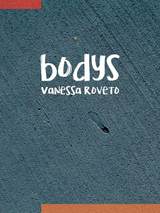 bodys
Vanessa Roveto
University of Iowa Press, 2016 Vanessa Roveto’s debut collection, bodys, is a work of stunning strangeness, force, and audacity, generated by—and degenerating toward—the unanswerable question at the heart of poetic speech: What does it mean to be “a person?” A dizzying hybrid of poetry and prose, post-human analytics and ribaldry, spiritual autobiography, and grim satire, Roveto lends exacting voice to “a most complicated vocabulary of feeling-your-feelings.” Viscerally drawn to forbidden states and suspicious of its own desires, bodys is literature as high-risk, low-tech radiology, mapping the dim edges of identity and identification: “Brain scans indicated the moral center and the disgust center overlap on the mind field.”
Roveto’s sentences hurtle forward with withering disjunctive energy, laying down traps of wordplay, tacking toward and veering away from syntactical targets, trying-on and sloughing-off pronoun positions with abandon. Yet for all its postmodern bravado—and irreverence, and frequent scary hilarity—bodys remains abidingly attached to exploring the problem of a human speaker addressing itself to another, and colliding with its own otherness along the way. It is the same problem—articulation as disarticulation—that animates the great Renaissance sonnet sequences, from which bodys is affectionately, and perversely, descended. What is bodys—what are bodys—anyway? A dysfunction in the body’s ability to multiply itself? A dysmorphic take on the body’s sense of its reality? A dystopian vision of a world in which boundaries between selves and others have been overwhelmed by commerce, surveillance, medical technology, nihilistic agitprop? “Last night one of the girls asked about the relationship between a body and nobody,” Roveto writes. “It was the beautiful question.”
Boeing B-47 Stratojet: the cold war jet bomber
Nico Braas
Amsterdam University Press, 2023 Built by Boeing, designated as B-47 and named the Stratojet, this plane was quantum leap in aircraft development. Initially Boeing entered the unknown when they started this project, but soon it would be evident that Strategic Air Command would have its multi-engine jet bomber with a speed performance similar to the latest jet fighters...
 The Boethian Commentaries of Clarembald of Arras
David B. George
University of Notre Dame Press, 2002 "Well-grounded in the most up-to-date materials relating to Boethius and his medieval commentators, this book is of great assistance for the study of twelfth-century theology." --Stephen F. Brown, Boston College
David George and John Fortin, O.S.B. offer students and scholars the first modern-language translation of commentaries by twelfth-century arts master Clarembald of Arras on two works by the Roman philosopher Boethius (480-524): De Hebdomadibus and De Trinitate. This useful volume also includes extensive notes and a helpful introduction discussing the biography of Clarembald, his writings, and his Latin style.
The Boethian Commentaries of Clarembald of Arras reveal that Clarembald, a student of Thierry of Chartres and Hugh of St. Victor, often departed from the style of the straightforward commentaries of his masters. It also shows that Clarembald used his commentaries to defend the Church from misconceptions and heresies that were considered a threat to orthodoxy during his time. This welcome translation is an invaluable resource for anyone with an interest in medieval philosophy and theology.
DAVID B. GEORGE is professor and chair of classics at Saint Anselm College.
JOHN R. FORTIN, O.S.B., is a Benedictine monk of Saint Anselm Abbey in Manchester, New Hampshire, an associate professor of philosophy at Saint Anselm College, and director of the Institute for Saint Anselm Studies.
Boethius and Aquinas
Ralph McInerny
Catholic University of America Press, 2012 In this study of the relationship between Boethius and Thomas Aquinas, Ralph McInerny dispels the notion that Aquinas misunderstood the early philosopher and argues instead that he learned from Boethius, assimilated his ideas, and proved to be a reliable interpreter of his thought.
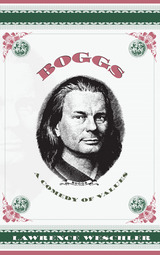 Boggs: A Comedy of Values
Lawrence Weschler
University of Chicago Press, 1999 In this highly entertaining book, Lawrence Weschler chronicles the antics of J. S. G. Boggs, an artist whose consuming passion is money, or perhaps more precisely, value. Boggs draws money-paper notes in standard currencies from all over the world-and tries to spend his drawings. It is a practice that regularly lands him in trouble with treasury police around the globe and provokes fundamental questions regarding the value of art and the value of money.
"Lawrence Weschler, who evidently admires [Boggs]-something not difficult to do-has written what may be the most extraordinary biography imaginable: "weird," to use a favourite Boggs word. It does something towards changing our entire outlook on money and its uses. And the reader is left with an uneasy feeling that anything in this world can be created by drawing it." —Ruth Rendell, Daily Telegraph
"As ideal a subject matter as money is for Boggs' genius, Boggs is as ideal a topic for Weschler's considerable talents. . . . A writer any less lucid than Weschler would smudge the lines, making of Boggs a counterculture caricature or a high-art huckster. And a writer any less confident would knock the balance, making academic mud pies of Boggs' enlightened chaos." —Jonathon Keats, San Francisco Chronicle Book Review
"[A] witty and engaging chronicle. . . . Weschler's fascinating account of the artist as agent provocateur demonstrates both the significance of Boggs's art and his determination to continue his unusual critique of the idea of money." —Henry Wessells, Washington Post Book World
"[A] witty, excellently written account of a bizarre and fascinating snippet of modern life." —Paul Ormerod, Times Higher Education Supplement
"The book, like the artist, challenges people to pause and consider the extent to which the economic bedrock of everyday life is in part a confusing welter of artistic abstractions. It's a work that is at once informative, entertaining, and provocative-a reading experience, one might say, of rather good value." —Toby Lester, Atlantic Monthly
"[A] fascinating tale, especially in these days of fluctuating currency rates, the euro, and inexplicable Net-stock valuations." —Paul Lukas, Fortune
Lawrence Weschler, a recipient of the prestigious Lannan Literary Award for 1998, is the author of numerous books, including Calamities of Exile: Three Nonfiction Novellas, and Mr. Wilson's Cabinet of Wonder, which was a finalist for both the Pulitzer Prize and the National Book Critics Circle Award.
Bogotá: A Novel
Alan Grostephan
Northwestern University Press, 2013 In Bogotá, a taut, moving novel set in present-day Colombia, Wilfredo decides to uproot his family from their small town, where his ferry service on the river subjects him to the gruesome errands demanded by the local paramilitary. Moving in with relatives in a slum in Bogotá, the family tries desperately to achieve the smallest measure of comfort and hope in a world of almost total ruin, wracked by deprivation, fear, and ceaseless violence.
Alan Grostephan depicts with startling immediacy an urban landscape of extreme harshness and oppressive instability. The tension between the desperate conditions surrounding his characters and their efforts to hold on to their humanity gives Bogotá a ferocious energy. As Wilfredo and his family fight to stay alive and stay together, their plight emerges as equally enraging and uplifting, constituting a portrait of a society always on the verge of disintegration.
Bogs of the Northeast
Charles W. Johnson
University Press of New England, 1985 What makes bogs so interesting yet so misunderstood? This generously illustrated book presents many of the exciting, almost enthralling, facets of bogs--unusual plants, intricate ecological relationships, animals, myths and folklore, and the myriad history recorded in the peats. Despite the fascinating bogs hold, until now there has been no popular book that deals with them in a comprehensive yet authoritative manner. The Northeastern United States has a wonderful diversity of bogs: some are southern in nature, others are very arctic, and still others maritime. And although this is a book primarily about peatlands in New York, New Jersey, Pennsylvania, and the six New England states, it will interest a much wider audience seeking an exciting and attractive approach to these often-neglected areas of our natural heritage.
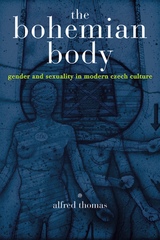 The Bohemian Body: Gender and Sexuality in Modern Czech Culture
Alfred Thomas
University of Wisconsin Press, 2007 The Bohemian Body examines the modernist forces within nineteenth- and twentieth-century Europe that helped shape both Czech nationalism and artistic interaction among ethnic and social groups—Czechs and Germans, men and women, gays and straights.
By re-examining the work of key Czech male and female writers and poets from the National Revival to the Velvet Revolution, Alfred Thomas exposes the tendency of Czech literary criticism to separate the political and the personal in modern Czech culture. He points instead to the complex interplay of the political and the personal across ethnic, cultural, and intellectual lines and within the works of such individual writers as Karel Hynek Mácha, Bozena Nemcová, and Rainer Maria Rilke, resulting in the emergence and evolution of a protean modern identity. The product is a seemingly paradoxical yet nuanced understanding of Czech culture (including literature, opera, and film), long overlooked or misunderstood by Western scholars.
A Bohemian Youth
Josef Hirsal
Northwestern University Press, 1997 Winner, 1998 PEN Center USA West Award for Translation
Josef Hiršal's experimental novel is a Dada-like romp through the life of a young man born into a Bohemian peasant family. Told in five parts, A Bohemian Youth begins with a word to the wise, moves on to the text, continues with notes and with notes to the note, and ends with a note on the notes to the notes.
More than just a tongue-in-cheek parody of a literary memoir, A Bohemian Youth is a glimpse of the First Czechoslovak Republic as seen through the eyes of a young peasant from the provinces. Abounding in intimate details--the manners of a servant girl, the habits of the town homosexual, the sounds of popular music; the way people eat in wartime—Hiršal's novel is a wrenching and hilarious tale of a young man's emotional and sexual awakening.
 Bohemians: The Glamorous Outcasts
Elizabeth Wilson
Rutgers University Press, 2000 Since the early nineteenth century, the bohemian has been the protagonist of the story the West has wanted to hear about its artists-a story of genius, glamour, and doom. The bohemian takes on many guises: the artist dying in poverty like Modigliani or an outrageous entertainer like Josephine Baker. Elizabeth Wilson's enjoyable book is a quest for the many shifting meanings that constitute the bohemian and bohemia. She tells unforgettable stories of the artists, intellectuals, radicals, and hangers-on who populated the salons, bars, and cafs of Paris, London, New York, Los Angeles, and San Francisco, including Djuna Barnes, Juliette Greco, Allen Ginsberg, William Burroughs, Jack Kerouac, Amiri Baraka, Andy Warhol, and Jackson Pollock. Bohemians also follows the women who contributed to the myth, including the wives and mistresses, the muses, lesbians, and independent artists. Wilson explores the bohemians' eccentric use of dress, the role of sex and erotic love, the bohemian search for excess, and the intransigent politics of many. As a new millennium begins, Wilson shows how notions of bohemianism remain at the core of heated cultural debates about the role of art and artists in an increasingly commodified and technological world.
Bohemia's Jews and Their Nineteenth Century: Texts, Contexts, Reassessments
Jindrich Toman
Karolinum Press, 2023 Bohemian Jewish culture and literature during the underexamined 1820s to 1880s.
This book on Jewish culture and literature focuses on the “quiet” decades of the nineteenth century, a scarcely written-about period of time in Bohemian Jewish history. Using a myriad of sources, including travelers’ accounts, poems, essays, short stories, guides, and newspaper articles, the volume explores Jewish expression, Jewish-Czech relations, and the changing attitudes toward Jews between the 1820s and 1880s. It offers close readings of writers like Karel Havlíćek Borovský, Ján Kollár, Siegfried Kapper, and Jan Neruda, as well as lesser-known authors and sources. Combining skillful sustained analysis, judicious argumentation, and elegant writing, the book is a truly enriching reading experience.
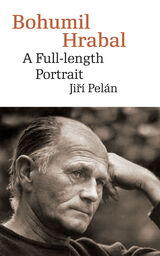 Bohumil Hrabal: A Full-Length Portrait
Jirí Pelán
Karolinum Press, 2019 Described by Parul Sehgal in the New York Times Book Review as “one of the great prose stylists of the twentieth century; the scourge of state censors; the gregarious bar hound and lover of gossip, beer, cats, and women (in roughly that order),” Bohumil Hrabal is one of the most important, most translated, and most idiosyncratic Czech authors. In Bohumil Hrabal: A Full-Length Portrait, Jiří Pelán makes the case that this praise is far too narrow. A respected scholar of French and Italian literature, Pelán approaches Hrabal as a comparatist, expertly situating him within the context of European and world literature as he explores the entirety of Hrabal’s oeuvre and its development over sixty years. Concise, clear, and as compulsively readable as the works of Hrabal himself, Bohumil Hrabal was universally praised by critics in its original Czech edition as one of best works of Hrabal criticism. Here it is beautifully rendered into English for the first time by David Short, a celebrated translator of Hrabal’s works. Also featuring a fascinating selection of black-and-white images from Hrabal’s life, Bohumil Hrabal is essential reading for anyone interested in this crucial Czech author.
 The Boiler Room and Other Telephone Sales Scams
Robert J. Stevenson
University of Illinois Press, 1998 Sure to make you think twice before responding to the next telephone sales call you receive, this volume explores why telephone boiler rooms and other scams thrive and how fraudulent techniques and deception migrate to and from conventional businesses.
The Boiler Room and Other Telephone Sales Scams is grounded in the nine years Robert Stevenson spent working covertly as a "participant-observer" in telephone rooms (the ethical implications of which he discusses in an epilogue). As Stevenson details boiler room hierarchy, you'll learn why all boilers are telephone salesmen but not all telephone salesmen are boilers. You'll read about the "heat" rising in rooms where experienced pitchmen use tried-and-true manipulative techniques to overcome objections to sales. And you'll marvel at Stevenson's insider knowledge of product houses, service shops, and other aspects of a major industry in which both employees and customers are in daily peril—the former of losing their jobs and the latter of losing their money.
The Boiler Room and Other Telephone Sales Scams is required reading for anyone who's ever picked up a telephone and been asked to buy a product or a service. It's also an invaluable study of a widespread form of deviance and occupational crime, essential reading for students of criminology and the sociology of occupations.
Boiling Energy: Community Healing among the Kalahari Kung
Richard Katz
Harvard University Press, 1982 This account of the ancient healing dances practiced by the Kung people of southern Africa’s Kalahari Desert includes vivid eyewitness descriptions of night-long healing dances and interviews with Kung healers.
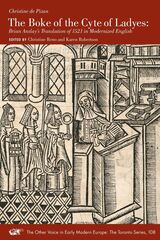 The Boke of the Cyte of Ladyes: Brian Anslay's Translation of 1521 in Modernized English
Christine de Pizan
Iter Press, 2025 An early Tudor translation of the Cité des dames, a crucial argument written by Christine de Pizan on the importance of women.
Christine de Pizan's defense of women against centuries of misogyny, Cité des dames, was the only work of literature translated into English by Brian Anslay, an administrator in the household of King Henry VII. While numerous manuscripts were held in royal and aristocratic libraries, Anslay’s printed translation enabled a broader range of readers to appreciate the arguments for female rule crucial to the reigns of Mary I and Elizabeth I. Anslay’s translation also played a key role in the late-nineteenth-century revival of interest in Christine. This modernization of Anslay’s Tudor English makes his translation accessible to contemporary readers while preserving the rhythms of early Tudor prose. It includes an extensive introduction and notes highlighting both the history of the language and the cultural references embodied in the text.
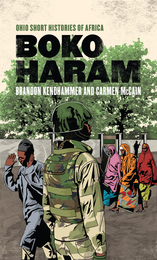 Boko Haram
Brandon Kendhammer
Ohio University Press, 2018 From its small-time origins in the early 2000s to its transformation into one of the world’s most-recognized terrorist groups, this remarkable short book tells the story of Boko Haram’s bloody, decade-long war in northeastern Nigeria. Going beyond the headlines, including the group’s 2014 abduction of 276 girls in Chibok and the international outrage it inspired, Boko Haram provides readers new to the conflict with a clearly written and comprehensive history of how the group came to be, the Nigerian government’s failed efforts to end it, and its enormous impact on ordinary citizens. Drawing on years of research, Boko Haram is a timely addition to the acclaimed Ohio Short Histories of Africa. Brandon Kendhammer and Carmen McCain—two leading specialists on northern Nigeria—separate fact from fiction within one of the world’s least-understood conflicts. Most distinctively, it is a social history, one that tells the story of Boko Haram’s violence through the journalism, literature, film, and music made by people close to it.
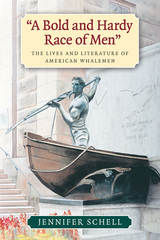 "A Bold and Hardy Race of Men": The Lives and Literature of American Whalemen
Jennifer Schell
University of Massachusetts Press, 2013 In his novel Miriam Coffin, or The Whale-Fishermen (1834), Joseph C. Hart proclaimed that his characters were "a bold and hardy race of men," who deserved the "expressive title of American Whale-Fishermen." Hart was not the only American author to applaud these physical laborers as the embodiment of national manhood. Heroic portraits of whalers first appeared in American literature during the 1780s, and they proliferated across time. Writers as various as Lydia Howard Huntley Sigourney, Frederick Douglass, and Walt Whitman celebrated the talents of the seafarers who transformed the New England whale fishery into a globally dominant industry. But these images did not go unchallenged. Alternative visions—some of which undermined the iconic status of the trade and its workers—began to proliferate. Even so, these depictions did very little to dismantle the notion that whaling men were prime exemplars of a proud American work ethic.
To explain why this industry had such a widespread and enduring impact on American literature, Jennifer Schell juxtaposes and analyzes a wide array of eighteenth- and nineteenth-century whaling narratives. Drawing on various studies of masculinity, labor history, and transnationalism, Schell shows how this particular type of maritime work, and the traits and values associated with it, helped to shape the American literary, cultural, and historical imagination. In the process, she reveals the diverse, flexible, and often contradictory meanings of gender, class, and nation in nineteenth-century America.
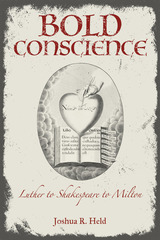 Bold Conscience: Luther to Shakespeare to Milton
Joshua R. Held
University of Alabama Press, 2023 How the conscience in early modern England emerged as a fulcrum for public action
Bold Conscience chronicles the shifting conception of conscience in early modern England, as it evolved from a faculty of restraint—what Shakespeare labels “coward conscience”—to one of bold and forthright self-assertion. The concept of conscience played an important role in post-Reformation England, from clerical leaders to laymen, not least because of its central place in determining loyalties during the English Civil War and the regicide of King Charles I. Yet the most complex and lasting perspectives on conscience emerged from deliberately literary voices—William Shakespeare, John Donne, and John Milton.
Joshua Held argues that literary texts by these authors transform the idea of conscience as a private, shameful state to one of boldness fit for navigating both royal power and common dissent in the public realm. Held tracks the increasing political power of conscience from Shakespeare’s Hamlet and Henry VIII to Donne’s court sermons and Milton’s Areopagitica, showing finally that in Paradise Lost, Milton roots boldness in the inner paradise of a pure, common conscience.
Applying a fine-grain analysis to literary England from about 1601 to 1667, this study also looks back to the 1520s, to Luther’s theological foundations of the concept, and forward to 1689, to Locke’s transformation of the idea alongside the term “consciousness.” Ultimately, Held’s study shows how conscience emerges at once as a bulwark against absolute sovereignty and as a stronghold of personal certainty.
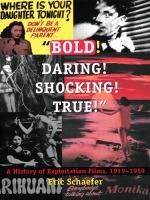 Bold! Daring! Shocking! True!: A History of Exploitation Films, 1919-1959
Eric Schaefer
Duke University Press, 1999 Unashamed nudists, high-flying hopheads, brazen strippers, vicious vice lords, and high school girls who find themselves “in trouble” comprise the population of exploitation films. In the first full-scale history of these low-budget movies of decades past, Eric Schaefer reveals how this pioneering form of “trash film” purveyed the forbidden thrills of explicit sexual behavior, drug use, and vice that the mainstream movie industry could not show.
Bold! Daring! Shocking! True! is a meticulously researched, interdisciplinary study that is informed by a wide range of sources—including both mainstream and industry newspapers and periodicals, archival accounts, personal interviews, and the films themselves. Schaefer begins by exploring the unique mode of production of exploitation movies, their distribution, and the outrageous exhibition practices that were rooted in the traditions of sideshows and carnivals. His close analysis of dozens of films, such as The Road to Ruin, Modern Motherhood, One Way Ticket to Hell, and The Wages of Sin demonstrates that these films were more than simply “bad” movies. By situating exploitation films in a historical context and organizing them according to the social problems they addressed, Schaefer shows how they evolved during a period of forty years and how, during that time, they shaped public policies and attitudes. Finally, he focuses on the changes in the postwar American film industry that led to the decline of the classical exploitation film and set the stage for the rise of “sexploitation” in the 1960s.
Engagingly written, illustrated with rare photographs, posters, production stills, and ad slicks, and offering a full filmography, Bold! Daring! Shocking! True! reveals a forgotten side of film history and American culture. It will delight and inform those interested in film history, cultural studies, American studies and history, and the many fans of exploitation films.
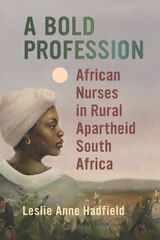 A Bold Profession: African Nurses in Rural Apartheid South Africa
Leslie Anne Hadfield
University of Wisconsin Press, 2023 In rural South African clinics, Black nurses played critical roles. Charged with administering valuable and life-saving health care measures despite a lack of equipment and personnel, these nurses had to navigate the intersections of traditional African healing practices, changing gender relations, and increasing educational and economic opportunities for South Africa’s Black middle class between the 1960s and 1980s.
Leslie Anne Hadfield compellingly demonstrates how these women were able to successfully carve out their own professional space and reshape notions of health and healing in the Eastern Cape. Bringing forth the stories of these nurses in their own voices, A Bold Profession is an homage to their dedication to the well-being of their communities. Hadfield sheds light on the struggles of balancing commitment to career and family lives during an oppressive apartheid. The volume fills an important gap for scholars studying the history of women, nursing, and health care in South Africa, illuminating the humanity of health care workers.
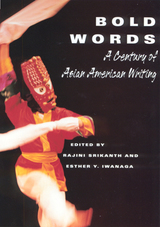 Bold Words: A Century of Asian American Writing
Edited by Rajini Srikanth
Rutgers University Press, 2001 A century of Asian American writing has generated a forceful cascade of "bold words." This anthology covers writings by Asian Americans in all genres, from the early twentieth century to the present. Some sixty authors of Chinese, Filipino, Japanese, Korean, South Asian, and Southeast Asian American origin are represented, with an equal split between male and female writers. The collection is divided into four sections-memoir, fiction, poetry, and drama-prefaced by an introductory essay from a well-known practitioner of that genre: Meena Alexander on memoir, Gary Pak on fiction, Eileen Tabios on poetry, and Roberta Uno on drama. The selections depict the complex realities and wide range of experiences of Asians in the United States. They illuminate the writers' creative responses to issues as diverse as resistance, aesthetics, biculturalism, sexuality, gender relations, racism, war, diaspora, and family. Rajini Srikanth teaches at the University of Massachusetts, Boston. She is the coeditor of the award-winning anthology Contours of the Heart: South Asians Map North America and the collection A Part, Yet Apart: South Asians in Asian America. Esther Y. Iwanaga teaches Asian American literature and literature-based writing courses at Wellesley College and the University of Massachusetts, Boston.
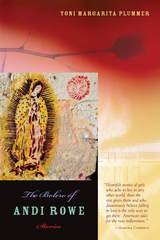 The Bolero of Andi Rowe: Stories
Toni Margarita Plummer
Northwestern University Press, 2011 Winner of the Miguel Mármol Prize, this collection of inter-related stories delves into the life of Andi Rowe—a young woman of Mexican and Irish heritage—to give an intimate account of one family’s passage from the immigrant story to the American story, and the cycle of loss, adaptation, and rediscovery that is innate to that experience.
Set largely in Los Angeles’s San Gabriel Valley, and crossing generations and borders, these stories focus on the quiet moments between explosions, where tension simmers just beneath the surface. From a Border Patrol agent whose own mother crossed the border illegally to a lonely woman seeking companionship with her hired day-laborer, characters seek revelation in the most ordinary of experiences, their actions filled with humor, longing, and honesty.
In the tradition of Flannery O’Connor, Toni Margarita Plummer explores themes of grace and redemption as each story spirals toward a surprising but inevitable conclusion. The Bolero of Andi Rowe, an impressive work by an exciting new talent, offers a compassionate look at the struggle between meeting cultural expectations and seeking happiness, and the sacrifices and triumphs made along the way.
The Boletes of Michigan
Alexander H. Smith and Harry D. Thiers
University of Michigan Press, 1971 Contains data on approximately 200 species and varieties of members of the fleshy pore fungi, Boletaceae
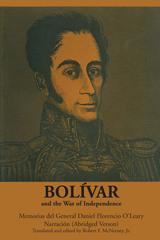 Bolívar and the War of Independence: Memorias del General Daniel Florencio O’Leary, Narración
By Daniel Florencio O'Leary
University of Texas Press, 1970 The overthrow of Spanish rule and the birth of new republican governments in northern South America at the beginning of the nineteenth century were in large part the work of one man—Simón Bolívar. Bolívar was not only the soldier who built a patriot army from a small band of exiles and led them victoriously across Venezuela and down the spine of the Andes as far as Potosí; he was also the statesman who framed the new republics that sprang to life after the defeat of the Spanish and who called the Congress of Panama in hopes of making real his dream of uniting all the South American republics in a single confederation. He was truly the Liberator. The Narración, or narrative, of the Memorias of Daniel Florencio O’Leary has long been recognized by Spanish American scholars as one of the most important historical sources for a major part of Bolívar’s life. O’Leary took an active part in the wars for independence, first as a young officer, recruited in the British Isles to aid the patriot cause, and later as Bolívar’s chief aide, often entrusted with diplomatic missions. His firsthand knowledge of the stirring events of the period, his access to relevant documents, and his close association with the major figures in the struggle, as well as his friendship with Bolívar, made O’Leary a particularly valuable chronicler and biographer. Bolívar himself, shortly before his death, requested that O’Leary write the story of his life. O’Leary’s meticulous attention to military and diplomatic maneuvers and his keen, sometimes acrid, comments on both men and events give the reader not only a vivid portrait of Bolívar—the man and his achievements—but also a remarkable insight into O’Leary’s own position as an autocratic-minded participant in the wars for independence. Although O’Leary’s devotion to, and admiration for, his Chief make for an occasionally partisan view, his stark account of the hardships and disappointments that Bolívar and his armies overcame against almost impossible odds does much to balance the narrative. In his abridged translation, Robert McNerney has omitted the Apéndice, documents that O’Leary, had he lived, undoubtedly would have used as the source for completing his account of Bolívar’s life. Numerous letters and documents scattered through the original text also have been omitted, leaving a highly readable narrative.
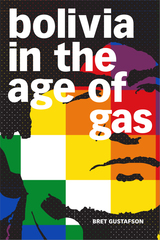 Bolivia in the Age of Gas
Bret Gustafson
Duke University Press, 2020 Evo Morales, Bolivia's first Indigenous president, won reelection three times on a leftist platform championing Indigenous rights, anti-imperialism, and Bolivian control over the country's natural gas reserves. In Bolivia in the Age of Gas, Bret Gustafson explores how the struggle over natural gas has reshaped Bolivia, along with the rise, and ultimate fall, of the country's first Indigenous-led government. Rethinking current events against the backdrop of a longer history of oil and gas politics and military intervention, Gustafson shows how natural gas wealth brought a measure of economic independence and redistribution, yet also reproduced political and economic relationships that contradicted popular and Indigenous aspirations for radical change. Though grounded in the unique complexities of Bolivia, the volume argues that fossil-fuel political economies worldwide are central to the reproduction of militarism and racial capitalism and suggests that progressive change demands moving beyond fossil-fuel dependence and the social and ecological ills that come with it.
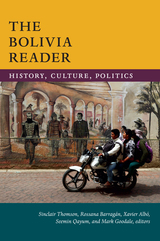 The Bolivia Reader: History, Culture, Politics
Sinclair Thomson, Rossana Barragán, Xavier Albó, Seemin Qayum, and Mark Goodale, editors
Duke University Press, 2018 The Bolivia Reader provides a panoramic view, from antiquity to the present, of the history, culture, and politics of a country known for its ethnic and regional diversity, its rich natural resources and dilemmas of economic development, and its political conflict and creativity. Featuring both classic and little-known texts ranging from fiction, memoir, and poetry to government documents, journalism, and political speeches, the volume challenges stereotypes of Bolivia as a backward nation while offering insights into the country's history of mineral extraction, revolution, labor organizing, indigenous peoples' movements, and much more. Whether documenting Inka rule or Spanish conquest, three centuries at the center of Spanish empire, or the turbulent politics and cultural vibrancy of the national period, these sources—the majority of which appear in English for the first time—foreground the voices of actors from many different walks of life. Unprecedented in scope, The Bolivia Reader illustrates the historical depth and contemporary challenges of Bolivia in all their complexity.
Bolivia: Refounding the Nation
Kepa Artaraz
Pluto Press, 2012 The election of the Movimiento al Socialismo (MAS, movement towards socialism) to power in Bolivia in 2006 marked a historic break from centuries of foreign domination and indigenous marginalisation. Evo Morales, leader of the MAS, became the first indigenous president of Bolivia.
Kepa Artaraz looks at the attempt to 'refound the nation' which the new government has made as its goal. He shows how the mix of Marxism, indigenous liberation politics, anti-imperialism and environmentalism has made Bolivia one of the most interesting and unique political experiments of Latin America's 'red decade'.
As the historic left-turn in Latin America reaches a crossroads, Bolivia: Refounding the Nation guides us through the politics and ideas which have animated this popular movement, drawing out important lessons for progressive politics everywhere.
Bolivia: Revolution and the Power of History in the Present
James Dunkerley
University of London Press, 2007 This volume brings together essays written over three decades on Bolivian history and politics. The book opens with a contemporary survey of the new government of the MAS headed by Evo Morales. Subsequent chapters review the neoliberal experiments of the 1980s and 1990s, the strategic and intellectual failures of Che Guevara's guerrilla foco; the origins of the Revolution of 1952; explanations for the dominance of the caudillos of the 19th century; and the extraordinary story of Francisco Burdett O'Connor, whose life combined liberation struggles on both sides of the Atlantic.
Bolivia: The Uncompleted Revolution
James Malloy
University of Pittsburgh Press, 1970 The first book-length analysis of the Bolivian revolution by an American political scientist explains the events of 1952 as a Latin American case study, and links the theme of the revolution with other contemporary insurrections in underdeveloped countries. Combining narrative excitement and scholarly analysis, the book pinpoints sources of weakness and stress in the Bolivian old order, with particular attention to the effects of uneven economic developments in the first two decades of the twentieth century. It then focuses on the stormy years after 1936 that led up to the insurrection of April 9-11, 1952. Finally, it examines attempts of the revolutionary government to promote economic development between 1952 and November 1964, when it was overthrown.
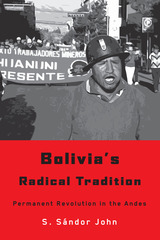 Bolivia's Radical Tradition: Permanent Revolution in the Andes
S. Sándor John
University of Arizona Press, 2012 In December 2005, following a series of convulsive upheavals that saw the overthrow of two presidents in three years, Bolivian peasant leader Evo Morales became the first Indian president in South American history. Consequently, according to S. Sándor John, Bolivia symbolizes new shifts in Latin America, pushed by radical social movements of the poor, the dispossessed, and indigenous people once crossed off the maps of "official" history. But, as John explains, Bolivian radicalism has a distinctive genealogy that does not fit into ready-made patterns of the Latin American left.
According to its author, this book grew out of a desire to answer nagging questions about this unusual place. Why was Bolivia home to the most persistent and heroically combative labor movement in the Western Hemisphere? Why did this movement take root so deeply and so stubbornly? What does the distinctive radical tradition of Trotskyism in Bolivia tell us about the past fifty years there, and what about the explosive developments of more recent years? To answer these questions, John clearly and carefully pieces together a fragmented past to show a part of Latin American radical history that has been overlooked for far too long. Based on years of research in archives and extensive interviews with labor, peasant, and student activists—as well as Chaco War veterans and prominent political figures—the book brings together political, social, and cultural history, linking the origins of Bolivian radicalism to events unfolding today in the country that calls itself "the heart of South America."
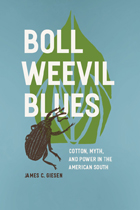 Boll Weevil Blues: Cotton, Myth, and Power in the American South
James C. Giesen
University of Chicago Press, 2011 Between the 1890s and the early 1920s, the boll weevil slowly ate its way across the Cotton South from Texas to the Atlantic Ocean. At the turn of the century, some Texas counties were reporting crop losses of over 70 percent, as were areas of Louisiana, Arkansas, and Mississippi. By the time the boll weevil reached the limits of the cotton belt, it had destroyed much of the region’s chief cash crop—tens of billions of pounds of cotton, worth nearly a trillion dollars.
As staggering as these numbers may seem, James C. Giesen demonstrates that it was the very idea of the boll weevil and the struggle over its meanings that most profoundly changed the South—as different groups, from policymakers to blues singers, projected onto this natural disaster the consequences they feared and the outcomes they sought. Giesen asks how the myth of the boll weevil’s lasting impact helped obscure the real problems of the region—those caused not by insects, but by landowning patterns, antiquated credit systems, white supremacist ideology, and declining soil fertility. Boll Weevil Blues brings together these cultural, environmental, and agricultural narratives in a novel and important way that allows us to reconsider the making of the modern American South.
Bollywood’s New Woman: Liberalization, Liberation, and Contested Bodies
Megha Anwer
Rutgers University Press, 2021 Bollywood’s New Woman examines Bollywood’s construction and presentation of the Indian Woman since the 1990s. The groundbreaking collection illuminates the contexts and contours of this contemporary figure that has been identified in sociological and historical discourses as the “New Woman.” On the one hand, this figure is a variant of the fin de siècle phenomenon of the “New Woman” in the United Kingdom and the United States. In the Indian context, the New Woman is a distinct articulation resulting from the nation’s tryst with neoliberal reform, consolidation of the middle class, and the ascendency of aggressive Hindu Right politics.
Bolor Erike: Mongolian Chronicle
Rasipungsuy
Harvard University Press Third in the Scripta Mongolica series, this book reproduces a rare printed text of the Bolor Erike or Chaplet of Crystals, written in the 18th century but preserving a number of recitals, some unknown elsewhere, relating to Chinggis Qaghan and his line and to the history of the Mongols under the Chinese Ming dynasty. The dean of the world’s Mongolists provides a thorough textual and historical analysis.
 Bolshevik Sexual Forensics: Diagnosing Disorder in the Clinic and Courtroom, 1917-1939
Dan Healey
Northern Illinois University Press, 2009
In an effort to modernize criminal and civil investigations, early Bolsheviks gave forensic doctors—most of whom had been trained under the tsarist regime—new authority over issues of sexuality. Revolutionaries believed that forensic medicine could provide scientific and objective solutions to sexual disorder in the new society. Bolshevik Sexual Forensics explores the institutional history of Russian and Soviet forensic medicine and examines the effects of its authority when confronting sexual disorder. Healey compares sex crime investigations from Petrograd and Sverdlovsk in the 1920s to the numerous publications by forensic doctors and psychiatrists of the prerevolutionary and early Soviet periods to illustrate the role that these specialists played. In addition, Healey presents a fascinating look at how doctors diagnosed and treated hermaphroditism, showing how Soviet physicians revolutionized the standard scientific view in these cases by taking into account individual desire.
This study sheds light on unexplored radical and reactionary forces that shaped the Bolshevik “sexual revolution” as lawmakers defined new ways of seeing sexual crime and disorder. Forensic doctors struggled to interpret the replacement of the age of consent with a standard of “sexual maturity,” a designation that made female sexuality a collective “resource,” not part of an individual’s personality. “Innocence,” “experience,” and virginity played a major role in the expertise doctors furnished in rape and abuse trials. Psychiatrists recoiled from the language of sexual psychology in their investigations of sex criminals. Yet in the clinic, Soviet physicians probed the desires of the two-sexed citizen, whose psychology served as the basis for a distinctly modern approach to the “erasure” of the hermaphrodite.
Healey concludes that the vision of men and women as equals after a “sexual revolution” was undermined from the outset of the Soviet experiment. Law and medicine failed to protect women and girls from violence, and Soviet medicine’s physiological and biological model of sexual citizenship erased the vision of sexual self-expression, especially for women. This groundbreaking study will appeal to Soviet historians and those interested in gender studies, sexuality, medicine, and forensics.
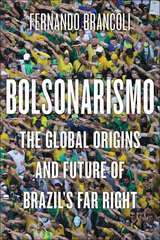 Bolsonarismo: The Global Origins and Future of Brazil’s Far Right
Fernando Brancoli
Rutgers University Press, 2024 Bolsonarismo: The Global Origins and Future of Brazil’s Far Right documents the rise of the far-right alliance that emerged in Brazil in 2020 around the figure of former president Jair Bolsonaro. Unlike a cohesive organization with uniform practices, Bolsonarismo is marked by fragmentation and a broad variety of ideologies. Fernando Brancoli delves deeply into how Bolsonarismo has developed a specific political orientation through its partnerships with other groups, practices, and subjectivities within Brazil, as well as internationally.
Through interviews, archival research, and newly available public documents, this book presents a comprehensive and compelling portrait of the neo-evangelical pastors, military personnel, and meritocratic ideologues who are the actors behind the far-right movement. Adding to our understanding of Bolsonarismo's growth in Brazilian politics and the contributing factors behind it, the book also sheds light on the impact of Bolsonarismo on world politics. As a prominent leader of the far-right movement, Jair Bolsonaro's political views and policies have reverberated beyond Brazil's borders, influencing the discourse on issues such as climate change, democracy, and human rights around the world.
 The Bomb: A Life
Gerard J. DeGroot
Harvard University Press, 2005 Bombs are as old as hatred itself. But it was the twentieth century--one hundred years of incredible scientific progress and terrible war--that brought forth the Big One, the Bomb, humanity's most powerful and destructive invention. In The Bomb: A Life, Gerard DeGroot tells the story of this once unimaginable weapon that--at least since 8:16 a.m. on August 6, 1945--has haunted our dreams and threatened our existence.
The Bomb has killed hundreds of thousands outright, condemned many more to lingering deaths, and made vast tracts of land unfit for life. For decades it dominated the psyches of millions, becoming a touchstone of popular culture, celebrated or decried in mass political movements, films, songs, and books. DeGroot traces the life of the Bomb from its birth in turn-of-the-century physics labs of Europe to a childhood in the New Mexico desert of the 1940s, from adolescence and early adulthood in Nagasaki and Bikini, Australia and Kazakhstan to maturity in test sites and missile silos around the globe. His book portrays the Bomb's short but significant existence in all its scope, providing us with a portrait of the times and the people--from Oppenheimer to Sakharov, Stalin to Reagan--whose legacy still shapes our world.
Bomb Children: Life in the Former Battlefields of Laos
Leah Zani
Duke University Press, 2019 Half a century after the CIA's Secret War in Laos—the largest bombing campaign in history—explosive remnants of war continue to be part of people's everyday lives. In Bomb Children Leah Zani offers a perceptive analysis of the long-term, often subtle, and unintended effects of massive air warfare. Zani traces the sociocultural impact of cluster submunitions—known in Laos as “bomb children”—through stories of explosives clearance technicians and others living and working in these old air strike zones. Zani presents her ethnography alongside poetry written in the field, crafting a startlingly beautiful analysis of state terror, authoritarian revival, rapid development, and ecological contamination. In so doing, she proposes that postwar zones are their own cultural and area studies, offering new ways to understand the parallel relationship between ongoing war violence and postwar revival.
 The Bombardment of Åbo: A Novella Based on a Historical Event in Modern Times
Carl Spitteler
Central European University Press, 2022 This farcical tale tells how the British bombing of a Finnish port city changes the life of the Russian governor, his wife, their cook, and the cook's Finnish fiancé. The story takes place during a Nordic offshoot of the Crimean conflict, known as the Åland War, in which a British-French naval force attacked military and civilian facilities on the coast of the Grand Duchy of Finland in 1854–1856. The location of the novella is Åbo, today’s Turku, where soldiers in the Russian garrison enjoy life, Cossacks dance and drink, and the governor’s wife is preoccupied about her cook’s marriage to a local lad, against which the governor and the English admiral devise a plot. After studies in Swiss and German universities, Carl Spitteler worked in Russia between 1871 and 1879 as the private tutor in the family of a Finnish general. In the process he came to know Finnish and Baltic noble families in Saint Petersburg and Finland. He published this story in 1889, and went on to become, in 1919, the first Swiss winner of the Nobel Prize for literature. The Bombardment of Åbo is an ironic Western gaze on life and culture in the Tsarist Empire. Spitteler’s deeply held pacifism breaks through his otherwise sarcastic description of the characters and episodes in the novella.
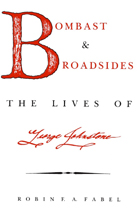 Bombast And Broadsides: The Lives of George Johnstone
Robin F. A. Fabel
University of Alabama Press, 1987 Presents the first coherent picture of George Johnstone, a controversial naval commander and governor of West Florida
George Johnstone has never received the scholarly attention he fully merits. Historians have assessed him, usually briefly, as governor of West Florida, or as naval commander, or as a member of parliament. Nevertheless, none has considered his important role in East India Company politics, nor, until Bombast and Broadsides, has one synthesized the various roles in which Johnstone was entrusted with high responsibilities.
Through research in Cardiff, Edinburgh, Kew, London, Philadelphia, and Washington in largely unpublished manuscripts, together with the use of secondary sources, the author has been able to present the first coherent picture of Johnstone, a vigorous and intelligent but turbulent and always controversial figure. Johnstone was effective as a colonial governor at a difficult time; in the navy he performed several coups de main; in parliament he was formidable in debate but an opportunist; and at East India House he was a doughty, conservative, and largely successful defender of the proprietary interest.
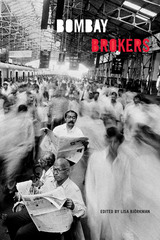 Bombay Brokers
Lisa Björkman, editor
Duke University Press, 2021 A political party worker who produces crowds for electoral rallies. A “prison specialist” who serves other people’s prison sentences in exchange for a large fee. An engineer who is able to secure otherwise impossible building permits. These and other dealmakers—whose behind-the-scenes expertise and labor are often invisible—have an intrinsic role in the city's functioning and can be indispensable for navigating everyday life in Bombay, one of the world’s most complex, dynamic, and populous cities. Bombay Brokers collects profiles of thirty-six such “brokers.” Written by anthropologists, artists, city planners, and activists, these character sketches bring into relief the paradox that these brokers’ knowledge and labor are simultaneously invisible yet essential for Bombay’s functioning. Their centrality reveals the global-scale paradoxes and gaps that these brokers mediate and bridge. In this way, Bombay Brokers prompts a reconsideration of what counts as legitimate and valuable knowledge and labor while offering insight into changing structures of power in Bombay and around the globe.
Contributors. Anjali Arondekar, Sarthak Bagchi, Tobias Baitsch, Sangeeta Banerji, Srimati Basu, Tarini Bedi, Amita Bhide, Lisa Björkman, Uday Chandra, Simon Chauchard, Ka-Kin Cheuk, Michael Collins, Daisy Deomampo, Maura Finkelstein, Ajay Gandhi, Rupali Gupte, Kathryn C. Hardy, Lalitha Kamath, Prasad Khanolkar, Bhushan Korgaonkar, Ratoola Kundu, Ken Kuroda, Annelies Kusters, Lisa Mitchell, Shailaja Paik, Gautam Pemmaraju, Lubaina Rangwala, Llerena Guiu Searle, Atreyee Sen, Prasad Shetty, Rohan Shivkumar, Edward Simpson, David Strohl, Rachel Sturman, R. Swaminathan, Aneri Taskar, Yaffa Truelove, Sahana Udupa, Lalit Vachani, Leilah Vevaina
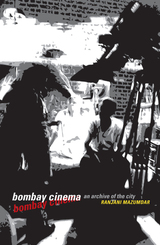 Bombay Cinema: An Archive of the City
Ranjani Mazumdar
University of Minnesota Press, 2007 Cinema is not only a major industry in India, it is a powerful cultural force. But until now, no one has undertaken a major examination of the ways in which films made in Bombay mediate the urban experience in India. In Bombay Cinema, Ranjani Mazumdar takes a multidisciplinary approach to understanding Bombay cinema as the unofficial archive of the city in India. In this analysis of the cinematic city, Mazumdar reveals a complex postnationalist world, convulsed by the social crisis of the 1970s and transformed by the experience of globalization in the 1990s. She argues that the upheaval of postcolonial nationalism led to Bombay cinema’s articulation of urban life in entirely new terms. Specifically, the place of the village in the imaginary constitution of anticolonial nationalism gave way to a greater acknowledgment, even centrality, of urban space. Bombay Cinema takes the reader on an inventive journey through a cinematic city of mass crowds, violence, fashion, architectural fantasies, and subcultural identities. Moving through the world of gangsters and vamps, families and drifters, and heroes and villains, Bombay Cinema explores an urban landscape marked by industrial decline, civic crisis, working-class disenchantment, and diverse street life.Combining the anecdotal with the theoretical, the philosophical with the political, and the textual with the historical, Bombay Cinema leads the reader into the heart of the urban labyrinth in India, revising and deepening our understanding of both the city and the cinema. "A landmark study—carefully researched, well organized and offering refreshingly uncondescending and strikingly insightful discussions of mainstream films—that deserves to be read by anyone interested in India's popular cinema or its contemporary urban life." — Journal of Asian Studies " Bombay Cinema is an exciting and important contribution to a field that has, to date, been under researched and under theorized. Lively, provocative and richly suggestive, it will also serve as a surefire incentive to watch those films all over again." — Screen "Here, at last, is a book length study on Cinema in India that does not get locked into a dance of hermetic closure between what transpires on screen and a set of stock off screen textual and cultural references, but more importantly, walks the streets where the films are set, looks at shop windows, publicity material, costumes, fashion, architecture, telecommunications and the concrete materiality that surrounds the film object." — Seminar " Bombay Cinema is lucid, provocative, stylish and substantial. It is an illuminating scholarly study that spares no effort to bring Bombay cinema out of the academic closet." — The Book Review India "Departing from the obsession that Film Studies in India has displayed with the idea of cinema as a national allegory, the book convincingly argues for the need to examine the city's hidden archive as one that cannot be subsumed within the sign of the national." — Biblio "Mazumdar has a great capacity to discuss Indian cinema, with a brilliant grasp of its political, historical, and aesthetic developments, but equally she is well attuned to the interests and ruptures in the academic discourse of film and cinema studies."— Film International "Mazumdar's experience as a filmmaker allowed her to offer significant readings of not just the narratives and character development in the films, but of the cinematography, mise-en-scene, and other technical and performance aspects of production." — Journal of Popular Culture "At once about Hindi films, spatial practices, urban modernity and globalization . . . the strength of Bombay Cinema lies in bringing all of them together in a productive conversation.” — Economic and Political Weekly " Bombay Cinema is methodologically challenging in its deployment of moments rather than discursiveformations of film as text. The book also refuses to read film alone, but interprets the medium alongside the detailed insights of people involved in making them, and with the recent history of Bombay, within which the film industry is located. In Mazumdar's evocative reading of the films she engages with, the cinematic city becomes the space of critique of the nation, the site of the ruin of the modern nationalist project." — Contemporary South Asia
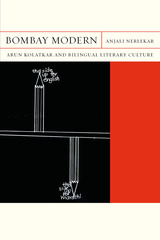 Bombay Modern: Arun Kolatkar and Bilingual Literary Culture
Anjali Nerlekar
Northwestern University Press, 2016 Anjali Nerlekar's Bombay Modern is a close reading of Arun Kolatkar's canonical poetic works that relocates the genre of poetry to the center of both Indian literary modernist studies and postcolonial Indian studies. Nerlekar shows how a bilingual, materialist reading of Kolatkar's texts uncovers a uniquely resistant sense of the "local" that defies the monolinguistic cultural pressures of the post-1960 years and straddles the boundaries of English and Marathi writing.
Bombay Modern uncovers an alternative and provincial modernism through poetry, a genre that is marginal to postcolonial studies, and through bilingual scholarship across English and Marathi texts, a methodology that is currently peripheral at best to both modernist studies and postcolonial literary criticism in India. Eschewing any attempt to define an overarching or universal modernism, Bombay Modern delimits its sphere of study to "Bombay" and to the "post-1960" (the sathottari period) in an attempt to examine at close range the specific way in which this poetry redeployed the regional, the national, and the international to create a very tangible yet transient local.
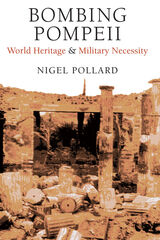 Bombing Pompeii: World Heritage and Military Necessity
Nigel Pollard
University of Michigan Press, 2020 Bombing Pompeii examines the circumstances under which over 160 Allied bombs hit the archaeological site of Pompeii in August and September 1943, and the wider significance of this event in the history of efforts to protect cultural heritage in conflict zones, a broader issue which is still of great importance. From detailed examinations of contemporary archival document, Nigel Pollard shows that the bomb damage to ancient Pompeii was accidental, and the bombs were aimed at road and rail routes close to the site in an urgent attempt to slow down the reinforcement and supply of German counter- attacks that threatened to defeat the Allied landings in the Gulf of Salerno. The book sets this event, along with other instances of damage and risk to cultural heritage in Italy in the Second World War, in the context of the development of the Allied Monuments, Fine Arts, and Archives – the “Monuments Men.”
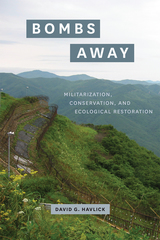 Bombs Away: Militarization, Conservation, and Ecological Restoration
David G. Havlick
University of Chicago Press, 2018 When viewed from space, the Korean Peninsula is crossed by a thin green ribbon. On the ground, its mix of dense vegetation and cleared borderlands serves as home to dozens of species that are extinct or endangered elsewhere on the peninsula. This is Korea’s demilitarized zone—one of the most dangerous places on earth for humans, and paradoxically one of the safest for wildlife. Although this zone was not intentionally created for conservation, across the globe hundreds of millions of acres of former military zones and bases are being converted to restoration areas, refuges, and conservation lands. David G. Havlick has traveled the world visiting these spaces of military-to-wildlife transition, and in Bombs Away he explores both the challenges—physical, historical, and cultural—and fascinating ecological possibilities of military site conversions.
Looking at particular international sites of transition—from Indiana’s Big Oaks National Wildlife Refuge to Cold War remnants along the former Iron Curtain—Havlick argues that these new frontiers of conservation must accomplish seemingly antithetical aims: rebuilding and protecting ecosystems, or restoring life, while also commemorating the historical and cultural legacies of warfare and militarization. Developing these ideas further, he shows that despite the ecological devastation often wrought by military testing and training, these activities need not be inconsistent with environmental goals, and in some cases can even complement them—a concept he calls ecological militarization. A profound, clear explication of landscapes both fraught and fecund, marked by death but also reservoirs of life, Bombs Away shows us how “military activities, conservation goals, and ecological restoration efforts are made to work together to create new kinds of places and new conceptions of place.”
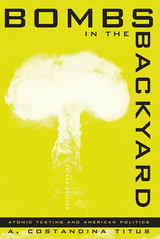 Bombs in the Backyard: Atomic Testing and American Politics
A. Constandina Titus
University of Nevada Press, 2001 On January 27, 1951, the first atomic weapon was detonated over a section of desert known as Frenchman Flat in southern Nevada, providing dramatic evidence of the Nevada Test Site's beginnings. Fifty years later, author A. Costandina Titus reviews contemporary nuclear policy issues concerning the continued viability of that site for weapons testing. Titus has updated her now-classic study of atomic testing with fifteen years of political and cultural history, from the mid-1980s Reagan-Gorbachev nuclear standoff to the authorization of the Nevada Test Site Research Center, a Desert Research Institute facility scheduled to open in 2001. In this second edition of Bombs in the Backyard, Titus deftly covers the post-Cold War transformation of American atomic policy as well as our overarching cultural interest in all matters atomic, making this a must-read for anyone interested in atomic policy and politics.
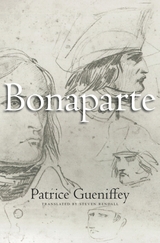 Bonaparte: 1769–1802
Patrice Gueniffey
Harvard University Press, 2015 Patrice Gueniffey is the leading French historian of the Revolutionary and Napoleonic age. This book, hailed as a masterwork on its publication in France, takes up the epic narrative at the heart of this turbulent period: the life of Napoleon himself, the man who—in Madame de Staël’s words—made the rest of “the human race anonymous.” Gueniffey follows Bonaparte from his obscure boyhood in Corsica, to his meteoric rise during the Italian and Egyptian campaigns of the Revolutionary wars, to his proclamation as Consul for Life in 1802. Bonaparte is the story of how Napoleon became Napoleon. A future volume will trace his career as emperor.
Most books approach Napoleon from an angle—the Machiavellian politician, the military genius, the life without the times, the times without the life. Gueniffey paints a full, nuanced portrait. We meet both the romantic cadet and the young general burning with ambition—one minute helplessly intoxicated with Josephine, the next minute dominating men twice his age, and always at war with his own family. Gueniffey recreates the violent upheavals and global rivalries that set the stage for Napoleon’s battles and for his crucial role as state builder. His successes ushered in a new age whose legacy is felt around the world today.
Averse as we are now to martial glory, Napoleon might seem to be a hero from a bygone time. But as Gueniffey says, his life still speaks to us, the ultimate incarnation of the distinctively modern dream to will our own destiny.
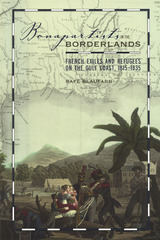 Bonapartists in the Borderlands: French Exiles and Refugees on the Gulf Coast, 1815-1835
Rafe Blaufarb
University of Alabama Press, 2005 Provides an important revision of the causes of the failure of France's Vine and Olive Colony in Alabama, placing it within the context of America's westward expansion
Bonapartists in the Borderlands debunks the standard account of the Vine and Olive Colony, which stresses the failure of aristocratic, luxury-loving French to tame the wilderness. Rafe Blaufarb recounts how Napoleonic exiles and French refugees from Europe and the Caribbean joined forces with Latin American insurgents, Gulf pirates, and international adventurers to seek their fortune in the Gulf borderlands. The US Congress welcomed the French and granted them a capacious tract of rich Black Belt land near Demopolis, Alabama, on the condition that they would establish a Mediterranean-style Vine and Olive colony.
Blaufard shows that it was not a lack of grit that caused the enterprise to fail. Rather, the Napoleonic officers involved in the colony sold their land shares to speculators to finance an even more perilous adventure—invading the Texas borderlands contested by Spain and the US. Their departure left the Vine and Olive colony in the hands of French refugees from the Haitian slave revolt. They soon abandoned vine cultivation and fused with the neighboring communities of Anglo-American slaveholding cotton planters and speculators.
Rafe Blaufarb examines the underlying motivations and aims that inspired this endeavor and details the nitty-gritty politics, economics, and backroom bargaining that resulted in the settlement. He employs a wide variety of local, national, and international resources: from documents held by the Alabama State Archives, Marengo County court records, and French-language newspapers published in America to material from the War Ministry Archives at Vincennes, the Diplomatic Archives at the Quai d’Orasy, and the French National Archives.
Bonar Law
Andrew Taylor
Haus Publishing, 2006 Part of the Prime Ministers Series, Law was a Conservative who opposed Home rule for Ireland
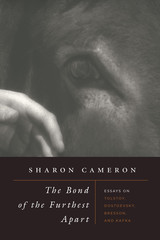 The Bond of the Furthest Apart: Essays on Tolstoy, Dostoevsky, Bresson, and Kafka
Sharon Cameron
University of Chicago Press, 2017 In the French filmmaker Robert Bresson’s cinematography, the linkage of fragmented, dissimilar images challenges our assumption that we know either what things are in themselves or the infinite ways in which they are entangled. The “bond” of Sharon Cameron’s title refers to the astonishing connections found both within Bresson’s films and across literary works by Tolstoy, Dostoevsky, and Kafka, whose visionary rethinkings of experience are akin to Bresson’s in their resistance to all forms of abstraction and classification that segregate aspects of reality.
Whether exploring Bresson’s efforts to reassess the limits of human reason and will, Dostoevsky’s subversions of Christian conventions, Tolstoy’s incompatible beliefs about death, or Kafka’s focus on creatures neither human nor animal, Cameron illuminates how the repeated juxtaposition of disparate, even antithetical, phenomena carves out new approaches to defining the essence of being, one where the very nature of fixed categories is brought into question. An innovative look at a classic French auteur and three giants of European literature, The Bond of the Furthest Apart will interest scholars of literature, film, ethics, aesthetics, and anyone drawn to an experimental venture in critical thought.
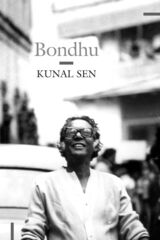 Bondhu: My Father, My Friend
Kunal Sen
Seagull Books, 2023 A behind-the-scenes look at the life of filmmaker Mrinal Sen through the eyes of his son Kunal, who grew up immersed in the world of Indian cinema.
“No one remembers when and why I started calling my father Bondhu. It was a strange way to address a father, as the word means ‘friend’ in Bengali. . . . As I got older, I became very self-conscious about such an odd name . . . and yet I cannot explain why I could not switch to the more acceptable Baba or something similar.”
Just as Kunal Sen, son of actor Gita Sen and filmmaker Mrinal Sen, was approaching adolescence, his father’s cinematic celebrity was reaching new heights. In this memoir, Kunal reflects on growing up in a middle-class household in South Calcutta, where his father’s Marxist beliefs and unrelenting urge “to be challenged and contradicted” often collided with the practical challenges of making a living. Through it all, what emerges is a picture of a family’s unyielding commitment to the craft of cinema, the risks each of its members took, and their endearing sense of humor. Celebrating Mrinal Sen’s birth centenary in 2023, Bondhu takes us on an intimate journey of a son attempting to reconcile his father’s public and private selves.
Bondmen and Rebels: A Study of Master-Slave Relations in Antigua
David Barry Gaspar
Duke University Press, 1985 Originally published in 1985, and available for the first time in paperback, Bondmen & Rebels provides a pioneering study of slave resistance in the Americas. Using the large-scale Antigua slave conspiracy of 1736 as a window into that society, David Barry Gaspar explores the deeper interactive character of the relation between slave resistance and white control.
 Bonds of Affection: Civic Charity and the Making of America--Winthrop, Jefferson, and Lincoln
Matthew S. Holland
Georgetown University Press, 2007 Notions of Christian love, or charity, strongly shaped the political thought of John Winthrop, Thomas Jefferson, and Abraham Lincoln as each presided over a foundational moment in the development of American democracy. Matthew Holland examines how each figure interpreted and appropriated charity, revealing both the problems and possibilities of making it a political ideal. Holland first looks at early American literature and seminal speeches by Winthrop to show how the Puritan theology of this famed 17th century governor of the Massachusetts Colony (he who first envisioned America as a "City upon a Hill") galvanized an impressive sense of self-rule and a community of care in the early republic, even as its harsher aspects made something like Jefferson's Enlightenment faith in liberal democracy a welcome development . Holland then shows that between Jefferson's early rough draft of the Declaration of Independence and his First Inaugural Jefferson came to see some notion of charity as a necessary complement to modern political liberty. However, Holland argues, it was Lincoln and his ingenious blend of Puritan and democratic insights who best fulfilled the promise of this nation's "bonds of affection." With his recognition of the imperfections of both North and South, his humility in the face of God's judgment on the Civil War, and his insistence on "charity for all," including the defeated Confederacy, Lincoln personified the possibilities of religious love turned civic virtue. Weaving a rich tapestry of insights from political science and literature and American religious history and political theory, Bonds of Affection is a major contribution to the study of American political identity. Matthew Holland makes plain that civic charity, while commonly rejected as irrelevant or even harmful to political engagement, has been integral to our national character. The book includes the full texts of Winthrop's speech "A Model of Christian Charity"; Jefferson's rough draft of the Declaration and his First Inaugural; and Lincoln's Second Inaugural.
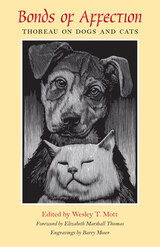 Bonds of Affection: Thoreau on Dogs and Cats
Wesley T. Mott
University of Massachusetts Press, 2005 How many a man has dated a new era in his life from the reading of a book, wrote Henry David Thoreau in Walden. Today that book continues to provoke, inspire, and change lives all over the world, and each rereading is fresh and challenging. Yet as Thoreau's countless admirers know, there is more to the man than Walden. An engineer, poet, teacher, naturalist, lecturer, and political activist, he truly had multiple lives to lead, and each one speaks forcefully to us today.Sponsored by the Thoreau Society, the brief, handsomely presented books in this series offer the thoughts of a great writer on a variety of topics, some that we readily associate with him, some that may be surprising. Each volume includes selections from his familiar published works as well as from less well known lectures, letters, and journal entries. The books include original engravings by renowned illustrator and book artist Barry Moser.
 Bonds of Enterprise: John Murray Forbes and Western Development in America's Railway Age
John Lauritz Larson
University of Iowa Press, 2001 Bonds of Enterprise uses the life of railroad entrepreneur John Murray Forbes to explore the shift from antebellum merchant capitalism to late ninetieth-century corporate capitalism, the rise of big business, technological innovations, farmer agitation for railroad rate control, and the process of government regulations. Forbes started off his business life as a China trader in the 1830s, returned to the States in time to surmount the Panic of 1837, and then—deciding that railroad construction should be based on existing settlement and traffic systems rather than speculative ambitions—became a master builder, beginning with the Michigan Central Railroad and ending with the Chicago, Burlington & Quincy system and the growth of Chicago as a railroad hub. Focusing on Forbes’s life allows Larson to elaborate on the contest of wills between eastern capitalists and Midwestern boosters and the complex patterns of regional growth, particularly in Iowa, Illinois, Michigan, and Nebraska.
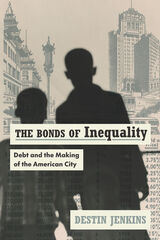 The Bonds of Inequality: Debt and the Making of the American City
Destin Jenkins
University of Chicago Press, 2021 Indebtedness, like inequality, has become a ubiquitous condition in the United States. Yet few have probed American cities’ dependence on municipal debt or how the terms of municipal finance structure racial privileges, entrench spatial neglect, elide democratic input, and distribute wealth and power.
In this passionate and deeply researched book, Destin Jenkins shows in vivid detail how, beyond the borrowing decisions of American cities and beneath their quotidian infrastructure, there lurks a world of politics and finance that is rarely seen, let alone understood. Focusing on San Francisco, The Bonds of Inequality offers a singular view of the postwar city, one where the dynamics that drove its creation encompassed not only local politicians but also banks, credit rating firms, insurance companies, and the national municipal bond market. Moving between the local and the national, The Bonds of Inequality uncovers how racial inequalities in San Francisco were intrinsically tied to municipal finance arrangements and how these arrangements were central in determining the distribution of resources in the city. By homing in on financing and its imperatives, Jenkins boldly rewrites the history of modern American cities, revealing the hidden strings that bind debt and power, race and inequity, democracy and capitalism.
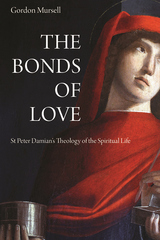 The Bonds of Love: St. Peter Damian's Theology of the Spiritual Life
Gordon Mursell
Catholic University of America Press, 2022 St Peter Damian (1007-1072) is an exceptional example of a paradox that is found in many saints and thinkers through the ages (St Jerome, St Bernard, St Bridget of Sweden, St Teresa of Avila and Thomas Merton come to mind) – of a lifelong tension between two competing vocations: the call to solitude and holiness and the call to prophetic social and ecclesial engagement. The author has explored this tension throughout his adult life, both in his published work and in his own life as an Episcopalian/Anglican priest and later bishop.
Damian’s “The Book of ‘The Lord be with you’” is a profound exploration of the spirituality of solitude, whereas his “Book of Gomorrah” is an intense attack on clerical sexual abuse which has helped to give Damian a new recent prominence in the light of the huge challenges facing the Church today. The Bonds of Love shows that the paradox at the heart of Damian's life and everything he cared about was rooted in the remarkable theology of love which finds expression across the whole of his work and gives it both coherence and dynamism. His life and spirituality are of far more than academic interest, and will make a major contribution, not only to those committed to ecclesial reform and renewal, but to all who struggle to live with the kind of competing tensions that made St. Peter Damian who he was.
|
|

